Fujitsu Client Computing WB0096 Fujitsu LifeBook T Series T936 with Intel 8260NGW User Manual
Fujitsu Limited Fujitsu LifeBook T Series T936 with Intel 8260NGW
User Manual

Operating Manual
FUJITSU LIFEBOOK T936
System

B5FK-5501-01ENZ0-00
Contact
address in North America
FUJITSU
AMERICA INC.
1250
East Arques Avenue, Sunnyvale,
CA
94085-3470, U.S.A.
T
elephone: 800 831 3183 or 408 746 6000
"http://solutions.us.fujitsu.com"
"http://solutions.us.fujitsu.com/contact"
Have
a question? Email us at: "AskFujitsu@us.fujitsu.com"
Copyright
©
2015 Fujitsu America, Inc.. All rights reserved
FUJITSU LIFEBOOK T936
Declarations of conformity 97
FCC and IC Regulatory Information
98
Appendix
102
Index 118
Operating Manual
Declaration of conformity
Fujitsu
Contact Information
Notational
conventions
Ports
and controls
Important
notes
First
-time setup of your device
Working
with the notebook
Security
functions
Connecting
external devices
Removing
and installing components
during
servicing
Settings
in BIOS Setup Utility
Troubleshooting
and tips
Technical
data
Manufacturer’s notes
7
8
9
10
13
18
22
64
72
77
78
81
89
94
Copyright and Trademark Information
Fujitsu America, Incorporated has made every effort to ensure the accuracy and completeness
of this document; however, as ongoing development efforts are continually improving the
capabilities of our products, we cannot guarantee the accuracy of the contents of this
document. We disclaim liability for errors, omissions, or future changes.
Fujitsu, the Fujitsu logo and LIFEBOOK are registered trademarks of Fujitsu Limited
or its subsidiaries in the United States and other countries.
Intel and Intel Core are trademarks or registered trademarks of Intel Corporation or
its subsidiaries in the United States and other countries.
Microsoft and Windows are either registered trademarks or trademarks of Microsoft
Corporation in the United States and/or other countries.
The ExpressCard word mark and logo are owned by the Personal Computer
Memory Card International Association (PCMCIA) and any use of such marks by
Fujitsu America, Incorporated is under license.
Google is a trademark or registered trademark of Google Incorporated.
Bluetooth is a trademark of Bluetooth SIG, Inc., USA.
OmniPass is a trademark of Softex, Inc.
Roxio is a trademark of Roxio, a division of Sonic Solutions.
PowerDirector, PowerDVD, YouCam, and MakeDisc are trademarks of CyberLink Corp.
Adobe, Acrobat, and Adobe Reader are either a registered trademarks or trademarks of
Adobe Systems Incorporated in the United States and/or other countries.
The DVD player found in some models of the LIFEBOOK notebook incorporates copyright
protection technology that is protected by method claims of certain U.S. patents and other
intellectual property rights owned by Macrovision Corporation and other rights users. Use
of this copyright protection technology must be authorized by Macrovision Corporation, and
is intended for home and other limited viewing uses only unless authorized by Macrovision
Corporation. Reverse engineering or disassembly is prohibited.
All other trademarks specified here are the property of their respective owners.

Contents
Contents
Declaration of conformity ........................................................................................................................... 7
Fujitsu Contact Information ........................................................................................................................ 8
Notational conventions ................................................................................................................................ 9
Ports and controls ...................................................................................................................................... 10
Important notes ........................................................................................................................................... 13
Safety instructions ......................................................................................................................................... 13
Additional safety notes for devices with radio components ..................................................................... 14
Energy saving ................................................................................................................................................ 14
Energy saving under Windows ............................................................................................................. 14
Traveling with your notebook ....................................................................................................................... 15
Before you travel .................................................................................................................................... 15
Transporting the notebook .................................................................................................................... 16
Storing the notebook ..................................................................................................................................... 16
Cleaning the notebook.................................................................................................................................. 17
Further information on cleaning the notebook.................................................................................... 17
First-time setup of your device ................................................................................................................ 18
Unpacking and checking the device ........................................................................................................... 18
Choose a location ......................................................................................................................................... 19
Connecting the AC adapter ......................................................................................................................... 19
Switching on the device for the first time ................................................................................................... 20
Installing Bonus Apps ............................................................................................................................ 21
Working with the notebook ...................................................................................................................... 22
Status indicators ............................................................................................................................................ 22
Opening the notebook .................................................................................................................................. 24
Switching the notebook on ........................................................................................................................... 25
Programing the ON/OFF button ........................................................................................................... 25
Different ways to use your notebook .......................................................................................................... 26
From notebook to Tablet PC ................................................................................................................. 26
Select display orientation (portrait or landscape format) .................................................................. 29
From Tablet PC to notebook ................................................................................................................. 29
Switching off the notebook ........................................................................................................................... 30
Closing the notebook .................................................................................................................................... 31
Handwriting recognition ................................................................................................................................ 31
LCD screen .................................................................................................................................................... 32
Ambient light sensor .............................................................................................................................. 32
Using a device as a tablet PC ..................................................................................................................... 32
Using your fingers .................................................................................................................................. 33
Using the stylus ...................................................................................................................................... 36
Using the device as a notebook .................................................................................................................. 39
Clickpad and Clickpad buttons ............................................................................................................. 39
Keyboard ........................................................................................................................................................ 41
Virtual number keys ............................................................................................................................... 43
Country and keyboard settings............................................................................................................. 43
Key combinations ................................................................................................................................... 43
Tablet buttons ................................................................................................................................................. 46
Webcam.......................................................................................................................................................... 47
Fujitsu 3

Contents
Rechargeable battery .................................................................................................................................... 48
Charging, caring for and maintaining the battery ............................................................................... 48
Removing and installing the battery ..................................................................................................... 48
Using the energy saving functions .............................................................................................................. 52
Memory cards ................................................................................................................................................ 53
Supported formats .................................................................................................................................. 53
Inserting the memory card ..................................................................................................................... 53
Removing the memory card .................................................................................................................. 54
Speaker and microphone ............................................................................................................................. 54
SIM card .......................................................................................................................................................... 54
Inserting a SIM card ............................................................................................................................... 55
Removing a SIM card ............................................................................................................................ 55
Optional wireless LAN / Bluetooth / 4G wireless components ................................................................ 56
Switching the wireless components on and off .................................................................................. 56
Configuring WLAN access .................................................................................................................... 56
Further information on WLAN and Bluetooth ...................................................................................... 56
Access via 4G ......................................................................................................................................... 57
UMTS/LTE antenna ................................................................................................................................ 57
Ethernet and LAN .......................................................................................................................................... 58
Your port replicator (optional) ....................................................................................................................... 59
Ports on the port replicator .................................................................................................................... 59
Setting up the port replicator ................................................................................................................. 60
Connecting the notebook to the port replicator .................................................................................. 61
Switching on the notebook via the port replicator .............................................................................. 62
Switching off notebook via port replicator ........................................................................................... 62
Disconnecting the notebook from the port replicator ......................................................................... 63
Security functions ....................................................................................................................................... 64
Brief overview of the security functions ...................................................................................................... 65
Configuring the fingerprint sensor ............................................................................................................... 66
Using the Security Lock ................................................................................................................................ 66
Configuring password protection in BIOS Setup Utility ............................................................................ 67
Protecting BIOS Setup Utility (supervisor password and user password) ...................................... 67
Password protection for booting the operating system ..................................................................... 68
Password protection for the hard disk ................................................................................................. 69
Smart Card reader ......................................................................................................................................... 69
Inserting the Smart Card .......................................................................................................................
69
Using the security function of the tablet buttons ....................................................................................... 69
Assigning the supervisor password...................................................................................................... 70
Assigning the user password ................................................................................................................ 70
Entering passwords via the tablet buttons .......................................................................................... 70
Trusted Platform Module - TPM (device dependent) ................................................................................ 71
Enabling TPM .......................................................................................................................................... 71
Disabling TPM ......................................................................................................................................... 71
Connecting external devices .................................................................................................................... 72
HDMI port ....................................................................................................................................................... 72
Connecting an external monitor to the port replicator .............................................................................. 73
Connecting USB devices .............................................................................................................................. 74
USB port with charging function (Anytime USB charge) ................................................................... 75
How to remove USB devices correctly ................................................................................................ 75
Headphones port ........................................................................................................................................... 76
Removing and installing components during servicing .................................................................... 77
4 Fujitsu

Contents
Settings in BIOS Setup Utility .................................................................................................................. 78
Starting the BIOS Setup Utility .................................................................................................................... 78
BIOS Setup Utility operation ........................................................................................................................ 79
Exiting BIOS Setup Utility ............................................................................................................................. 80
Exit Saving Changes - save changes and exit BIOS Setup Utility .................................................. 80
Exit Discarding Changes - Reject changes and exit BIOS Setup Utility ......................................... 80
Load Setup Defaults – load default values ......................................................................................... 80
Discard Changes - Discard Changes without exiting BIOS Setup Utility ........................................ 80
Save Changes - save changes without exiting the BIOS Setup Utility ........................................... 80
Save changes and power off ................................................................................................................ 80
Troubleshooting and tips .......................................................................................................................... 81
Help if problems occur .................................................................................................................................. 81
Recovering your Factory Image .................................................................................................................. 81
The notebook’s date or time is incorrect .................................................................................................... 82
Battery indicator does not illuminate ........................................................................................................... 82
When certain characters are entered on the keyboard, only numerals are written.............................. 82
The notebook’s LCD screen remains blank ............................................................................................... 82
The LCD screen of the notebook is difficult to read ................................................................................. 83
The external monitor remains blank ........................................................................................................... 83
The external monitor is blank or the image is unstable ........................................................................... 83
The cursor does not correctly follow the stylus movements .................................................................... 84
Stylus input not working ............................................................................................................................... 84
The notebook does not start after switching it on ..................................................................................... 84
The notebook stops working ........................................................................................................................ 85
The printer does not print ............................................................................................................................. 85
The wireless connection to a network does not work .............................................................................. 85
The battery discharges too quickly ............................................................................................................. 86
Smart Card reader is not recognized ......................................................................................................... 86
Smart Card PIN forgotten............................................................................................................................. 86
Smart Card lost .............................................................................................................................................. 86
User and/or supervisor SmartCard lost ...................................................................................................... 87
Acoustic warning ........................................................................................................................................... 87
Error messages on the screen .................................................................................................................... 87
Technical data .............................................................................................................................................. 89
Notebook ........................................................................................................................................................ 89
WLAN specifications ..................................................................................................................................... 90
Port replicator (optional) ............................................................................................................................... 92
Rechargeable battery ................................................................................................................................... 92
AC adapter for use with notebook and port replicator ............................................................................. 93
Manufacturer’s notes ................................................................................................................................. 94
Disposal and recycling .................................................................................................................................. 94
Recycling your battery ........................................................................................................................... 94
DOC (Industry CANADA) Notices ............................................................................................................... 94
UL Notice ................................................................................................................................................. 95
ENERGY STAR Compliance ....................................................................................................................... 96
Declarations of conformity ....................................................................................................................... 97
FCC and IC Regulatory Information ....................................................................................................... 98
Regulatory Notes and Statements .............................................................................................................. 98
Wireless LAN, Health and Authorization for use................................................................................ 98
Fujitsu 5

Contents
Regulatory Information/Disclaimers ..................................................................................................... 98
Federal Communications Commission and Industry Canada statement: ....................................... 98
Déclaration d’Industrie Canada ............................................................................................................ 99
FCC Interference Statement ................................................................................................................. 99
FCC Radio Frequency Exposure statement ....................................................................................... 99
Déclaration de la FCC/d’Industrie Canada sur l’exposition aux radiofréquences ........................100
Export restrictions .................................................................................................................................100
Restrictions concernant l’exportation .................................................................................................100
Canadian Notice ...................................................................................................................................100
Avis pour le Canada .............................................................................................................................101
Appendix ..................................................................................................................................................... 102
Before Using the Optional Wireless LAN .................................................................................................102
Wireless LAN Devices Covered by this Document ..........................................................................102
Characteristics of the WLAN Device ..................................................................................................102
Wireless LAN Modes Using this Device ............................................................................................102
Deactivating/Disconnecting the WLAN Device .................................................................................105
Configuring the Wireless LAN ....................................................................................................................105
Configuring the WLAN Using Windows .............................................................................................105
Connection to the network ...................................................................................................................105
Troubleshooting the WLAN .................................................................................................................106
Using the Bluetooth Device ........................................................................................................................108
Image Backup and Recovery Procedures ...............................................................................................108
Creating a Backup of Bootable Disk and Recovery Image .............................................................109
RECOVER YOUR SYSTEM WHEN THE HARD DRIVE IS STILL ACCESSIBLE ............................. 110
Using the Recovery and Utility Tools .............................................................................................................. 110
Restore the Recovery Image from Hidden Partition ........................................................................ 112
RECOVER YOUR SYSTEM WHEN THE HARD DRIVE IS NOT BOOTABLE .................................. 113
Restore the Recovery Image for Full Hard Drive ............................................................................. 113
Recovering Your Recovery Image Using Recovery and Utility (for new hard drive or
non-bootable hard drive) ..................................................................................................................... 114
Installing the Software after the Recovery Image is Restored ....................................................... 115
Index ............................................................................................................................................................. 118
6 Fujitsu

Declaration of conformity
Declaration of conformity
DECLARATION OF CONFORMITY
according to FCC Part 15
Responsible Party Name: Fujitsu America, Inc.
Address:
1250 E. Arques Avenue
Sunnyvale, CA 94085
Telephone:
(408) 746-6000
Declares that product: Base Model Configuration: LIFEBOOK T935 Notebook
Complies with Part 15 of the FCC Rules.
This device complies with Part 15 of the FCC rules. Operations are subject to the
following two conditions: (1) This device may not cause harmful interference. (2) This
device must accept any interference received, including interference that may cause
undesired operation.
Fujitsu 7

Fujitsu Contact Information
Fujitsu Contact Information
Service and Support
You can contact Fujitsu Service and Support in the following ways:
•
Toll free phone: 1-800-8Fujitsu (1-800-838-5487)
•
Website: "http://solutions.us.fujitsu.com/www/content/support/contact/index.php"
Before you place the call, have the following information ready so that the customer
support representative can provide you with the fastest possible solution:
•
Product name
•
Product configuration number
•
Product serial number
•
Purchase date
•
Conditions under which the problem occurred
•
Any error messages that have occurred
•
Type of device connected, if any
Fujitsu Shopping Online
Please go to "http://www.shopfujitsu.com/store/ ".
Maintaining Latest Configuration
To ensure that you always have the most current driver updates related to your system, occasionally
access the Fujitsu Software Download Manager (FSDM) utility. The FSDM utility is available from
the Fujitsu Support site. FSDM will allow you to view a list of the most current drivers, utilities
and applications to determine whether you have the latest versions. If you have a Windows 7
or or Windows 8/8.1 operating system, you will need to go to the Support Site to download the
FSDM Utility: "http://support.fujitsupc.com/CS/Portal/support.do?srch=DOWNLOADS".
Limited Warranty
Your LIFEBOOK notebook is backed by a Fujitsu International Limited Warranty. Check the service
kit that came with your notebook for the Limited Warranty period and terms and conditions.
8 Fujitsu
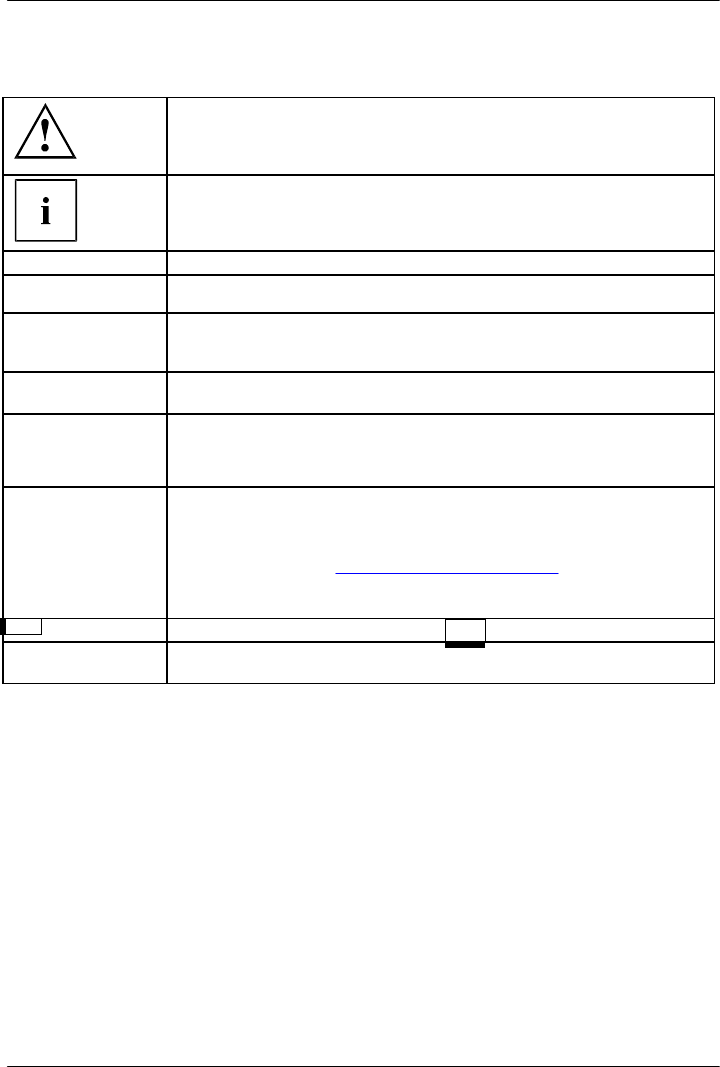
Notational conventions
Notational conventions
Pay particular attention to text marked with this symbol. Failure to observe
this warning will endanger your life, will damage the device or lead to loss
of data. The warranty will be invalidated if the device becomes defective
through failure to observe these warnings.
Indicates important information which is required to use the device properly.
►
indicates an activity that must be performed
4
indicates a result
This style
indicates data entered using the keyboard in a program dialogue or at
the command line, e.g. your password (Name123) or a command used to
start a program (
start.exe
)
This style
indicates information that is displayed on the screen by a program, e.g.:
Installation is complete.
This style
indicates
•
terms and texts used in a software interface, e.g.: Click on Save.
•
names of programs or files, e.g. Windows or setup.exe.
"This style"
indicates
•
Cross-references to another section, e.g. "Safety information"
•
cross-references to an external source, e.g. a web address: For more
information, go to "http://solutions.us.fujitsu.com/"
•
names of CDs, DVDs and titles or designations of other materials, e.g.:
"CD/DVD Drivers & Utilities" or "Safety/Regulations" manual
Key
indicates a key on the keyboard, e.g:
F10
This style
indicates terms and text that are emphasized or highlighted, e.g.: Do not
switch off the device
Fujitsu 9
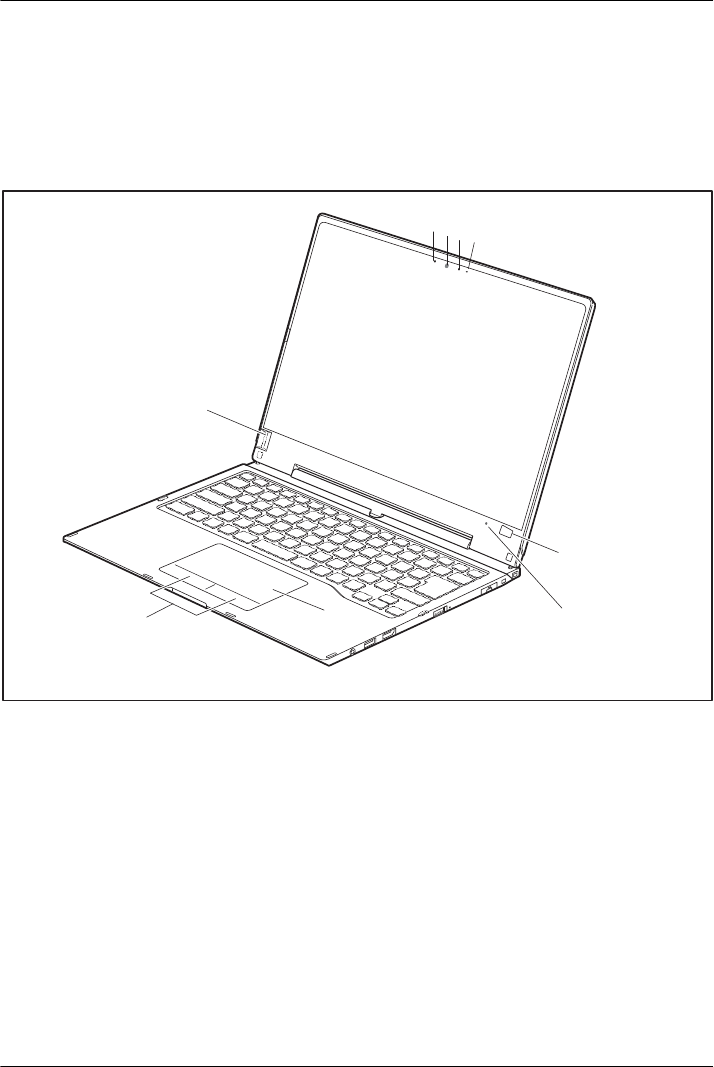
Ports and controls
Ports and controls
This chapter presents the individual hardware components of your device. It gives an
overview of the indicators and connections of the device. Please familiarize yourself
with these items before you start to work with the device.
Notebook open
1
2 3 1
8
4
5
7
6
1 = Microphone
2
= Webcam
3
= Webcam LED
4 = Windows button
5 = Ambient light sensor
6
= Clickpad
7
= Clickpad buttons
8 = Fingerprint sensor
10 Fujitsu
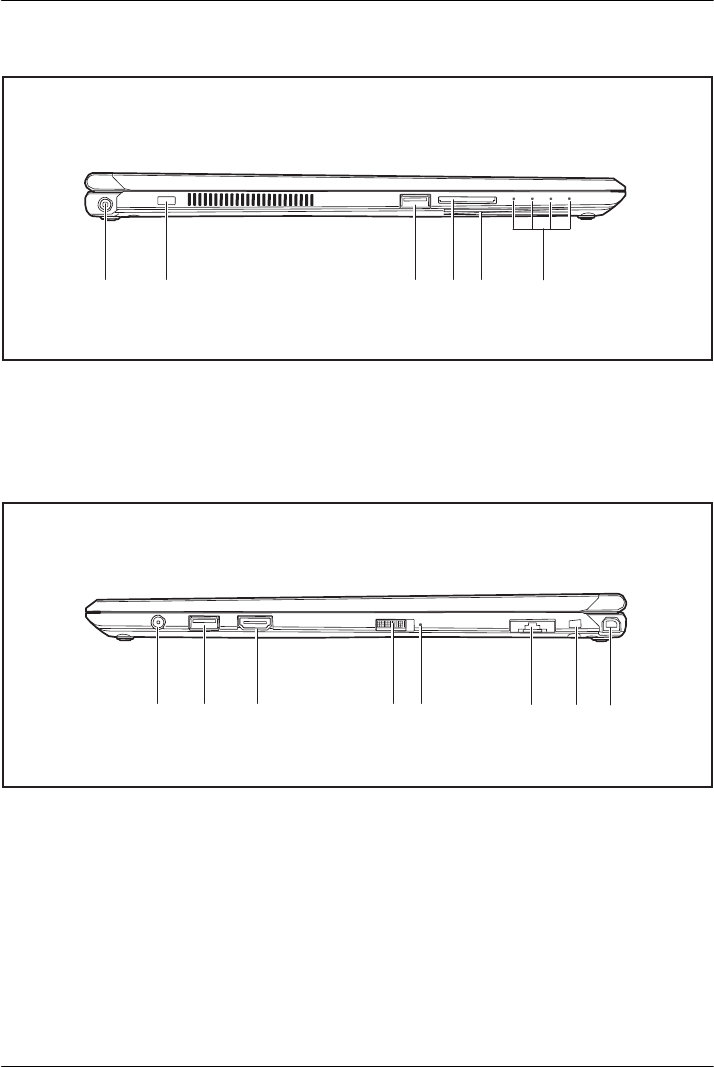
Ports and controls
Left-hand side
1 = DC jack (DC IN)
2 = Security Lock device
3 = USB port with charging function (Anytime
USB charge, USB 3.0)
Right-hand side
4 = Memory card slot
5 = SmartCard reader
6 = Status indicators
1 = Headphones port
2 = USB port 3.0
3 = HDMI port
4 = ON/OFF button
5 = Power-on indicator
6 = LAN connector (removable)
7 = Attachment eye for the stylus tether
8 = Stylus slot
1 2 3 4 5 6 7 8
1 2 3 4 5 6
Fujitsu 11
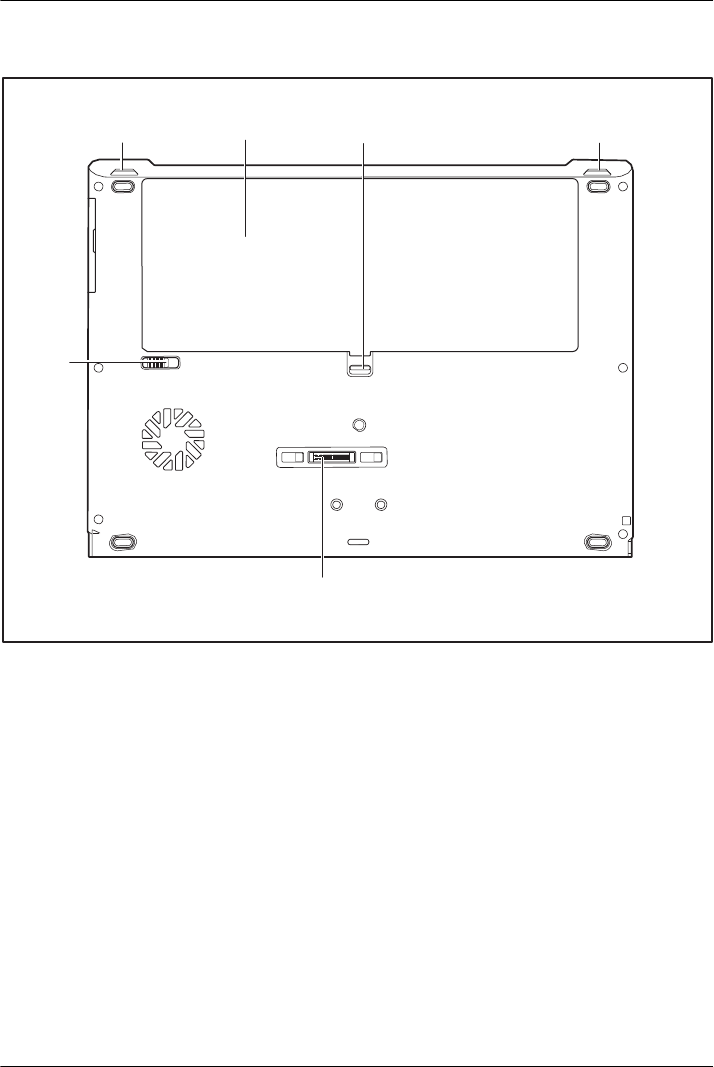
Ports and controls
Bottom
1
2
3
1
3
4
1 = Speaker
2
= Battery compartment with SIM card
slot under the battery
3 = Battery Lock slider switch
4 = Port for port replicator
12 Fujitsu

Important notes
Important notes
This chapter contains essential safety information which must be followed
when working with your notebook. Other notes also provide useful information
which will help you with your notebook.
Safety instructions
Please observe the following safety information.
Please pay special attention to the sections in the manual marked
with the symbol on the left.
When connecting and disconnecting cables, observe the relevant
notes in this operating manual.
Read the information on the ambient conditions in the "Technical data", Page 89
chapter and the "First-time setup of your device", Page 18 chapter before preparing
your notebook for use and switching it on for the first time.
When cleaning the device, please observe the relevant notes in the
section "Cleaning the notebook", Page 17.
Pay attention to the additional safety notes for devices with radio components
provided in the "Safety/Regulations" manual.
Please refer to the notes in the chapter "Removing and installing
components during servicing", Page 77.
When handling this device, you will come into contact with lead, a chemical which in
California is held to be a possible cause of birth defects and other damage to fertility.
Wash your hands after using the device.
This notebook complies with the relevant safety regulations for data processing equipment.
If you have any questions about setting up your notebook in the intended environment,
please contact your sales outlet or our Hotline/Service Desk.
Fujitsu 13

Important notes
Additional safety notes for devices with
radio components
If a radio component (Wireless LAN, Bluetooth, UMTS, 4G) is incorporated in your notebook,
you must be sure to observe the following safety notes when using your notebook:
•
Switch off the radio components when you are in an aircraft or driving in a car.
•
Switch off the radio components when you are in a hospital, an operating room or near a medical
electronics system. The transmitted radio waves can impair the operation of medical devices.
•
Switch off the radio components, when you let the device get near flammable gases
or into hazardous environments (e.g. gas station, paintshops), as the transmitted
radio waves can cause an explosion or a fire.
For further information on how to switch the radio components on and off, refer
to chapter "Switching the wireless components on and off", Page 56.
Energy saving
Switch the notebook off when it is not in use. Switch off any connected external devices when
they are not in use. If you use the energy saving functions, the notebook uses less power. You
will then be able to work for longer before having to recharge the battery.
The energy efficiency is increased and environmental pollution is reduced.
You save money and help protect the environment.
Energy saving under Windows
►Make use of the available energy saving functions as described in chapter
"Using the energy saving functions", Page 52.
14 Fujitsu
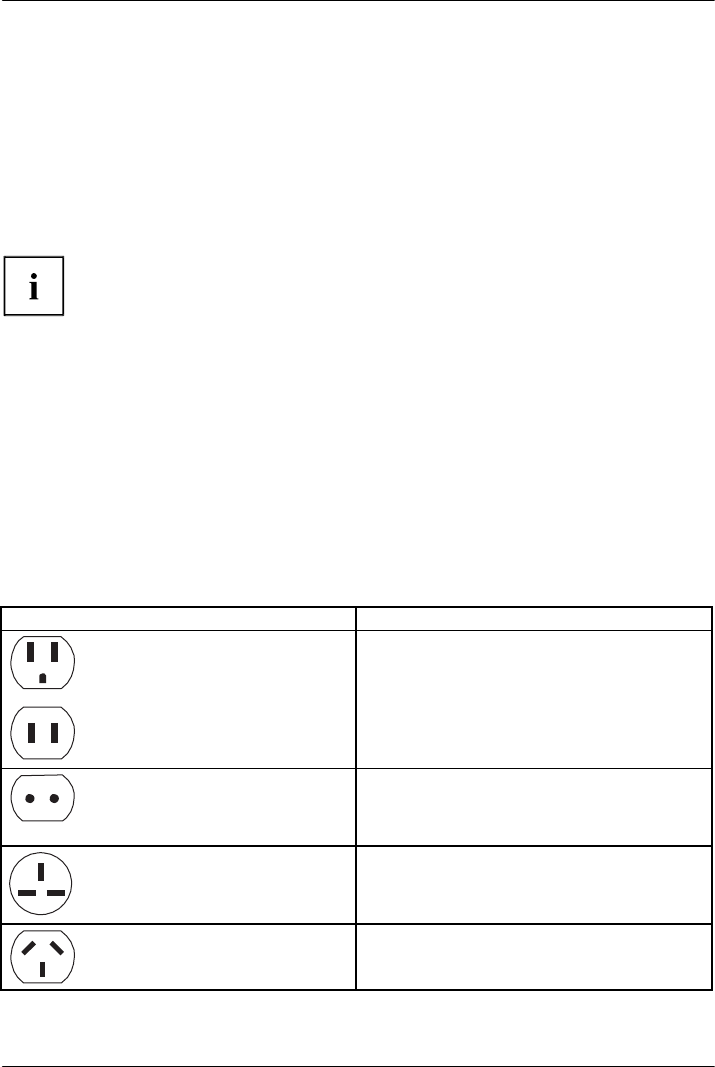
Important notes
Traveling with your notebook
Please observe the points listed below when traveling with your notebook.
Before you travel
►Back up important data stored on your hard disk.
►Switch off the radio component for data security reasons. With data traffic via a wireless
connection, it is also possible for unauthorized third parties to receive data.
Information on activating data encryption is provided in the documentation
for your radio component.
►If you wish to use your notebook during a flight, check with the flight attendants if its use is safe.
When traveling in other countries
►If you are traveling abroad, check that the AC adapter can be operated with the local AC
voltage. If this is not the case, obtain the appropriate AC adapter for your notebook.
Do not use any other converter!
►Check whether the local AC voltage and the AC cable are compatible. If this is not
the case, buy an AC cable that suits the local conditions.
►Enquire with the corresponding government office of the country you will be traveling to,
whether you may use your notebook with its integrated radio component there.
►Take the necessary travel adapters with you when traveling abroad. Check the following
table to see which travel adapters you will need, or ask your travel organizer.
Power connection
Travel destination
United States, Canada, Mexico, parts of Latin
America, Japan, Korea, Philippines, Taiwan
Russia and the Commonwealth of Independent
States (CIS), much of Europe, parts of Latin
America, the Middle East, parts of Africa, Hong
Kong, India, much of south-east Asia
United Kingdom, Ireland, Malaya, Singapore,
parts of Africa
China, Australia, New Zealand
Fujitsu 15

Important notes
Transporting the notebook
Protect the notebook from severe shocks and extreme temperatures
(e.g. direct sunlight in a car).
•
Do not transport your notebook while it is turned on.
•
Carry your notebook with you while traveling. Do not check it in as baggage.
•
Never put your notebook through a metal detector. Have it hand-inspected by
security personnel. You can however put your notebook through a properly
tuned X-ray machine. To avoid problems, place it close to the entrance of
the machine and remove it as soon as possible or have it hand-inspected by
security personnel. Security officials may require you to turn your notebook
on. So make sure you have a charged battery on hand for this.
►Switch the notebook off.
►Unplug the AC plug of the AC adapter and all external devices from the power outlets.
►Disconnect the AC adapter cable and the data cables for all external devices.
►To protect against damaging jolts and bumps, use a suitable notebook
carrying case to transport your notebook.
Storing the notebook
•
If storing your notebook for a month or longer, turn it off, fully charge the battery, then
remove and store all the Lithium Polymer batteries in a suitable location.
•
Store your notebook in a cool dry location. Temperatures should remain
between 13 ºF / -25 ºC and 140 ºF / 60 ºC.
•
Store your notebook and batteries separately. If you store your notebook with a
battery installed, the battery will discharge, and battery life will be reduced. In
addition, a faulty battery might damage your notebook.
•
Always power off the notebook before transporting and/or packaging it.
After shutting down the notebook, wait until the status LED panel indicates
the power-off condition (i.e., no lights are illuminated).
•
It is possible that the notebook may not automatically go to power-off or hibernate
mode when you close the lid. This situation may occur due to pre-operating system
boot password security settings or some other application running on the notebook.
•
Attempting to transport the notebook while power is on may damage
the notebook due to shock or overheating.
16 Fujitsu

Important notes
Cleaning the notebook
•
Use of incorrect cleaners can result in optical impairment of the LCD and / or
damage to the computer. Always refer to the cleaner manufacturer’s guidelines and
material safety data sheets for proper handling and use of the products.
•
Never use ammonia, acidic, or alkaline cleaners or organic chemicals
such as paint thinner, acetone or kerosene. It may damage surface
finishes and the coating of the LCD screen.
•
Never use compressed air for cleaning your computer.
•
If your notebook has a Smart Card slot, be very careful to avoid any
liquid entering the slot as this can damage the unit.
Further information on cleaning the notebook
The notebook does not float.
If the notebook is exposed to water or other liquids with its connections open, liquid
can penetrate the notebook and cause a malfunction. Do not continue to use the
notebook. Switch it off and contact our hotline / our service desk (see enclosed list of
service desks or visit our website at: "http://www.fujitsu.com/us/support/").
Fujitsu 17

First-time setup of your device
First-time setup of your device
Please read the chapter "Important notes", Page 13.
If your device is equipped with a Windows operating system, the necessary
hardware drivers and supplied software are already pre-installed.
Before switching it on for the first time, connect the device to the AC voltage using
the AC adapter, see "Connecting the AC adapter", Page 19. The AC adapter must
remain connected during the whole of the installation process.
A system test is performed when your device is first switched on. Various messages
can appear. The display may remain dark for a short time or may flicker.
Please follow the instructions on the screen.
NEVER switch off your device during the first-time setup process.
On delivery, the battery can be found in the battery compartment or in the accessories kit.
The battery must be charged if you want to operate your device using the battery.
When used on the move, the built-in battery provides the device with the necessary power. You
can increase the operating time by using the available energy saving functions.
For instructions on how to connect external devices (e.g. mouse, printer) to your
device, please refer to the operating manual for your device.
Unpacking and checking the device
If you find that damage has occurred during transport, please notify
your local sales outlet immediately!
►Unpack all the individual parts.
►Check your device for any visible damage which may have occurred during transportation.
You may need to reuse the packaging in the future, for example if
you need to ship your device.
18 Fujitsu
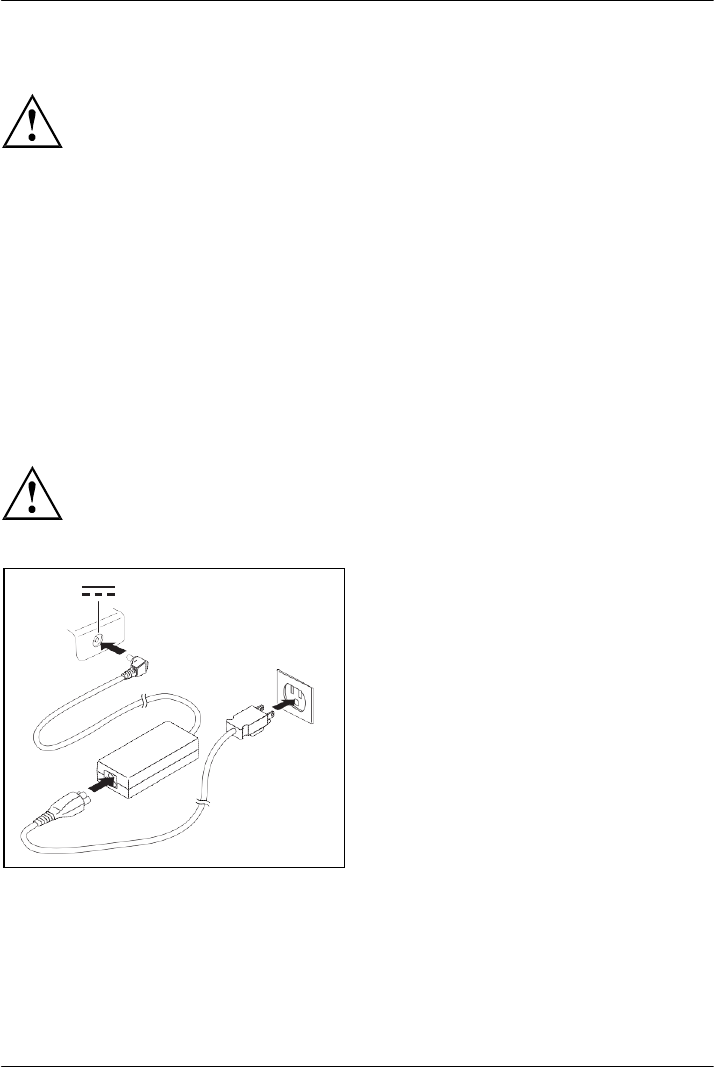
First-time setup of your device
Choose a location
Choose a suitable location for the device before setting it up. In doing
so, please follow these instructions:
•
Never place the device or the AC adapter on a heat-sensitive surface.
The surface could be damaged as a result.
•
Never place the device on a soft surface (e.g. carpeting, upholstered furniture,
bed). This can block the air vents and cause overheating and damage.
•
The underside of the device heats up during normal operation. Prolonged contact
with the skin can become unpleasant or even result in burns.
•
Place the device on a stable, flat, non-slippery surface. Please note that the
rubber feet of the device may mark certain types of delicate surfaces.
•
Keep other objects at least 100 mm / 3.97 inches away from the device
and its AC adapter to ensure adequate ventilation.
•
Never cover the ventilation openings of the device.
•
Do not expose the device to extreme environmental conditions.
Protect the device against dust, humidity and heat.
Connecting the AC adapter
Observe the safety notes in the enclosed "Safety/Regulations" manual.
The supplied AC cable conforms to the requirements of the country in which
you purchased your device. Make sure that the AC cable is approved for
use in the country in which you intend to use it.
►Connect the AC cable (1) to the AC adapter.
►Plug the AC cable (2) into a power outlet.
►Connect the AC adapter cable (3) to the
DC jack (DC IN) of the device.
3
2
1
Fujitsu 19
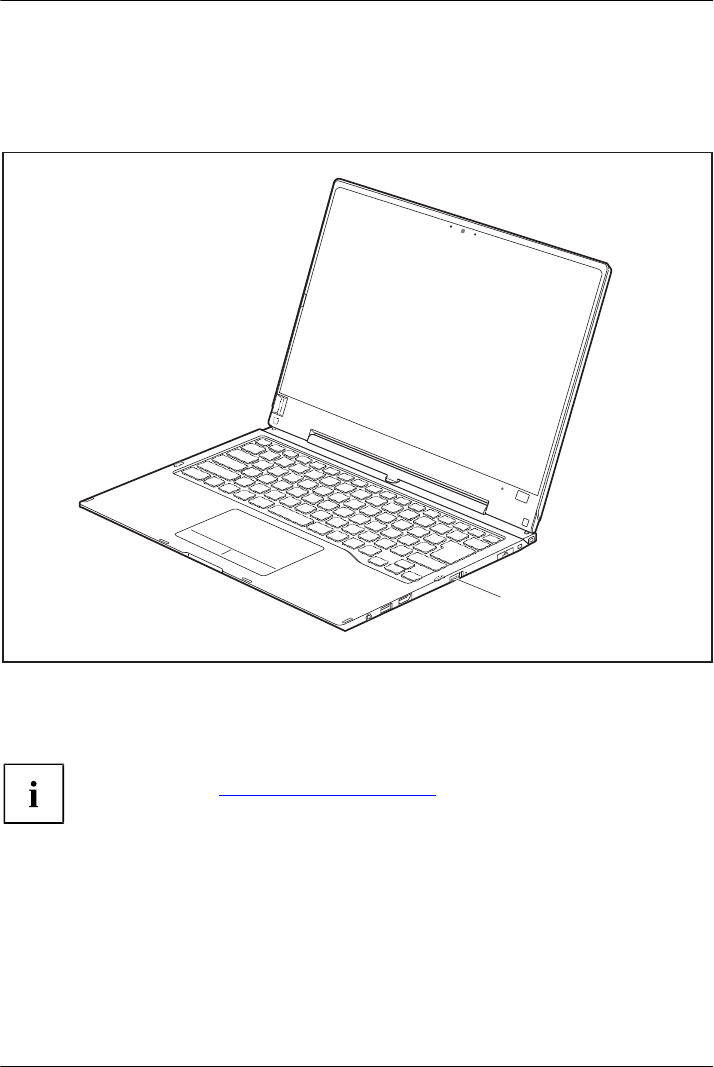
First-time setup of your device
Switching on the device for the first time
To make it easier to use your device for the first time, the operating system
is pre-installed on the hard disk.
1
►
Slide the ON/OFF button (1) to the right to switch on the notebook.
4
The ON/OFF button returns automatically to its original position.
►
During the installation process, follow the on-screen instructions.
You can find information and help on the Windows operating system functions
on the Internet at "http://windows.microsoft.com".
20 Fujitsu

First-time setup of your device
Installing Bonus Apps
After you have started your system the first time, you will see a Bonus Apps icon on your desktop.
►Click on the icon to see which additional applications are available for you to install.
4 Applications that are already installed appear in grey, those that are
available for installation appear in blue.
►Select the applications you wish to install by selecting the checkbox adjacent to your selection.
or
►Click Select All if you would like to install all available applications.
►
To confirm your selection, click Install.
Note that in some cases (depending upon which application was selected for
installation) after installation completes, the system will prompt you to reboot.
There are also cases in which if multiple applications are selected to install
but one of them needs a reboot, the system will reboot and continue
installing the rest of the selected applications.
Fujitsu 21
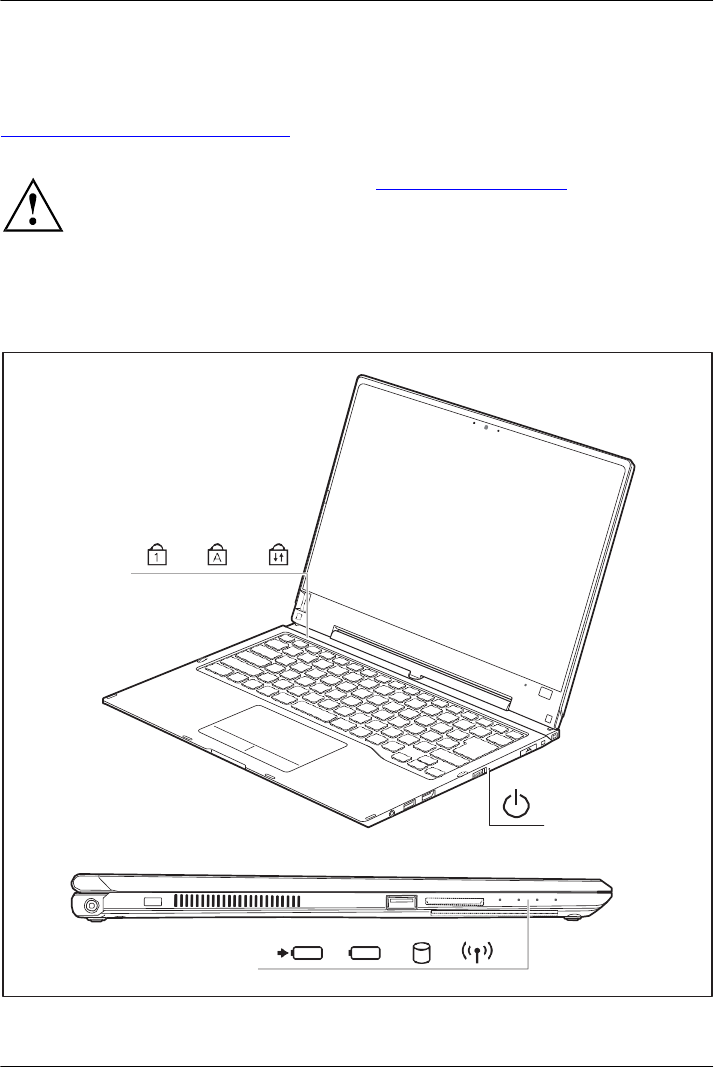
Working with the notebook
Working with the notebook
This chapter describes the basics for operating your notebook. Please refer to
"Connecting external devices", Page 72 for instructions on how to connect external
devices such as a mouse and a printer to the notebook.
Please refer to the notes in the chapter "Important notes", Page 13.
Status indicators
The
status indicators provide information about the status of the power supply,
the drives and the keyboard functions, etc.
22 Fujitsu
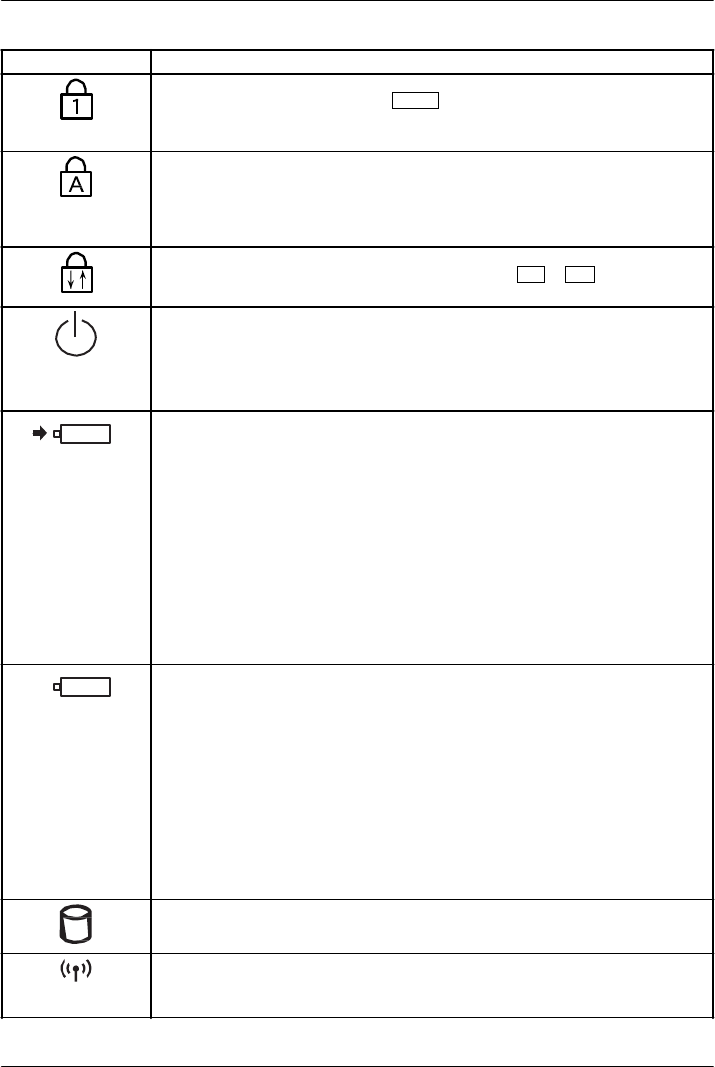
Working with the notebook
FN
Status indicator Description
Num Lock indicator
The indicator is illuminated: The key has been pressed. The virtual
number keys have been activated. You can output the characters indicated
on the upper right of the keys.
Caps Lock indicator
The indicator is illuminated: The Caps Lock key has been pressed. All
characters are displayed in upper case. In the case of overlay keys, the
character printed on the upper left of the key will appear when that key is
pressed.
Scroll Lock indicator
The indicator is illuminated: The key combination
+
has been
pressed. The effect that this key has varies between applications.
Power-on indicator
•
The indicator is illuminated: The notebook is switched on.
•
The indicator flashes: The notebook is in sleep mode (Save-to-RAM).
•
The indicator is not lit up: The notebook is switched off or the notebook is
in Save-to-Disk mode.
Battery charging indicator/AC connection
The charging state of the battery is shown by the rechargeable battery
indicator.
With AC adapter connected:
•
The indicator lights up white: The battery is fully charged.
•
The indicator light is orange: The battery is being charged.
•
The indicator is flashing orange: The AC adapter is connected but
the battery cannot be charged as the battery is too hot or too cold for
charging. The charging process is continued as soon as the battery has
reached a permissible temperature again.
•
Indicator is off: The system is operating under battery power and the AC
adapter is not connected.
Battery indicator
The battery indicator shows the battery charge of the two installed batteries.
•
The indicator lights up white: The battery is between 51% and 100%
charged.
•
The indicator light is orange: The battery is between 13% and 50%
charged.
•
The indicator lights up red: The battery is between 0% and 12% charged.
•
The indicator is flashing orange: The battery state of charge is being
checked (for four seconds after battery installation).
•
The indicator is flashing red: The battery is faulty.
•
The indicator is not lit up: There is no battery installed.
Drive indicator
The indicator is illuminated: The hard disk drive is being accessed.
Radio components indicator
•
The indicator is illuminated: The radio components are switched on.
•
Indicator is off: The radio components are switched off.
Num
Rol
Fujitsu 23
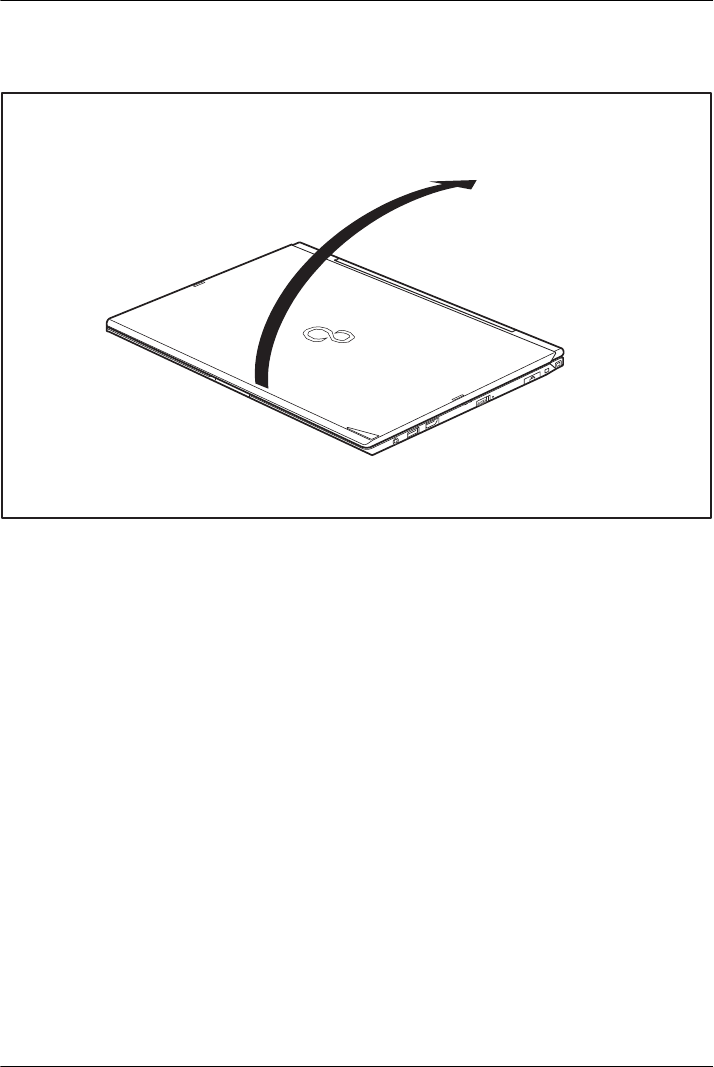
Working with the notebook
Opening the notebook
►Fold the LCD screen upwards.
24 Fujitsu
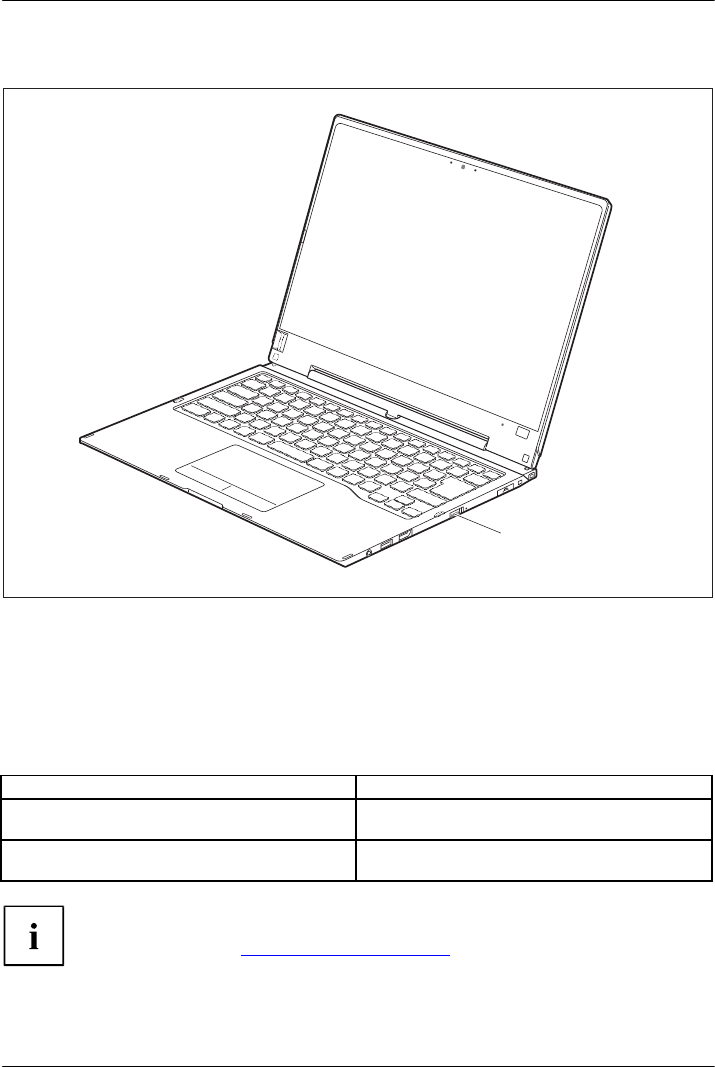
Working with the notebook
1
►
Slide the power ON/OFF button (1) to the right to switch on the notebook.
4
The power ON/OFF button returns automatically to its original position.
The power ON/OFF button (1) lights up whenever the system is switched on.
Programing
the ON/OFF button
You
can program the ON/OFF button:
Switching the notebook on
Operating system
Menu
Windows 7
Start - (Settings) - Control Panel - System and
Security - Power Options
Windows 8.1
Windows 8.1 Desktop - Control Panel - Hardware
and Sound - Power Options
If you have assigned a password, you must enter this when requested to
do so in order to start the operating system. Detailed information can be
found in the chapter "Security functions", Page 64.
Fujitsu 25
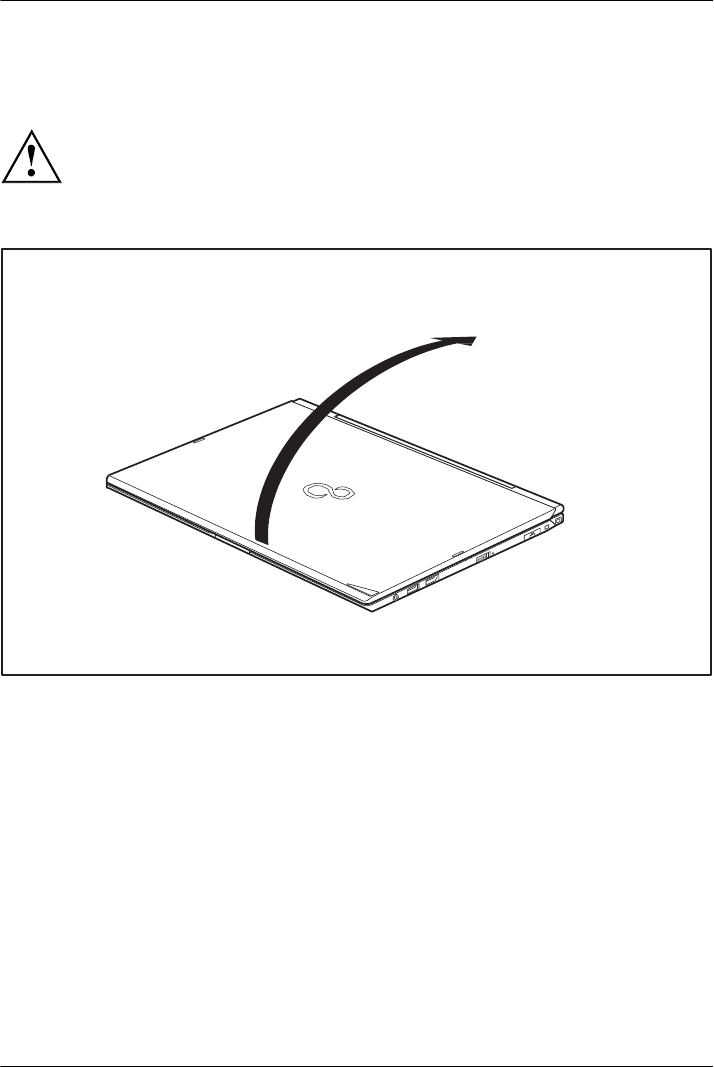
Working with the notebook
Different ways to use your notebook
During your daily work, you can use your notebook as a tablet PC or as a notebook, just as you wish.
Please note that the monitor cannot be turned completely on its own axis! Stop
turning the monitor as soon as you feel resistance. No guarantee services can
be offered for damage caused due to incorrect turning.
From notebook to Tablet PC
►Raise the LCD screen into a vertical position.
26 Fujitsu
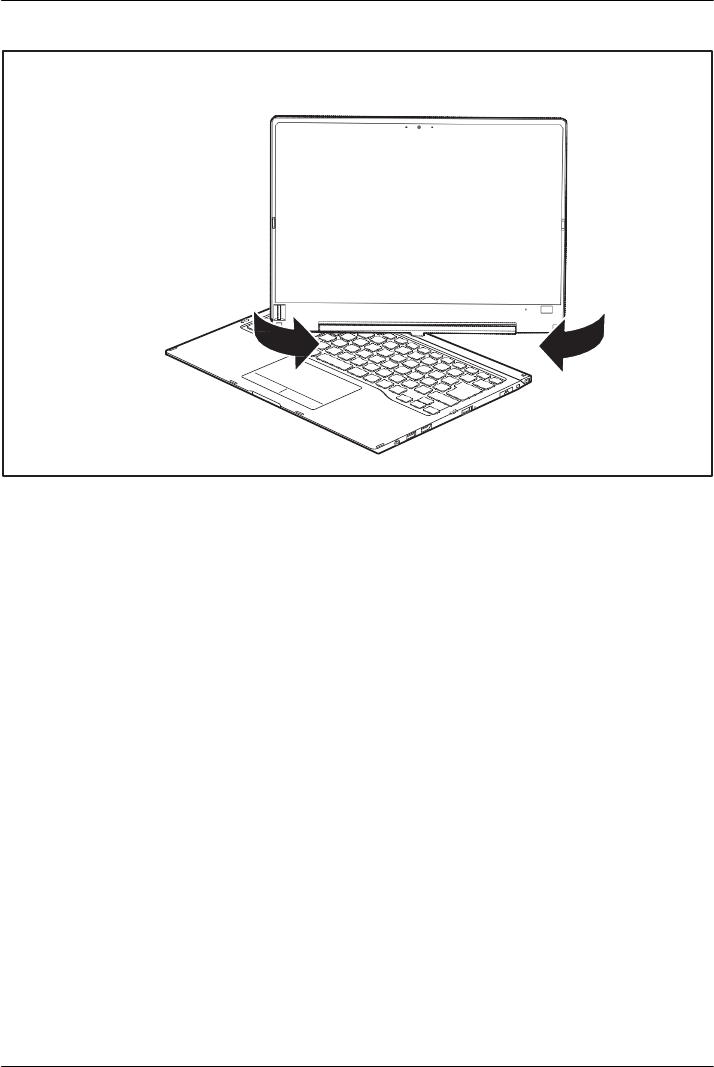
Working with the notebook
►
Hold the screen as low as possible on both sides. Turn the screen to the left
or right in the direction of the arrow. At first you will feel some slight resistance,
then the screen will turn easily and without friction.
►
Turn the screen further until it has turned 180° and the hinge latches in.
Fujitsu 27
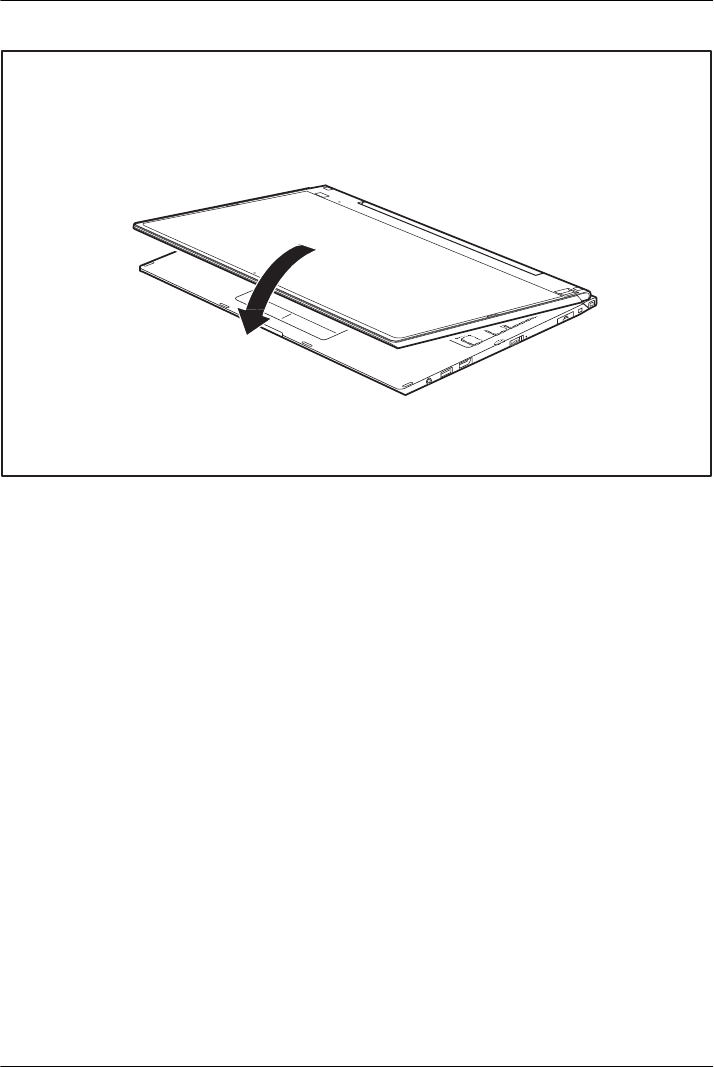
Working with the notebook
►Now fold the screen down until the back of the screen is almost flat on top of the keyboard.
4 The screen is now secured in the tablet position.
28 Fujitsu
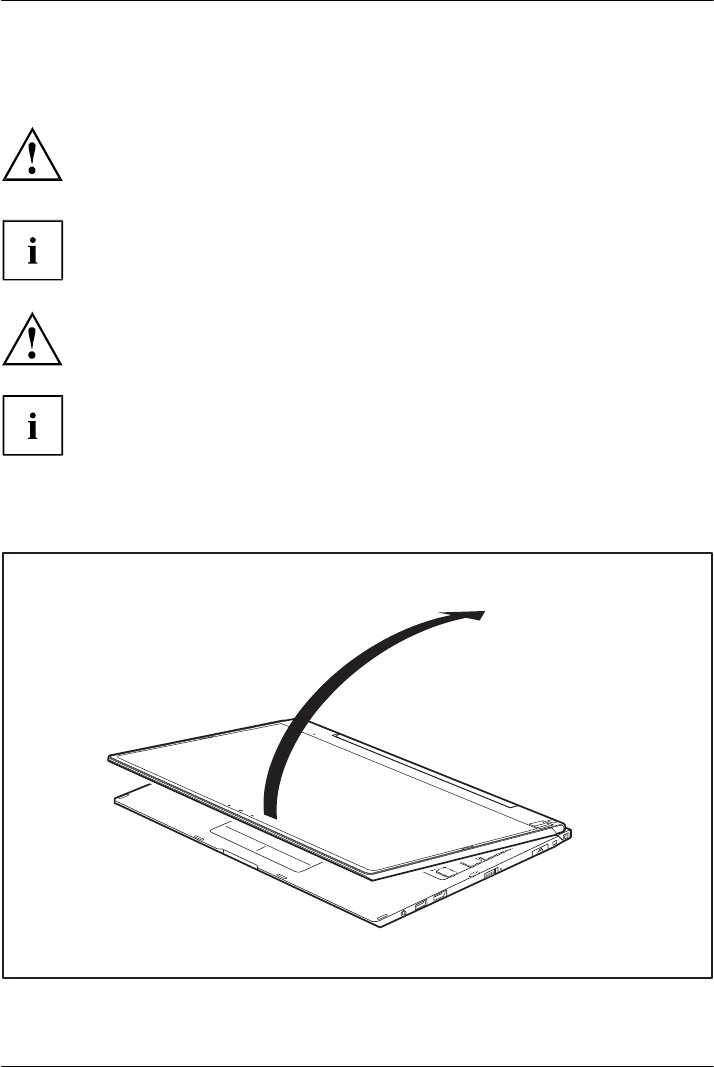
Working with the notebook
Select display orientation (portrait or landscape format)
You can choose to use either portrait or landscape format for the display.
If you have a device with a wireless WAN module installed, note that while holding the
system horizontally with the webcam at the bottom (tablet position and Secondary
Landscape setting), WWAN must not be operated with the antenna open. Operating
the device in this position could result in damage to the WWAN antenna.
►Raise the LCD screen into a vertical position.
Windows 7
You can change these settings in the Fujitsu menu or under Start - (Settings -)
Control Panel - Hardware and Sound - Display - Settings.
Windows 8.1
You can change these settings under Windows 8.1 Desktop - Control Panel -
Hardware and Sound - Windows Mobility Center / Rotate screen.
In the Fujitsu Tablet Controls settings, profiles are saved for operation
with different screen orientations. These profiles have preset standard
configurations that can be modified as desired.
These settings do not just affect the screen settings on the Tablet PC, but
also on external monitors that are connected.
From
Tablet PC to notebook
Fujitsu 29
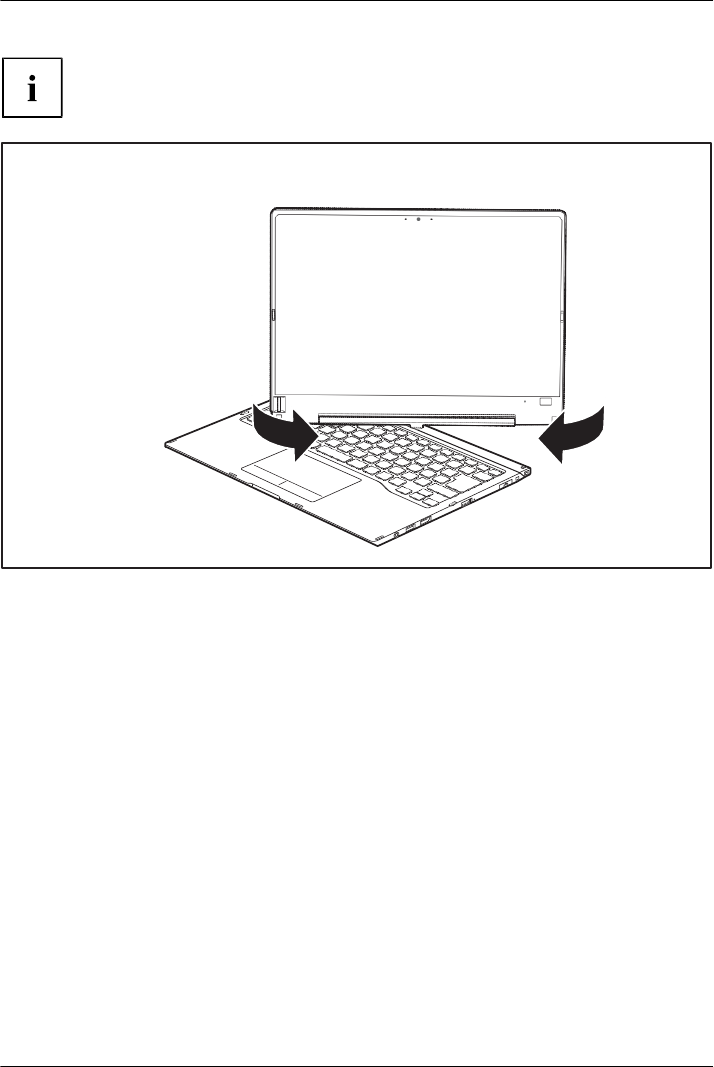
Working with the notebook
Please note that the monitor cannot be turned completely on its own axis! Stop
turning the monitor as soon as you feel resistance. No guarantee services can
be offered for damage caused due to incorrect turning.
►
Hold the screen on both sides as far down as possible and then turn the
screen. It will turn easily and without resistance.
►
Turn or move the screen further until it has turned 180° and the hinge latches in.
Switching
off the notebook
►
Close all applications and then shut down your operating system (please
refer to the "Operating system manual").
►
Slide the power ON/OFF button towards the right.
4
The power ON/OFF button returns automatically to its original position.
30 Fujitsu
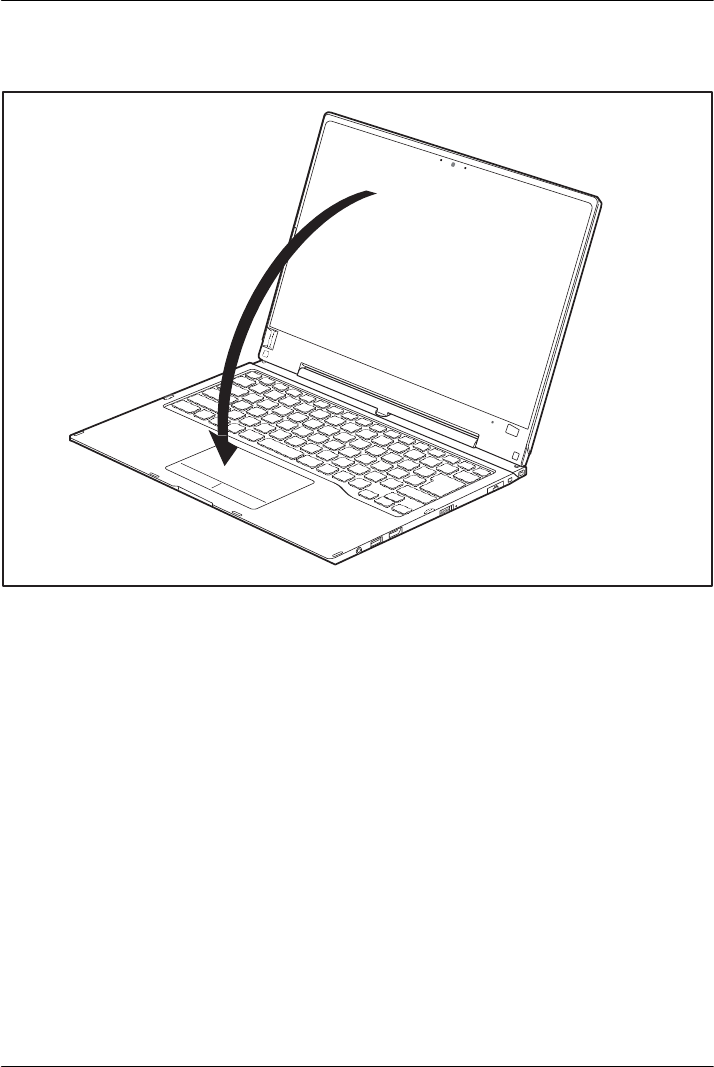
Working with the notebook
Closing the notebook
►
Fold the LCD screen onto the bottom part of the notebook so that it locks into place.
Handwriting
recognition
For
detailed information on handwriting recognition, see the documentation for your operating system.
At
present, handwriting recognition under Windows 7 or Window 8.1 supports the following languages:
English,
German, French, Italian, Japanese, Korean, Chinese (traditional and simplified), Dutch,
Portuguese,
Spanish, Brazilian, Norwegian (Bokmål and Nynorsk), Swedish, Finnish, Danish,
Polish,
Rumanian, Serbian (Cyrillic and Latin script), Catalan, Russian, Czech and Croatian.
Under
Windows 8.1 you can set the required language under Control Panel –
Ti
me, Language and Region – Language.
Fujitsu 31

Working with the notebook
LCD screen
High-quality LCD screens (TFT) are installed in Fujitsu notebooks. For technical reasons,
these screens are manufactured for a specific resolution. An optimal, clear picture can
only be ensured in the resolution intended for the particular screen. A screen resolution
which differs from the specification can result in an unclear picture.
The resolution of the screen of your notebook is optimally set at the factory.
Current production technology cannot guarantee an absolutely fault-free screen display. A few
isolated constantly lit or unlit pixels may be present. The maximum permitted number of such
faulty pixels is specified in the international standard ISO 9241-307 (Class 2).
Example:
A screen with a resolution of 1280 x 800 has 1280 x 800 = 1024000 pixels. Each pixel consists of
three subpixels (red, green and blue), so there are almost 3 million subpixels in total. According to ISO
9241-307 (Class 2), a maximum of 2 light and 2 dark pixels and in addition 5 light or 10 dark subpixels
or an equivalent mix (1 light subpixel counts as 2 dark subpixels) are allowed to be defective.
At a resolution of 1600 x 900 = 1440000 pixels, a maximum of 3 light and 3 dark pixels
and in addition 7 light or 14 dark subpixels are allowed to be defective.
Pixel
A pixel consists of 3 subpixels, normally red, green and
blue. A pixel is the smallest element that can be generated
by complete functionality of the display.
Subpixel
A subpixel is a separately addressable internal structure
within a pixel that enhances the pixel function.
Cluster
A cluster contains two or more defective pixels or
subpixels in a 5 x 5 pixel block.
Background lighting
LCD screens are operated with background lighting. The luminosity of the background
lighting can decrease during the period of use of the notebook. However, you can
set the brightness of your monitor individually.
Synchronizing the display on the LCD screen and an external monitor
For more information, please refer to Chapter "Key combinations", Page 43
under "Switching between screen output".
Ambient light sensor
If your notebook was shipped with a Windows operating system, the screen brightness is
regulated by the ambient light sensor and is dependent on the particular light conditions.
This results in optimum readability and longer battery life at the same time.
Using a device as a tablet PC
You can execute commands as follows:
•
using the stylus (supplied with your device).
•
using your finger
32 Fujitsu
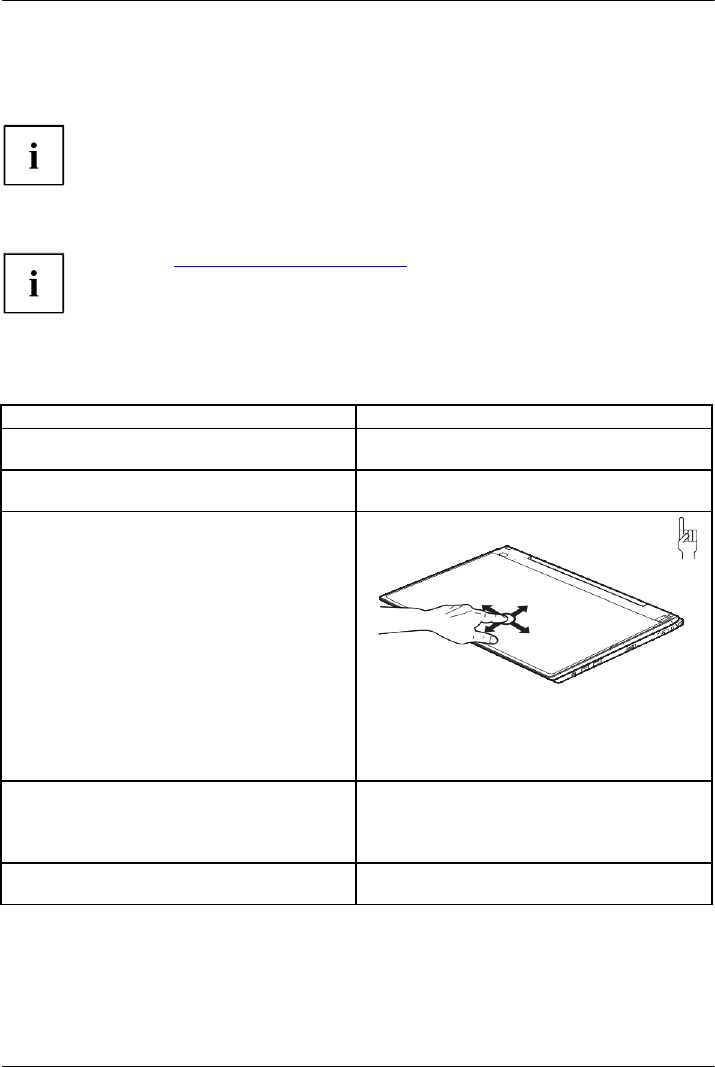
Working with the notebook
Calibrating
the Dual Digitizer for finger-based operation of the device
Please see "Calibrating the stylus", Page 37 for instructions on how to calibrate
your device to use Dual Digitizer Technology.
Please note: There are separate calibration programs available for calibrating
the stylus and for calibrating finger-based operation. Do not use the calibration
tool for the stylus to calibrate finger-based operation.
Actions
with one finger
Using your fingers
You can execute certain commands by using your finger tip on the touchscreen of your device.
Alternatively, everything which you can select or activate using your finger
tip can also be selected or activated using the stylus.
Action
Description
Selecting objects (click with the left mouse
button)
►Tap once briefly on the object with your
finger.
Starting programs (double-click with the left
mouse button)
►Use one finger to tap twice in quick
succession on the program symbol.
Moving objects/windows (while holding the left
mouse button pressed, drag & drop)
►Place a finger on the object/window,
keep your fingertip pressed against
the touchscreen and move the desired
object/window.
Opening a context menu (click with the right
mouse button)
►Tap on the desired item with your finger.
Keep your fingertip pressed against the
touchscreen.
The context menu appears.
Moving the cursor
►Position one finger on the touchscreen and
move the finger in the desired direction.
Fujitsu 33
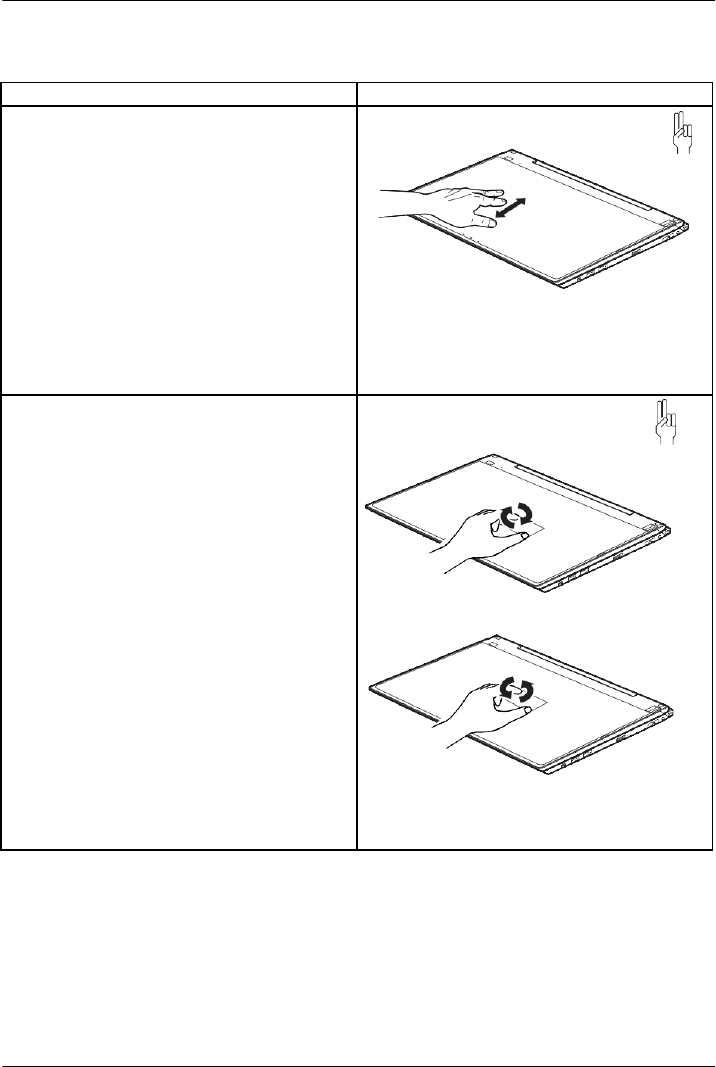
Working with the notebook
Actions using two fingers
Action
Description
Scrolling
►Place two fingers on the touchscreen.
►Move the fingers up to scroll up.
or
►Move the fingers down to scroll down.
Rotating
►Position your thumb on the touchscreen and
rotate the image clockwise or anticlockwise
using your index finger.
34 Fujitsu

Working with the notebook
Action
Description
Increasing or decreasing view
►Place two fingers on the touchscreen and
move them apart to increase the size of the
view.
or
►Place two fingers on the touchscreen and
move them together to decrease the size
of the view.
Locking context-sensitive menus
►Use two fingers to tap twice in quick
succession on the touch screen.
Fujitsu 35
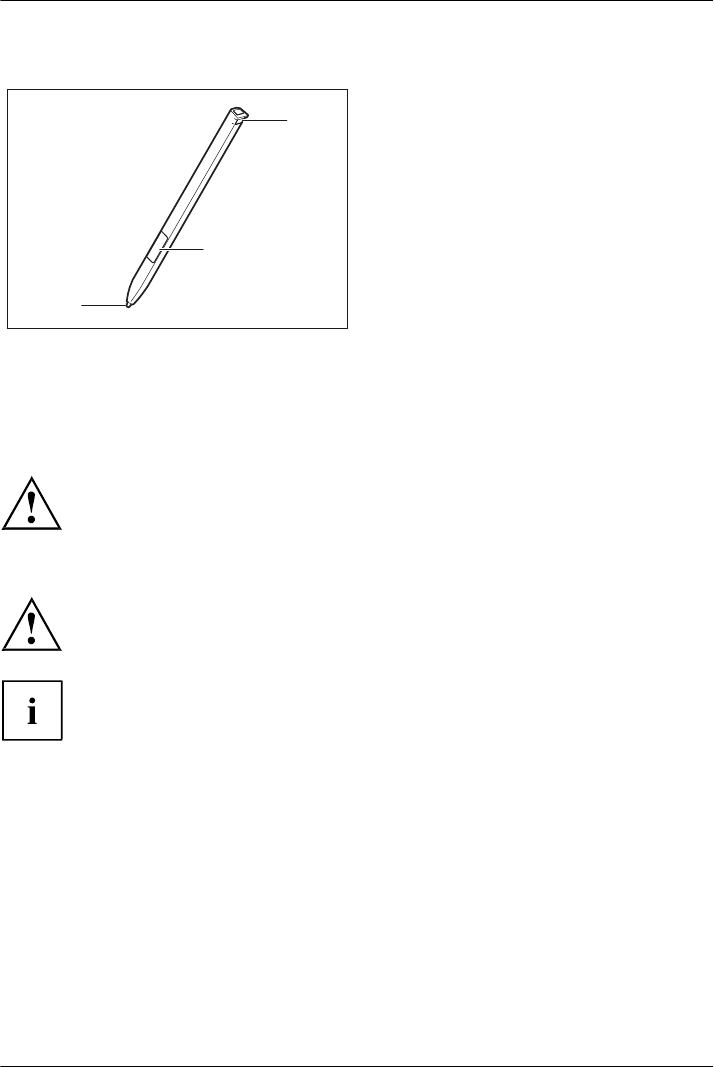
Working with the notebook
Using the stylus
1 = stylus tip
2 = stylus button (right mouse button)
3 = eyelet for stylus tether
You can use the stylus on your Tablet PC as an electronic writing tool, to select menu items and to
navigate through the programs. Programs that support handwriting recognition also allow you to
write directly on the screen with the stylus. You can also use the stylus as a drawing tool.
The Tablet PC is supplied with a stylus tether which you can attach to the
eyelets on the stylus and on the Tablet PC.
Use only the stylus that was provided with your Tablet PC. Do not use any other pointed
object as a substitute, that was not specially designed for your Tablet PC. Replace
the stylus tip if it is worn. The warranty does not cover a scratched screen.
While writing, take care that you do not scratch the surface of the
display (e.g. with a wristwatch or bracelet).
To prevent the pen from getting stuck in the pen slot, always make sure to insert the pen
into the pen slot in the correct direction (flat part facing the lower side of the Tablet PC).
The stylus of the Tablet PC is an electronic instrument that can be damaged
if used improperly. Handle the stylus with care.
Our recommendations for proper handling of the stylus are as follows:
•
Do not gesture with the stylus.
•
Do not use the stylus as a pointer.
•
Do not use the stylus on surfaces other than the screen of the Tablet PC.
•
Do not try to turn the grip of the stylus. The grip is used to put the
stylus into its slot and to take it out of its slot.
•
Never store the stylus with its weight on the tip (e.g. with the tip down in a stylus
container). If the stylus is stored with the tip pointing down, this may have an
adverse effect on the stylus mechanism (particularly under high temperatures). In
this case the stylus tip may react as though it is constantly being pressed down. To
avoid damage, the stylus should be stored in the stylus slot when not in use.
The stylus can be influenced by electromagnetic fields (cursor quivers or
jumps). There may be a few areas on the screen where the cursor quivers
slightly in spite of pressing the stylus down firmly.
3
2
1
36 Fujitsu

Working with the notebook
Adjusting the stylus
Calibrating the stylus
You
must calibrate it with the stylus before first use, so that it recognizes
the
stylus as accurately as possible.
You
should also always repeat the calibration if the coordination between the
stylus and the cursor movement deteriorates.
The screen responds to entries made with the tip of the finger or the stylus when the
tip of the finger or the stylus directly touches the screen.
You can use the stylus to perform almost all functions for which you would otherwise use a mouse.
Delete functions are not supported by the stylus.
Action
Mouse
Stylus
Selecting menu
items
Click with the left mouse button.
Tap on the menu entry with the tip of
the stylus.
Starting programs
Double-click with the left mouse
button.
Tap on the program symbol twice in
rapid succession using the stylus tip.
Moving an object
or window
Drag with the left mouse button
pressed.
Place the stylus tip directly on the
object or window. Keep the stylus tip
held against the screen. Drag the
desired object or window.
Opening a context
menu
Click with the right mouse button.
Tap on the desired element with the
stylus and keep the stylus pressed
against the screen.
Moving the cursor
Move the mouse
Place the tip of the stylus directly on
the screen.
Operating system
Menu
Windows 7
Under Hardware and Sound - Pen and Input Devices, you can make various
settings for the stylus in the control panel (assignment and function of
the stylus button).
Windows 8.1
Under Windows 8.1 Desktop - Control Panel - Hardware and Sound - Pen and
Input Devices you can make various settings for the stylus (assignment
and function of the stylus button).
Operating system
Menu
Windows 7 /
Windows 8.1 Desktop
To calibrate, run the Hardware and Sound / Tablet PC Settings function in the
Control Panel. You need to calibrate both portrait and landscape formats.
Fujitsu 37

Working with the notebook
Securing a stylus tether
You
can secure the stylus with a stylus tether to prevent accidentally dropping it or losing it.
►
Secure the end of the stylus tether with the smaller loop to your stylus.
►
Secure the end of the stylus tether with the larger loop to your notebook.
38 Fujitsu
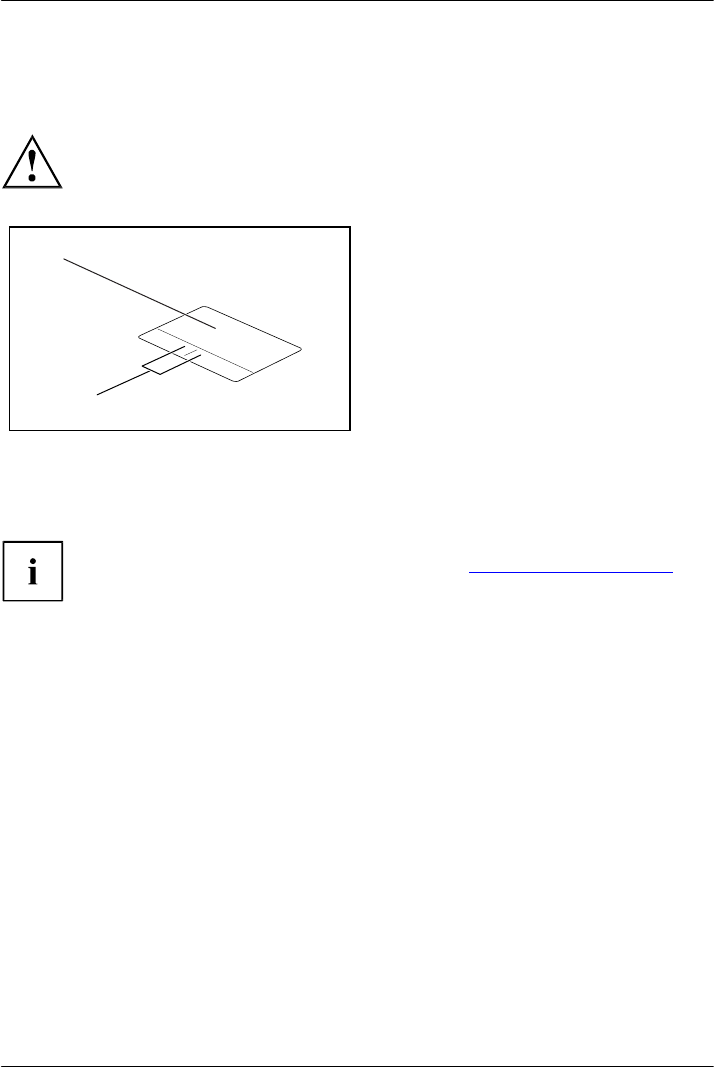
Working with the notebook
1
2
Using the device as a notebook
Clickpad and Clickpad buttons
Keep the Clickpad clean. Protect it from dirt, liquids, and grease.
Do not use the Clickpad if your fingers are dirty.
Do not rest heavy objects (e.g. books) on the Clickpad or the Clickpad buttons.
1 = Clickpad
2 = Clickpad buttons
The Clickpad enables you to move the mouse pointer on the screen.
The Clickpad buttons allow the selection and execution of commands. They
correspond to the buttons on a conventional mouse.
You can also deactivate the Clickpad via a keyboard shortcut, so that you cannot move
the pointer on the screen unintentionally (see chapter "Key combinations", Page 43).
Moving the pointer
►Move your finger on the Clickpad.
4 The pointer will move.
Selecting an item
►Move the pointer to the item you wish to select.
Clickpad
►Tap the Clickpad once or press the left button once.
4 The item is selected.
Executing commands
►Move the pointer to the field you wish to select.
►Tap the Clickpad twice or press the left button twice.
4 The command is executed.
Fujitsu 39

Working with the notebook
Dragging items
►Select the desired item.
►Press and hold the left button and drag the item to the desired position
with the finger on the Clickpad.
4 The item will be moved.
Switching the Clickpad on and off
You can switch the Clickpad on and off using a key combination,
see "Key combinations", Page 43.
40 Fujitsu
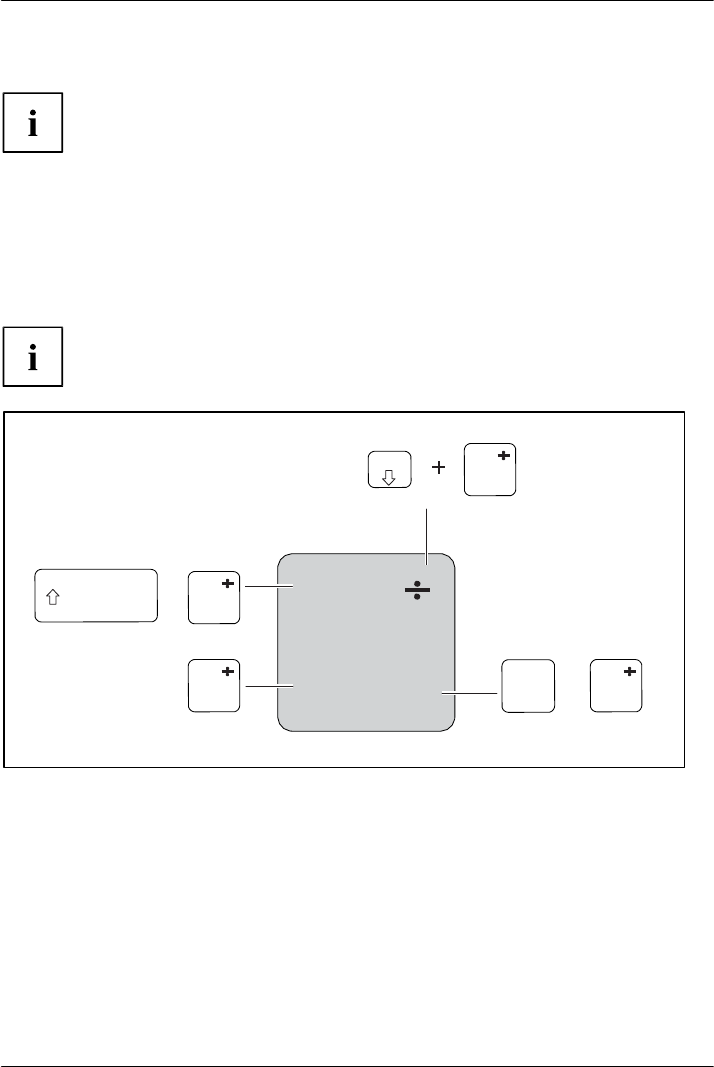
Working with the notebook
=
Keyboard
The keyboard of your notebook is subject to continuous wear through normal
use. The key markings are especially prone to wear. The key markings are
liable to wear away over the life of the notebook.
The keyboard has been designed to provide all the functions of an enhanced keyboard.
Some enhanced keyboard functions are mapped with key combinations.
The following description of the keys applies to the Windows operating system. Additional functions
supported by the keys are described in the relevant manuals supplied with your application programs.
The following illustration shows how to access the different characters on keys with overlaid
functions. The example applies when the Caps Lock key has not been activated.
The illustration may differ from your device variant.
Num =
0
}
+ ==
0
}
=
0
}
}
Alt Gr + 0}
0
Fujitsu 41
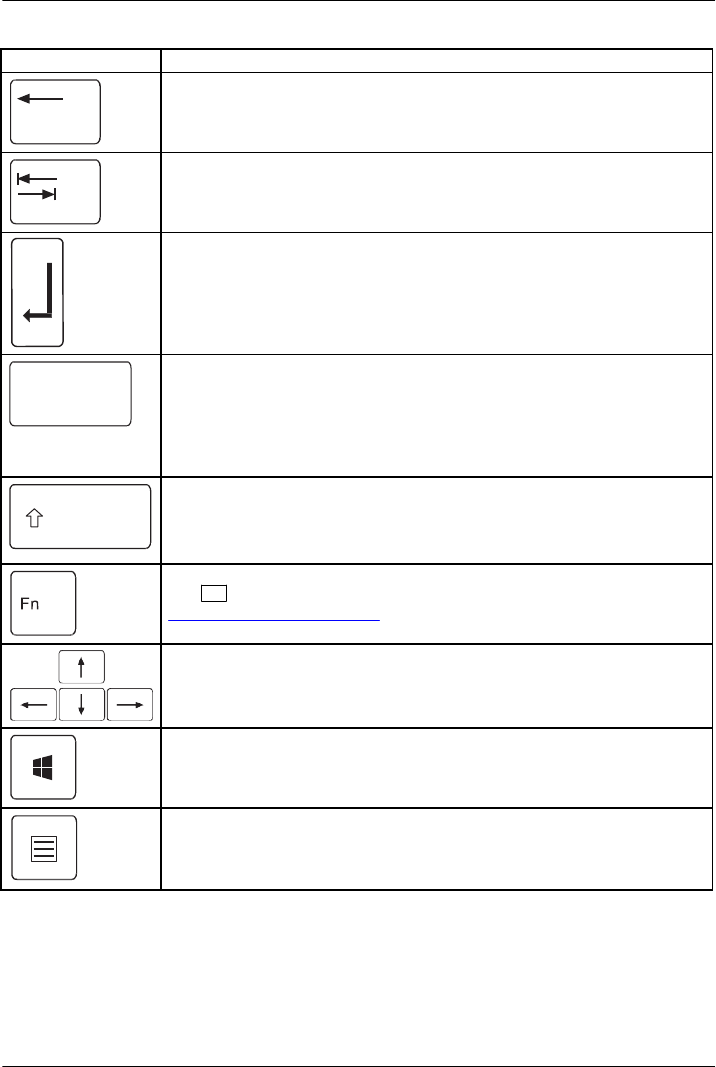
Working with the notebook
Key
Description
Backspace key
The Backspace key deletes the character to the left of the cursor.
Tab key
The Tab key moves the cursor to the next tab stop.
Enter key (return)
The Enter key terminates a command line. The command you have entered
is executed when you press this key.
Caps Lock
Caps Lock key
The Caps Lock key activates uppercase mode. In Caps Lock mode, all of
the characters you type appear in upper case. In the case of overlay keys,
the character printed on the upper left of the key will appear when that
key is pressed. To cancel the Caps Lock function, simply press the Caps
Lock key again.
Shift
Shift key
The Shift key causes uppercase characters to appear. In the case of overlay
keys, the character printed on the upper left of the key will appear when
that key is pressed.
Fn key
The Fn key enables the special functions indicated on overlay keys (see
"Key combinations", Page 43).
Cursor keys
The cursor keys move the cursor in the direction of the arrow, i.e. up, down,
left, or right.
Curr ssoorr k co enys tr ol
Windows key
The Windows key switches between the start screen and the last used
application.
Windows k
Menu key
The Menu key opens the menu for the active application.
42 Fujitsu
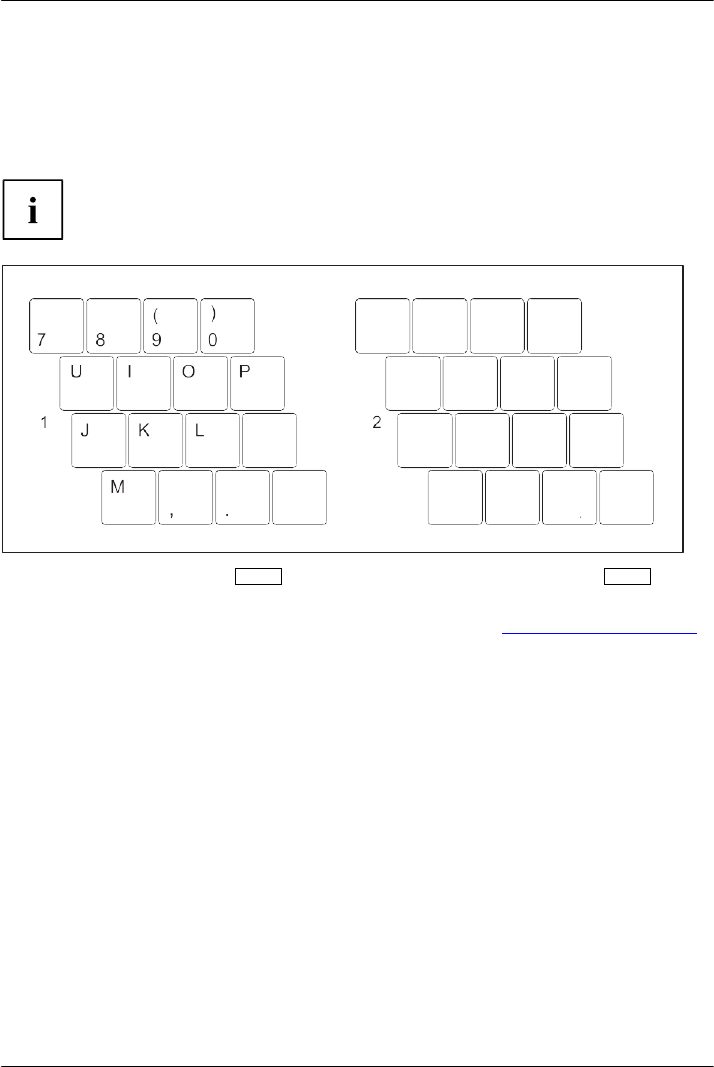
Working with the notebook
Virtual number keys
Virtual number keys are provided so that the keys of a number keypad can be used for certain
applications. The virtual number keys are recognizable on the keyboard by the numbers and
symbols printed in the upper right corner of each key. If you have switched on the virtual number
keys, you can output the characters shown on the upper right of the keys.
The key assignment shown below may be different from the
keyboard layout of your device.
1 = Character valid when the
key is not active 2 = Character valid when the
key is active
Further information about the status indicators can be found in chapter "Status indicators", Page 22.
Country and keyboard settings
►Make the country and keyboard settings as described in the documentation for your operating
system.
Key combinations
The following description of key combinations applies to Windows operating systems. Some of the
following key combinations may not function in other operating systems or with certain device drivers.
Other key combinations are described in the relevant manuals supplied
with your application programs.
Key combinations are entered as follows:
►Press the first key in the combination and keep it pressed.
►While holding the first key down, press the other key or keys in the combination.
/
?
/
>
<
+
3
2
1
:
;
6
5
4
9
8
7
*
&
Num
Num
Fujitsu 43
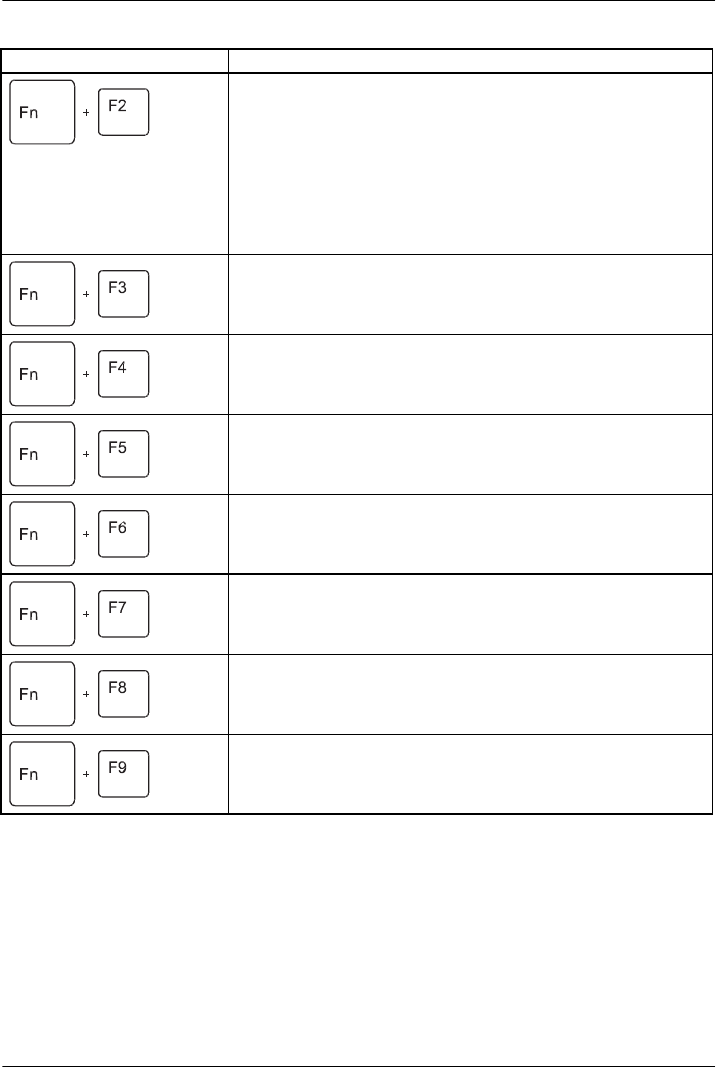
Working with the notebook
Combination
Description
Activate/deactivate keyboard backlight
On backlit keyboards, this key combination activates or deactivates
the backlight.
Sequence:
•
Background lighting off
•
Low brightness
•
High brightness
•
Background lighting off
Switching the speakers on and off
This key combination switches your notebook’s speakers off and
on.
Activate/deactivate mouse and Clickpad buttons
This key combination switches the Clickpad and the Clickpad
buttons on or off.
Wireless components
This key combination switches the wireless components off or on.
Decreasing the screen brightness
This key combination decreases the brightness of the screen.
Increasing the screen brightness
This key combination increases the brightness of the screen.
FSncr+eFe7nbrightness
Decrease the volume
This key combination reduces the volume of the internal speakers.
FVonl+uF m 8e
Increase volume
This key combination increases the volume of the internal
speakers.
44 Fujitsu
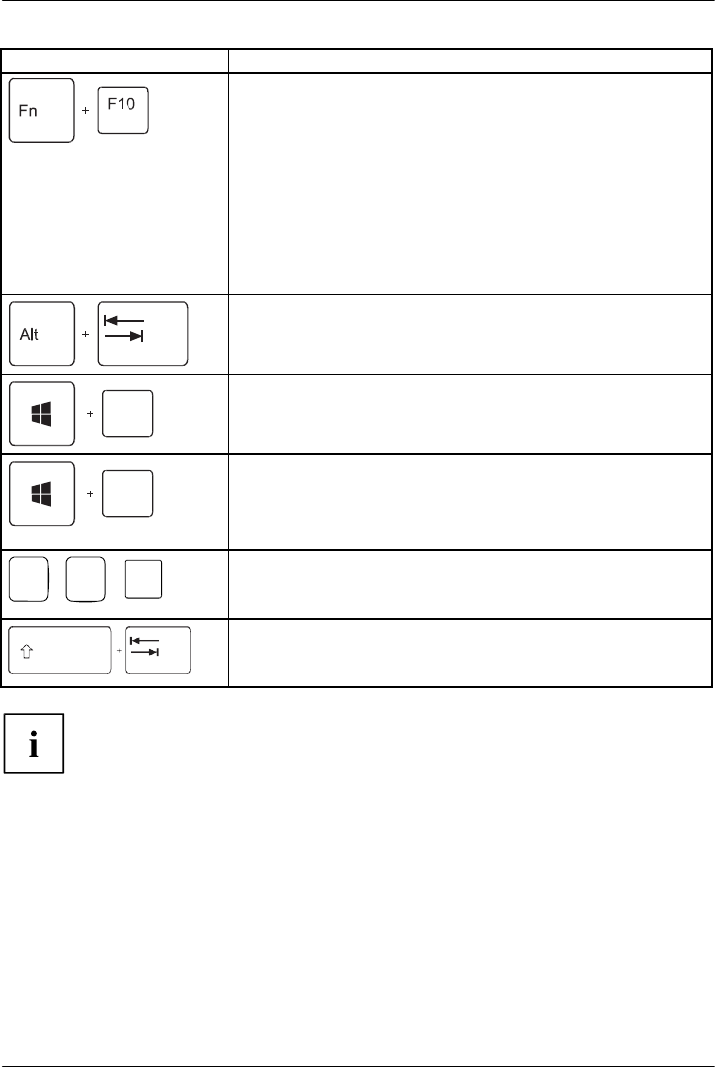
Working with the notebook
Key combinations using the Windows keys are detailed in the manual
for your operating system.
Combination
Description
Switching between screen outputs
Use this key combination to select which screen(s) is/are used for
display if an external monitor is connected.
The screen output is possible in the following sequence:
•
only on the notebook’s LCD screen
•
on the LCD screen of the notebook and the external monitor
at the same time
•
only on the external monitor
This setting is useful if you would like a high resolution and a
high refresh rate on an external monitor.
Switch between open applications
Use this key combination to switch between several open
applications.
D
Switching over to Windows 8 Desktop (Windows 8 only)
With this key combination, you can switch from Windows 8 Modern
to Windows 8 Desktop.
M
Switching over to Windows 8 Desktop and minimizing
applications (Windows 8 only)
With this key combination, you can switch from Windows 8
Modern to Windows 8 Desktop and at the same time minimize
the applications.
Ctrl + Alt + Del
Windows security/Task-Manager
This key combination opens the Windows Security/Task Manager
window.
Alt+Del
Shift
Back tab
This key combination moves the cursor back to the previous tab
stop.
Fujitsu 45
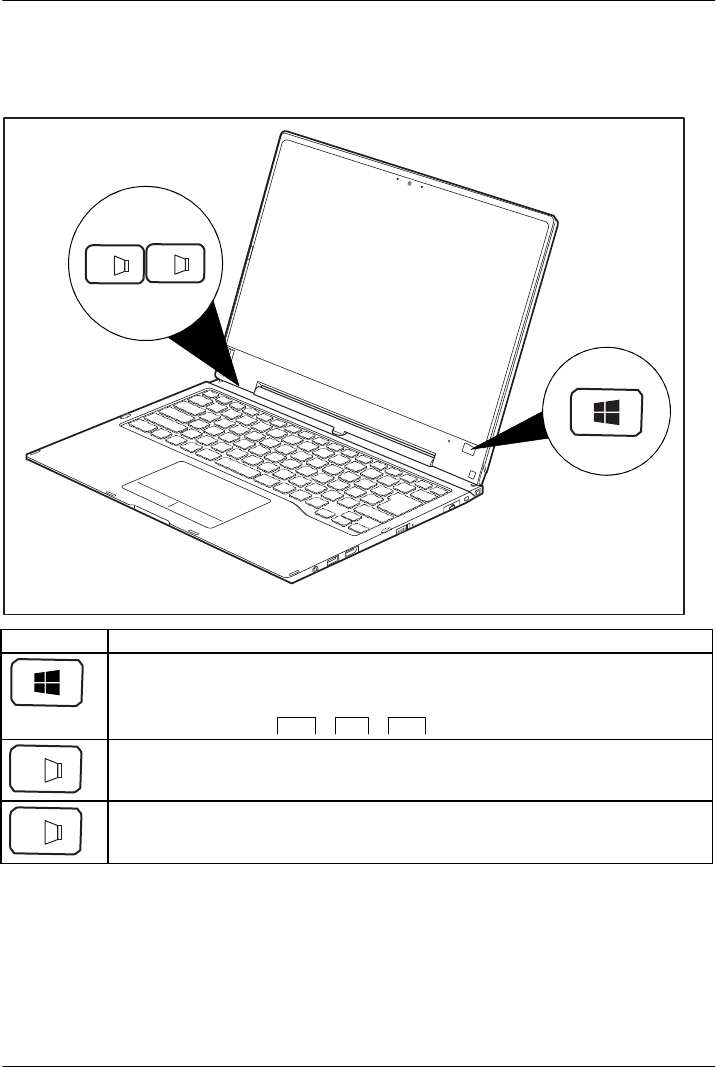
Working with the notebook
+
_
Tablet buttons
Your notebook is equipped with a Windows button and two volume buttons.
Button
Function
Windows button
This button has the same function as the Windows Start key on the keyboard.
If the button is pressed in combination with the power ON/OFF button, the function
is the same as for the Ctrl + Alt + Del key combination.
+
Increase volume
This button increases the volume of the internal speakers.
_
Decrease the volume
This button decreases the volume of the internal speakers.
46 Fujitsu

Working with the notebook
Webcam
Depending on the software used, you can use your webcam to take pictures,
record video clips or take part in web chats.
The webcam has its own status indicator. The indicator lights up when the webcam is active.
•
The picture quality depends on the lighting conditions and the software being used.
•
You can only operate the webcam with a particular application (e.g. an Internet telephony
program or a video conferencing program which supports a webcam).
•
When using the webcam, the notebook base must not wobble.
•
The webcam automatically adjusts itself to the current light level. For this reason
the LCD display may flicker while the light level is adjusted.
Further information on use of the webcam and additional settings for your webcam
can be found in the help function of the program using the webcam.
Fujitsu 47

Working with the notebook
Rechargeable battery
During mobile use, the notebook runs on its built-in battery. You can increase the
service life of the battery by caring for the battery properly. The average battery
service life is around 800 charge/discharge cycles.
You can extend the battery service life by taking advantage of the available energy saving functions.
Charging, caring for and maintaining the battery
The notebook battery can only be charged if the ambient temperature is between
5°C / 41°F and a maximum of 35°C / 95°F.
You can charge the battery by connecting the notebook to the AC adapter
(see "Connecting the AC adapter", Page 19).
If the battery is running low you will hear a warning alarm. If you do not connect the AC adapter
within five minutes of the warning alarm described above, your notebook will automatically switch off.
Monitoring the battery state of charge
Windows also has a "Battery charge meter" in the taskbar for monitoring the
battery capacity. When you place the mouse pointer on the battery symbol, the
system displays the state of charge of the battery.
Battery storage
The battery should be stored in a dry environment at a temperature between 0°C / 32°F and
30°C / 86°F. The lower the storage temperature, the lower the rate of self-discharge.
If you will be storing batteries for a longer period (more than two months),
the battery charge level should be approx. 30%. To prevent exhaustive
discharge which would permanently damage the battery, check the level
of charge of the battery at regular intervals.
To be able to make use of the optimum capacity of the battery, you should allow
the battery to fully discharge and then recharge it.
If you will not use batteries for long periods, remove them from the
notebook. Never store batteries in the device.
Removing and installing the battery
Only use batteries approved by Fujitsu for your notebook.
Never use force when fitting or removing a battery.
Make sure that no foreign bodies get into the battery connections.
Never store a battery for long periods in the discharged state. This
can make it impossible to recharge.
48 Fujitsu

Working with the notebook
Removing a battery
Please observe the safety information in chapter "Important notes", Page 13.
Remove the power plug from the power outlet!
►Switch the device off.
The device must not be in energy saving mode.
►Close the LCD screen.
►
Remove all the cables from the device.
►
Turn the device over and place it on a stable, flat and clean surface. If necessary, lay an
anti-slip cloth on this surface to prevent the device from being scratched.
Fujitsu 49
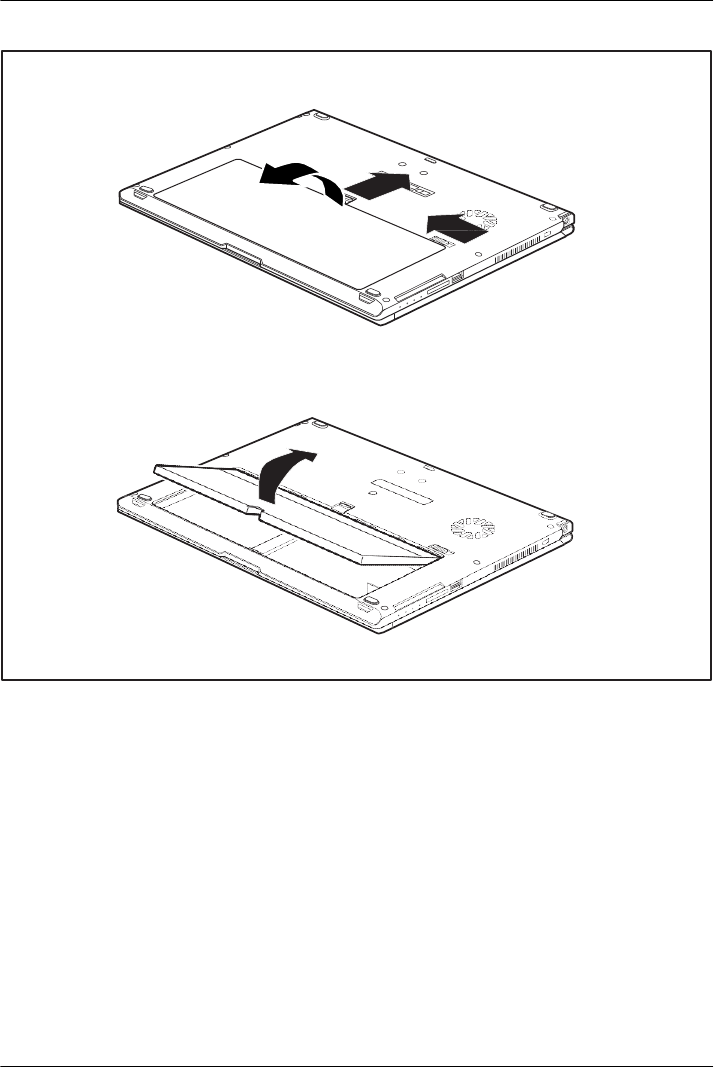
Working with the notebook
3
1
2
4
►
Slide the Battery Lock slider switch in the direction of the arrow (1) and hold it in place.
►
Slide the Battery Lock slider switch in direction of the arrow (2).
►
Remove the battery compartment cover (3).
►
Remove the battery from the battery compartment (4).
50 Fujitsu
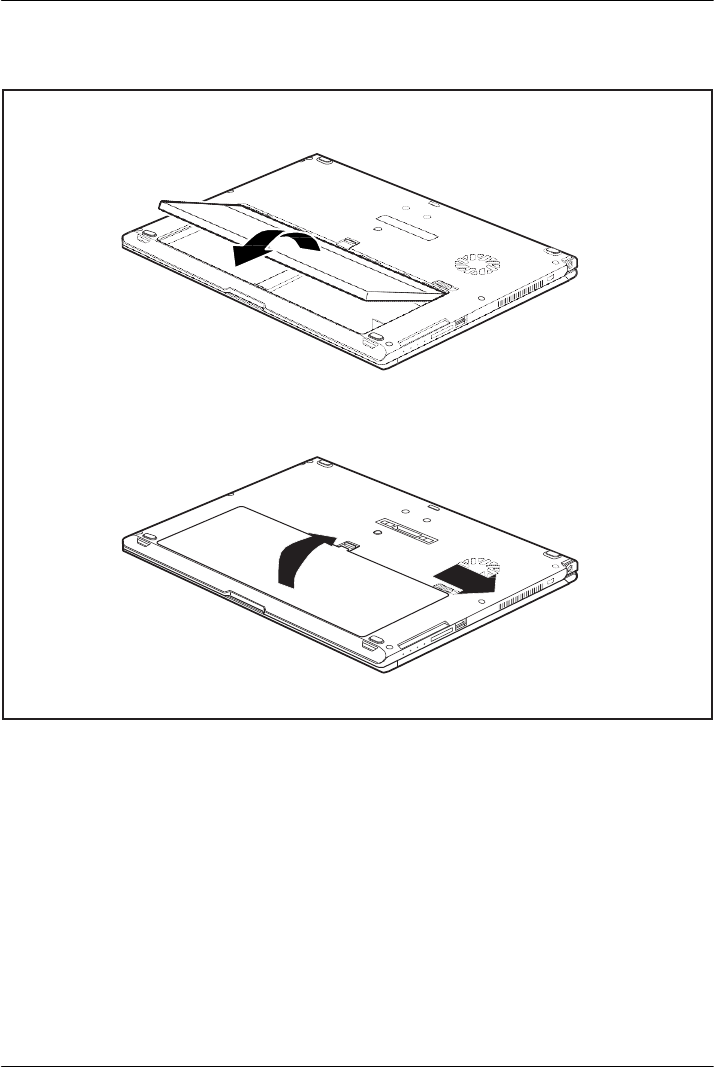
Working with the notebook
Installing a battery
1
2
3
►
Insert the battery in the battery compartment (1).
►
Close the battery compartment cover (2).
►
Slide the Battery Lock slider switch in direction of the arrow (3).
4
The battery is secured.
►
Turn the notebook the right way up again and place it on a flat surface.
►Reconnect the cables that were previously disconnected.
Fujitsu 51

Working with the notebook
Using the energy saving functions
The notebook uses less power when the available energy-saving functions are used. You will
then be able to work longer when using the battery before having to recharge it.
The energy efficiency is increased and environmental pollution is reduced.
By choosing the best power options, you can make significant savings and
at the same time help protect the environment.
When you fold down and close the LCD screen, depending on the setting in Windows,
the notebook automatically enters a power saving mode.
►Set the energy saving functions in your Control Panel.
►Set the screen saver in your Control Panel.
or
►Right-click on the desktop. Activate the screen saver by clicking on Personalize – Change
Screen Saver.
If you need further information about an option, you can get help with most
settings by pressing to open the Microsoft Help.
When the notebook is in energy saving mode, the following must be remembered:
During energy saving mode, open data is held in main memory or
in a swap file on the hard disk.
Never switch the notebook off while it is in an energy saving mode. If the built-in battery
is nearly flat, close all open files and do not go into energy saving mode.
If you do not intend to use your notebook for a long period of time:
►Exit energy saving mode if necessary by moving the mouse, making an entry at the keyboard
or by switching on the notebook.
►Close all opened programs and completely shut down the notebook.
F1
52 Fujitsu
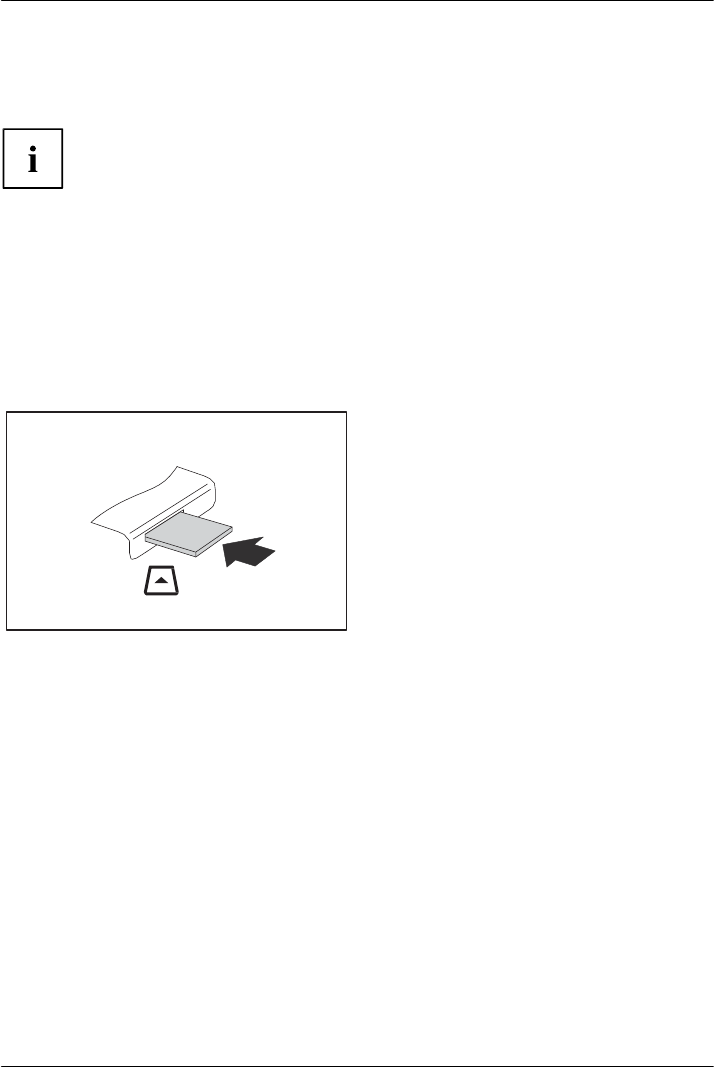
Working with the notebook
Memory cards
Your notebook is equipped with an integrated memory card reader.
Follow the manufacturer’s instructions when handling the memory cards.
Supported formats
Your
notebook supports the following formats:
•
Secure Digital (SDTM Card)
•
SDHC
•
SDXC
Inserting the memory card
►Carefully slide the memory card into the
slot. The label should be facing upward.
Do
not apply excessive force, as otherwise
the
delicate contact surfaces could be damaged.
4
Depending on the particular type
used, the memory card may protrude
slightly from the slot.
Fujitsu 53
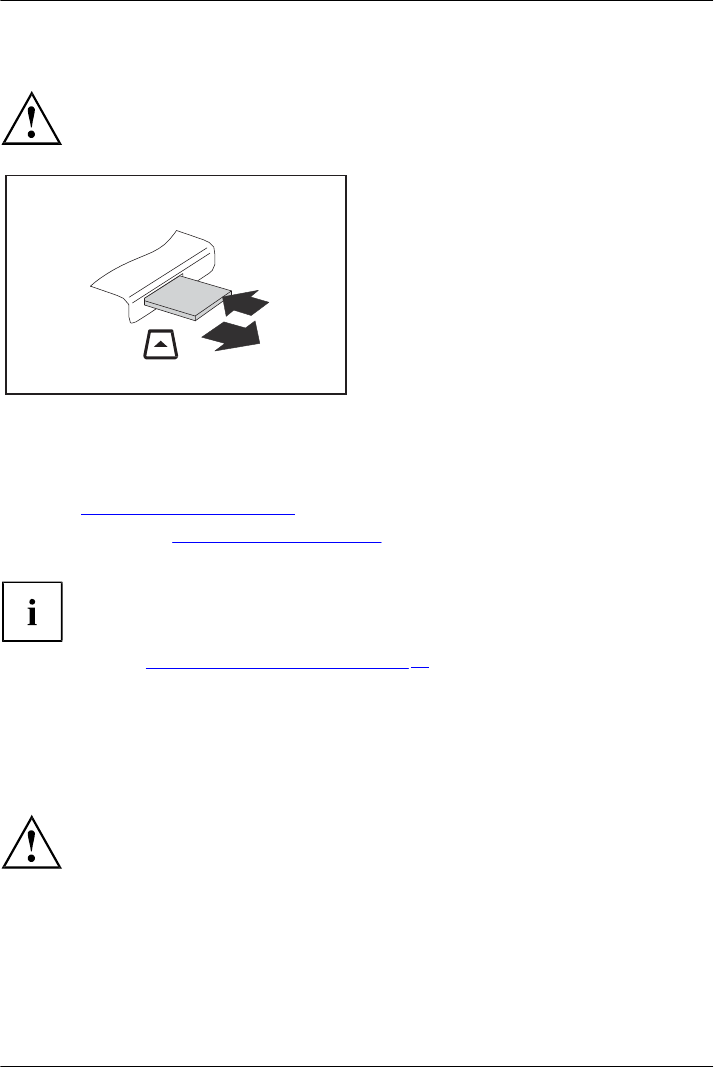
Working with the notebook
Removing the memory card
To avoid any loss of data, always follow the correct procedure for removing the
card (see the documentation for your operating system).
►On devices with card locking: Press
on the memory card (1).
4 The memory card is released and
can now be removed.
►Pull the memory card out of the slot (2).
Speaker and microphone
You can find information about the exact position of speakers and microphones
in chapter "Ports and controls", Page 10.
Please refer to chapter "Key combinations", Page 43 for information on setting the volume
and also enabling/disabling the speakers using key combinations.
If you attach an external microphone, the built-in microphone is disabled.
When you connect headphones or external speakers, the built-in speakers are disabled.
You can find information on connecting headphones and a microphone in
chapter "Connecting external devices", Page 72.
SIM card
A SIM Card (Subscriber Identity Module) is a chip card which is inserted in
a mobile telephone or notebook and, together with an integrated UMTS/LTE
module, enables access to a mobile radio network.
Follow the instructions supplied by the provider of the SIM card.
1
2
54 Fujitsu
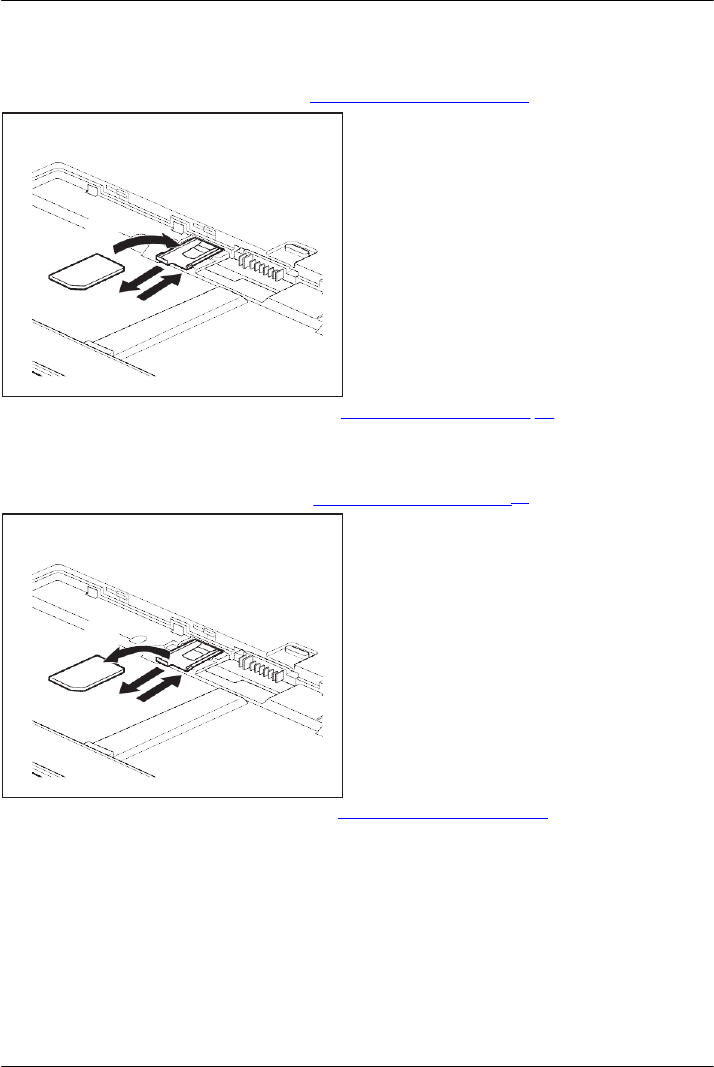
Working with the notebook
Inserting a SIM card
►Remove the rechargeable battery, see "Removing a battery", Page 49.
►Remove the SIM card carrier from
its location (1).
►Insert the SIM card (2) in the SIM
card carrier as shown symbolically on
the SIM card carrier.
►Push the SIM card carrier back into
its location (3).
►Install the rechargeable battery again, see "Installing a battery", Page 51.
Removing a SIM card
►Remove the rechargeable battery, see "Removing a battery", Page 49.
►Remove the SIM card carrier from
its location (1).
►Remove the SIM card from the SIM
card carrier (2).
►Push the SIM card carrier back into
its location (3).
►Install the rechargeable battery again, see "Installing a battery", Page 51.
2
1 3
2
1 3
Fujitsu 55

Working with the notebook
Fn
Optional wireless LAN / Bluetooth / 4G
wireless components
The installation of radio components not approved by Fujitsu will invalidate
the certifications issued for this device.
Depending on the system configuration ordered, your system will be equipped
with wireless LAN, Bluetooth and / or 4G.
Switching the wireless components on and off
►Press the key combination
+
to start the WirelessSelector.
4 The wireless component indicator will illuminate when one or more wireless
components are switched on.
The Bluetooth 4G modules and the wireless LAN transmission unit (antenna) will
all be switched off when you switch off the wireless components.
Pay attention to the additional safety notes for devices with wireless
components provided in the "Safety" manual.
Details on using a wireless LAN can be found in the online help system
included in the wireless LAN software.
You can obtain more information on 4G from your service provider.
Configuring WLAN access
•
Requirement: A WLAN is available and you have the necessary access data to hand.
Information on configuring WLAN access can be found in the
documentation for your operating system.
Further information on WLAN and Bluetooth
For further information about WLAN or Bluetooth, please refer to the
appendix of this Operating Manual.
For WLAN specifications, see chapter "WLAN specifications", Page 90.
F5
56 Fujitsu
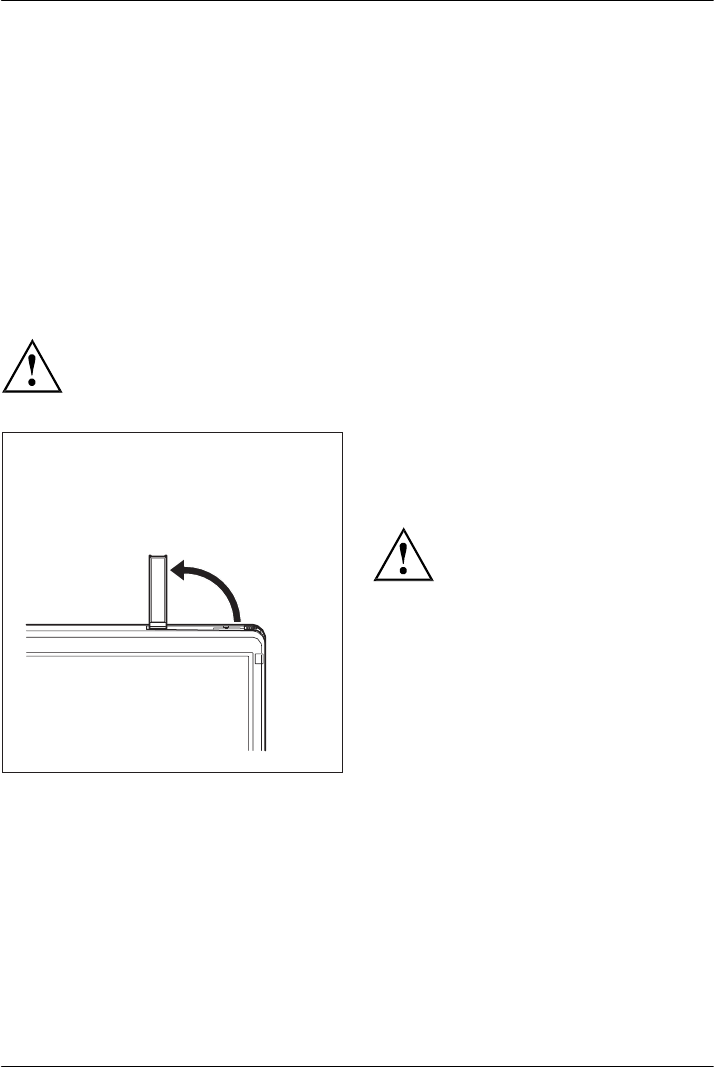
Working with the notebook
Access via 4G
If you ordered an integrated 4G module with your system, your device will
already be prepared when you receive it.
You will find information on establishing the connection with the 4G network
in the documentation for the hardware used.
Your device can connect to the Internet via 4G. To do this, use one of the following types of connection:
1
•
Integrated 4G module (availability dependent on your model variant)
•
a USB dongle (a USB stick with your mobile phone provider’s SIM card)
•
a mobile end-device (e.g. mobile phone with Bluetooth or cable connection)
UMTS/LTE
antenna
If you have a device with a wireless WAN module installed, note that while holding
the system horizontally with the webcam at the bottom (tablet position and Secondary
Landscape setting), WWAN must not be operated with the antenna open. Operating
the device in this position could result in damage to the WWAN antenna.
►In order to improve the UMTS/LTE signal
strength, fold out the UMTS/LTE antenna
in the direction of the arrow (1).
Fujitsu 57
Note: When your device is in
tablet mode, it should not be used
in Secondary Lanscape position
with the antenna in the open
position.
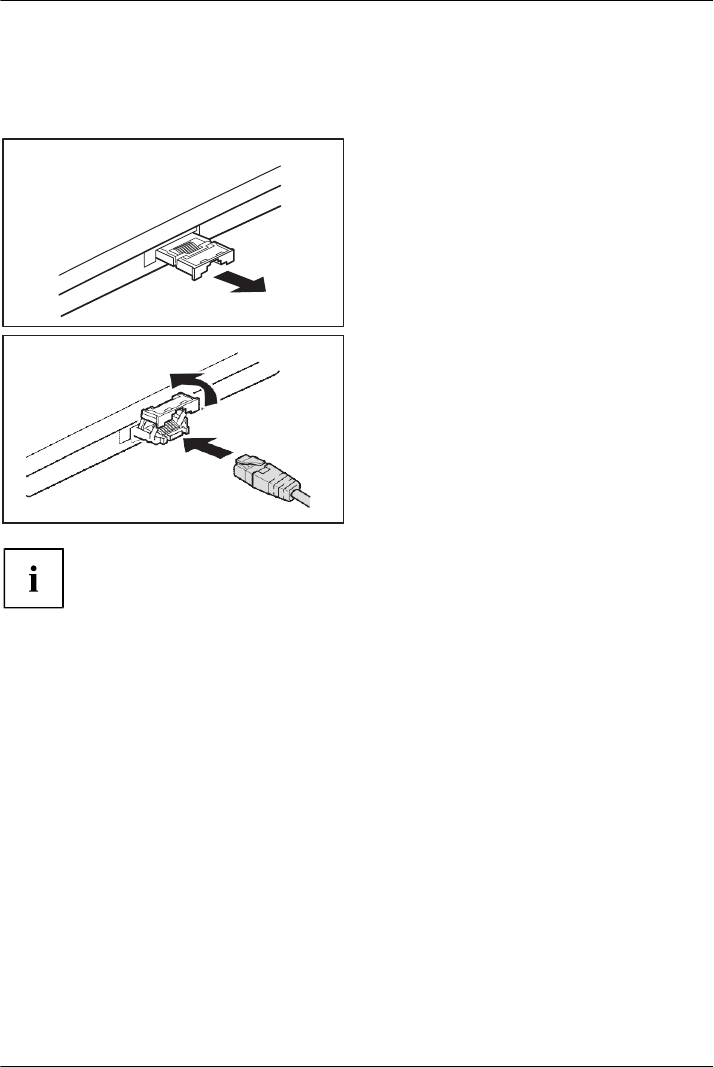
Working with the notebook
Ethernet and LAN
You can use an Ethernet LAN when you use a LAN adapter, which can be obtained as an option.
You can use it to establish a connection to a local network (LAN = Local Area Network).
1
2
►Pull the LAN adapter out of the LAN port on
the notebook in the direction of the arrow.
►Push the LAN adapter upwards in the
direction of the arrow (1).
►
Plug the network cable into the
LAN adapter (2).
►
Connect the network cable to your
network port.
Your network administrator can help you to configure and use the LAN connections.
The
network cable is not included in the delivery scope. This type of
cable can be obtained from a specialist dealer.
58 Fujitsu

Working with the notebook
Your port replicator (optional)
Your port replicator is a device that helps you to quickly connect your notebook to
your peripheral devices, such as a monitor, printer, etc.
The features offered by the port replicator include standard ports for
monitor, audio, mouse and keyboard.
You need only dock the notebook in order to work with your peripheral devices.
Ports on the port replicator
1 = Security Lock
2 = USB ports
3 = LAN port
4 = Display Port
5 = DVI port
6 = VGA monitor port
7 = DC input connector (DC IN)
8 = Connector on the port replicator for the
docking port on the bottom of the notebook
9 = Release
10 = Power ON/OFF button
9
10
7
1
6
5
3 4
2
1
8
Fujitsu 59

Working with the notebook
Setting up the port replicator
Select a suitable location for the Port Replicator before setting it up. In
doing so, please follow these instructions:
•
Never place the port replicator on a soft surface (e.g. carpeting, upholstered furniture, bed).
This can block the air vents of the notebook and cause overheating and damage.
•
Place the port replicator on a stable, flat and anti-slip surface. Please note that
the rubber feet may mark certain types of surfaces.
•
Never place the port replicator and the mains adapter on a heat-sensitive surface.
•
Do not expose the port replicator to extreme environmental conditions.
Protect the port replicator from dust, humidity and heat.
60 Fujitsu
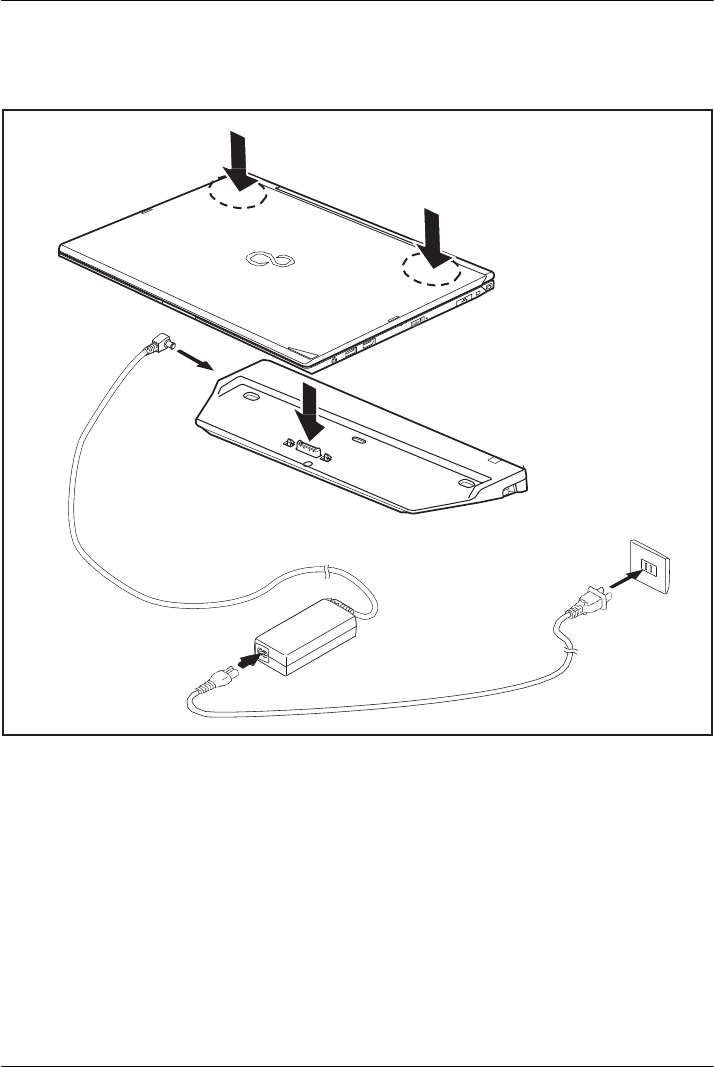
Working with the notebook
Connecting the notebook to the port replicator
►Disconnect the AC adapter cable from the DC jack (DC IN) of the notebook.
►Place the notebook on the port replicator so that the connector on the underside of
the notebook aligns with the connector on the port replicator (1).
►Press down on the notebook’s rear corners so that it locks into position (2).
►Connect the AC adapter cable to the DC jack (DC IN) of the port replicator (3).
►Connect the AC cable to the AC adapter (4).
►Plug the AC cable into the power outlet (5).
2
2
3
1
5
4
Fujitsu 61
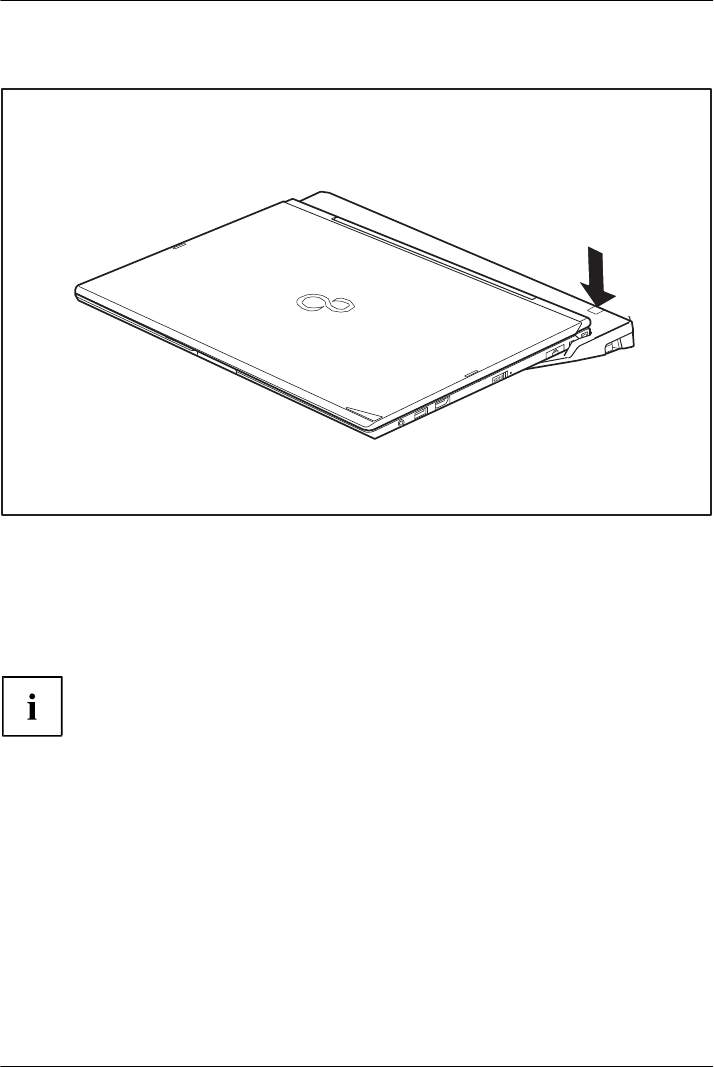
Working with the notebook
Switching on the notebook via the port replicator
►
Press the power ON/OFF button on the port replicator to switch the notebook on.
Switching
off notebook via port replicator
►
Close all applications and then shut down your operating system (please
refer to the manual for the operating system).
If the notebook cannot be shut down properly, press the ON/OFF button on
the port replicator for approx. four seconds. The notebook will switch off.
However, any unsaved data may be lost in the process.
62 Fujitsu
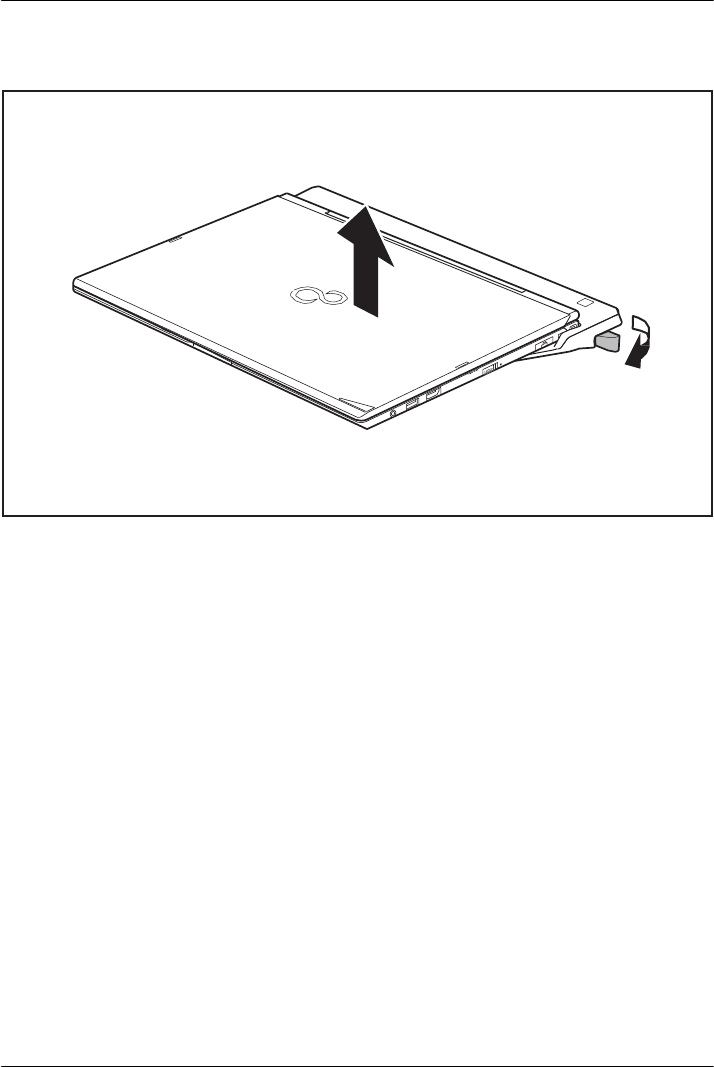
Working with the notebook
Disconnecting the notebook from the port replicator
2
1
►Pull the unlocking lever in the direction of the arrow (1), until you hear the notebook unlatch.
►Lift off the notebook (2).
Fujitsu 63

Security functions
Security functions
Your notebook has a variety of security functions that you can use to protect your
system and your personal data from unauthorized access.
This chapter explains how to use these functions, and what the benefits are.
Please remember that in some cases, for example, forgetting your password,
you may be locked out of the system and unable to access your data.
Therefore, please note the following information:
•
Make regular backups to external optical disks such as external hard
drives, CDs, DVDs or Blu-ray Discs.
•
Some security functions need you to choose passwords. Make a note
of the passwords and keep them in a safe place.
If you forget your passwords you will need to contact our Service Desk.
Deletion or resetting of passwords are not covered by your warranty
and a charge will be made for assistance.
64 Fujitsu

Security functions
Brief overview of the security functions
Detailed information about the security equipment of your system can be found
in the "Professional Notebook" manual, on the "Drivers & Utilities" CD/DVD or
on our website at "http://www.fujitsu.com/us/support/".
Security function
Type of protection
Preparation
Security Lock
Mechanical
Fit and lock the Kensington
Lock Cable (accessory).
Fingerprint sensor (device
dependent)
Biometric
Install the supplied fingerprint
software.
BIOS password protection
Password protection for
the BIOS Setup, operating
system and hard disk with
supervisor and user password.
The passwords consist of a
maximum of eight alphanumeric
characters.
Specify at least one supervisor
password in the BIOS Setup
and activate the password
protection for the operating
system and hard disk as
desired.
Boot from Removable Media
Prevents unauthorized booting
of an operating system from
external media (e.g. USB stick,
USB CD-ROM drive, etc.).
In the BIOS Setup, go to the
Security menu and edit the Boot
from Removable Media option.
Owner Information
Display service desk or owner
information during the boot
process.
In the BIOS Setup, go to the
Security menu and edit the
Owner Information option.
SmartCard reader (device
dependent)
PIN and SmartCard protection
for the operating system
To use the SmartCard reader
functions, install the supplied
(or other suitable) software.
Trusted Platform Module
(device dependent)
Identification and authentication
of the notebook
Define a supervisor password
in the BIOS Setup and enable
the TPM (Security Chip).
Fujitsu 65
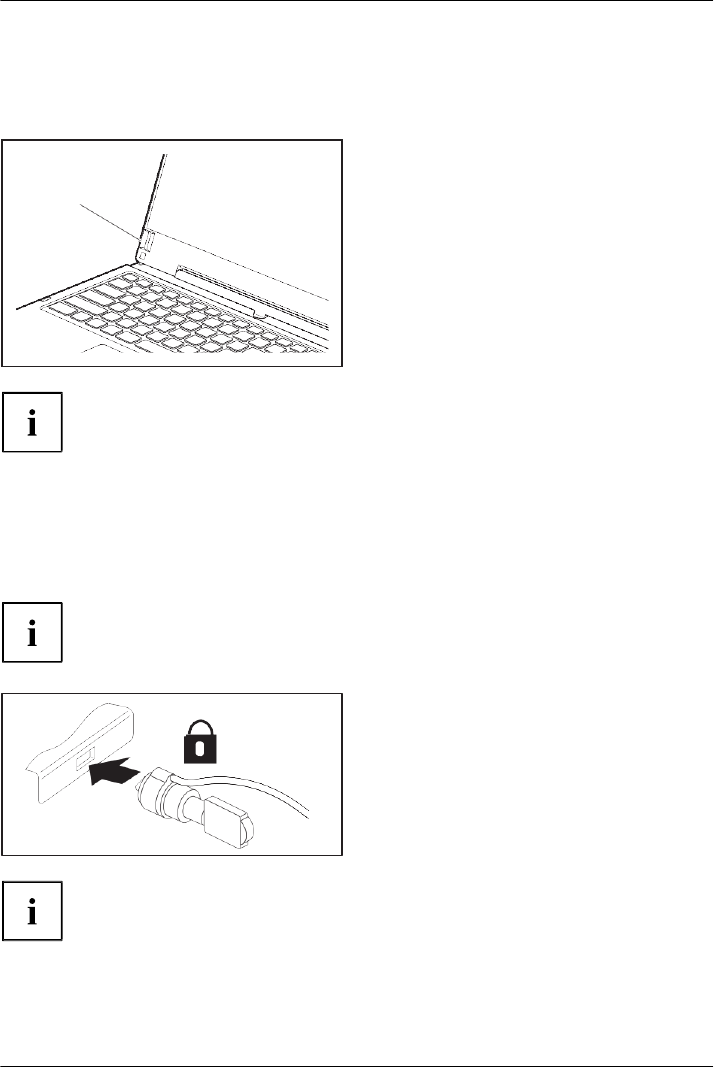
Security functions
Configuring the fingerprint sensor
The fingerprint sensor can record the image of a fingerprint. With additional fingerprint
software, this image can be processed and used instead of a password.
►Install the fingerprint software to be able
to use the fingerprint sensor (1).
You can obtain further information on the fingerprint sensor in the
"appendix: Miscellaneous Information".
Using the Security Lock
Your device comes with a Security Lock mechanism for the Kensington Lock Cable. You
can use the Kensington Lock Cable, a sturdy steel cable, to help protect your notebook
from theft. The Kensington Lock Cable is available as an accessory.
Fujitsu recommends the use of a combination lock.
►Fit the Kensington Lock Cable to the
mechanism on your notebook.
Attach another Kensington Lock Cable to your port replicator to protect your port
replicator from theft as well. There are two security lock devices on your port replicator.
1
66 Fujitsu

Security functions
Configuring password protection in BIOS Setup Utility
Before using the various options for password protection in the BIOS Setup
Utility, please proceed as follows to increase data security:
Make a note of the passwords and keep them in a safe place. If you forget your
supervisor password you will not be able to access your notebook. Passwords are
not covered by your warranty and a charge will be made for assistance.
Your password can be up to eight characters long and can contain letters and
numbers. No distinction is made between uppercase and lowercase.
Protecting BIOS Setup Utility (supervisor password
and user password)
If you have opened these operating instructions on the screen, we recommend
that you print them out. You cannot call up the instructions on the screen
while you are setting up the password.
The supervisor password and the user password both prevent unauthorized use of the BIOS
Setup Utility. The supervisor password allows you to access all of the functions of the BIOS Setup
Utility, while the user password will only give you access to some of the functions. You can
only set up a user password if a supervisor password has already been assigned.
Calling and using the BIOS Setup Utility is described in the chapter
"Settings in BIOS Setup Utility", Page 78.
Assigning the supervisor and user passwords
►Start the BIOS Setup Utility and go to the Security menu.
►Select the Set Supervisor Password field and press the Enter key.
4 With Enter new Password: you are asked to enter a password.
►Enter the password and press the Enter key.
4 Confirm new Password requires you to confirm the password.
►Enter the password again and press the Enter key.
4 Changes have been saved is displayed as a confirmation that the new password has been saved.
►To set the user password, select Set User Password and proceed exactly as
when configuring the supervisor password.
4 If you do not want to change any other settings, you can exit BIOS Setup Utility.
►In the Exit menu, select the option Save Changes & Exit.
►Select Yes and press the Enter key.
4 The notebook is then rebooted and the new password comes into effect. It will now be necessary
to first enter your supervisor or user password in order to open the BIOS Setup Utility. Please
note that the user password only provides access to a few of the BIOS settings.
Fujitsu 67

Security functions
Changing the supervisor password or user password
You can only change the supervisor password when you have logged into the
BIOS Setup Utility with the supervisor password.
►Start the BIOS Setup Utility and go to the Security menu.
►When changing the password, proceed exactly as when assigning a password.
Removing passwords
To remove a password (without setting a new password) perform the following steps:
►Start the BIOS Setup Utility and go to the Security menu.
►Highlight the Set Supervisor Password or Set User Password field and press the Enter key.
4 You will be requested to enter the current password by the Enter Current Password prompt.
Enter New Password will appear and you will be requested to enter a new password.
►Press the Enter key twice at this request.
►In the Exit menu, select the option Save Changes & Exit.
►Select Yes and press the Enter key.
4 The notebook will now reboot with the password removed.
With the supervisor password, you simultaneously deactivate the user password.
Password protection for booting the operating system
With the supervisor password you have set in the BIOS Setup Utility (see
section "Assigning the supervisor and user passwords", Page 67), you can
also prevent booting of the operating system.
Activating system protection
►Start the BIOS Setup Utility and go to the Security menu.
►Select the Password on Boot option and press the Enter key.
►Select the option you require (Disabled, First Boot or Every Boot) and press the enter key
►Select the Save Changes & Exit option under Exit.
4 The notebook will reboot. You will be prompted to enter your password (the supervisor password).
Deactivating system protection
►Start the BIOS Setup Utility and go to the Security menu.
►Select the Password on Boot option and press the Enter key.
►Select the Disabled option and press the Enter key.
4 If you do not want to change any other settings, you can exit BIOS Setup Utility.
►Select the Save Changes & Exit option under Exit.
4 The notebook will reboot. The system is no longer password-protected.
68 Fujitsu
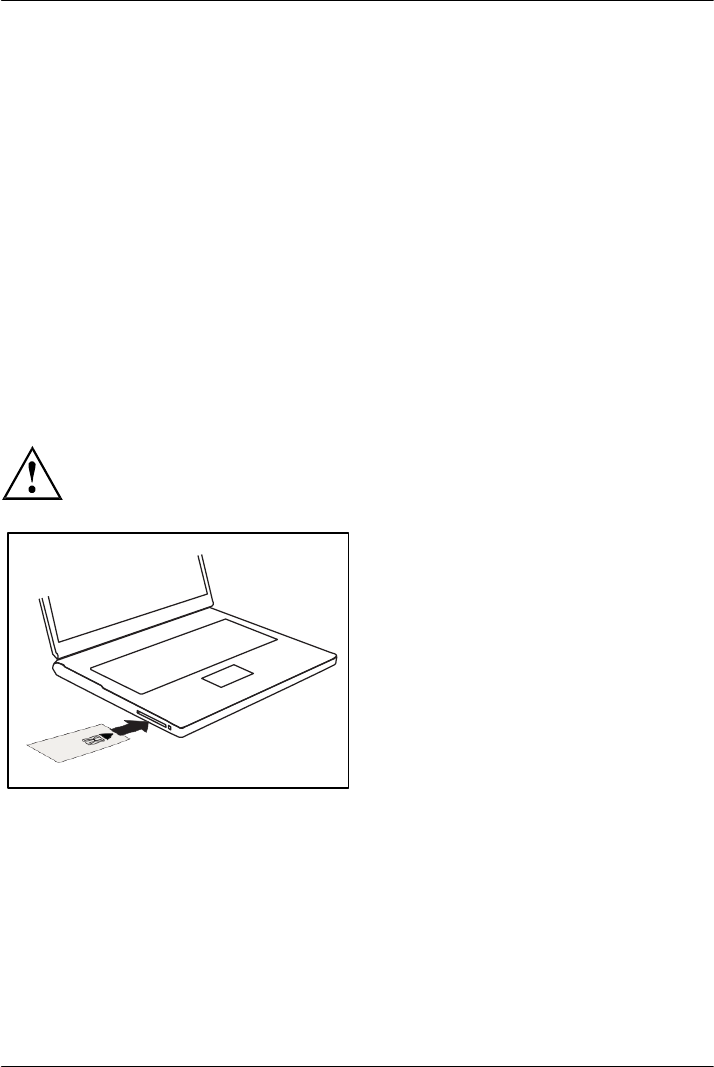
Security functions
Password protection for the hard disk
If a supervisor password was set, an additional password for the hard disk
can be set in the Hard Disk Security menu.
The hard disk is protected by this password. Data on this hard disk can then only be
read in another system if the correct password is entered.
Smart Card reader
Smart Cards are not supplied as standard equipment. You can use all Smart Cards that comply with
the ISO standard 7816-1, -2 or -3. These Smart Cards are available from various manufacturers.
With the appropriate software you can use your Smart Card as an alternative to password
protection, but also as a digital signature, for encrypting your e-mails or for home banking.
We recommend that you always use two Smart Cards. Always keep one of the Smart Cards
in a safe place if you are carrying the other Smart Card with you.
Inserting the Smart Card
Do not use force when inserting and removing the Smart Card.
Make sure that foreign objects do not fall into the Smart Card reader.
►Slide the Smart Card into the Smart
Card reader with the chip facing upwards
(or downwards depending on the
device) and to the front.
Using the security function of the tablet buttons
If you have allotted a supervisor and/or user password in the form of tablet button combinations as
described below, you can use the tablet buttons to enter this when you start your device.
Fujitsu 69

Security functions
2
1
1
Assigning the supervisor password
►Select Start - Run.
►Enter the following information in the prompt: C:\Program Files\Fujitsu\Security
Panel Application\Supervisor\FJSECS.EXE.
►Confirm with Enter .
►Follow the instructions on the screen.
Assigning the user password
►Select Start - All Programs.
►Select Security Panel Application - Security Panel Application.
►Follow the instructions on the screen.
Entering passwords via the tablet buttons
The passwords for entry via the tablet buttons usually consist of a combination of buttons,
e.g. button + button 3 , followed by button and button ENT .
►Enter your password using buttons
►Confirm with ENT .
4 The device will be unlocked.
to 4 .
70 Fujitsu

Security functions
Trusted Platform Module - TPM (device dependent)
To use the TPM, you must enable the TPM in the BIOS-Setup before the software is
installed. The requirement for this is that you have assigned at least the supervisor
password (see "Security functions", Page 64).
Enabling TPM
•
Requirement: You have assigned a supervisor password (see "Security functions", Page 64).
►Call BIOS Setup and select the Security menu.
►Mark the TPM Security Chip Setting field and press the Enter key.
►Select the entry Enabled to enable the TPM
4 Once you have enabled the TPM the Clear Security Chip menu item appears.
You can clear the holder in the TPM using Clear Security Chip. With Enabled,
all secret keys (e.g. SRK - Storage Root Keys, AIK - Attestation Identity Keys
etc.) generated by applications are deleted.
Take note that you can then no longer access the data you have
encrypted on the holder-based keys!
►Select the Exit Saving Changes option in the Exit menu.
►Press the Enter key and select Yes.
4 The notebook restarts and the TPM is switched on after the reboot.
Disabling TPM
•
Requirement: You have assigned a supervisor password (see "Security functions", Page 64).
►Call BIOS Setup and select the Security menu.
►Mark the TPM Security Chip Setting field and press the Enter key.
►Select the entry Disabled to disable the TPM.
►From the Exit menu, choose the option Exit Saving Changes.
►Press the Enter key and select Yes.
4 The notebook will now reboot with TPM deactivated.
Fujitsu 71
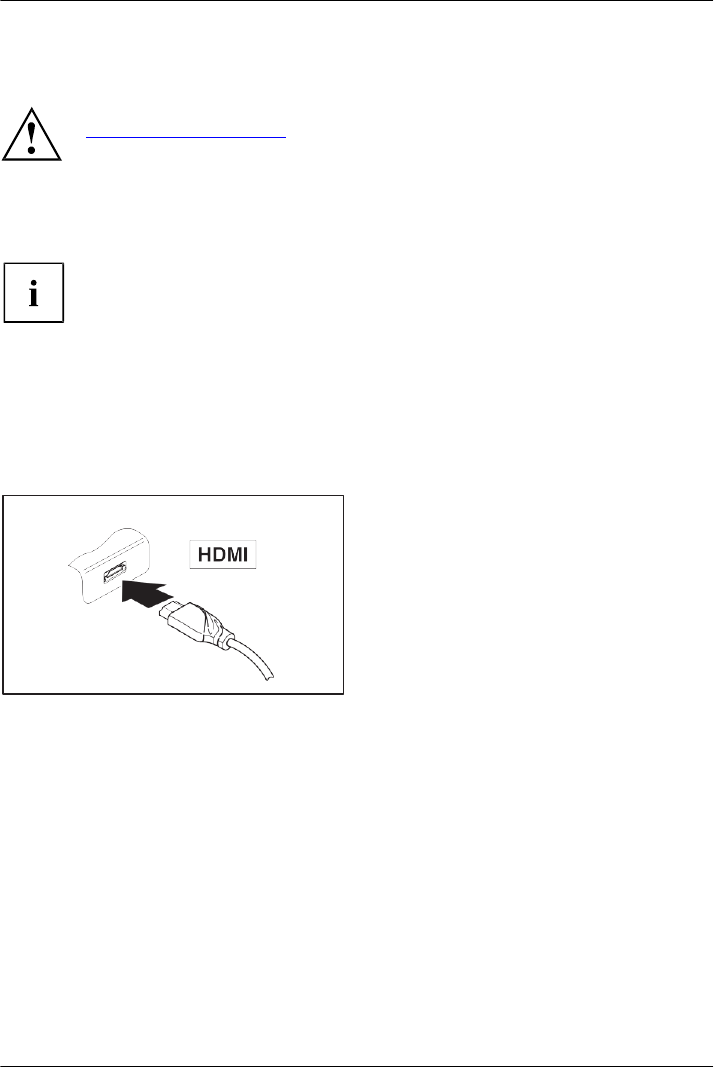
Connecting external devices
Connecting external devices
Under all circumstances, please observe the safety notes provided in the
"Important notes", Page 13 chapter before connecting or disconnecting
any devices to or from your notebook.
Always read the documentation supplied with the device you wish to connect.
Never connect or disconnect cables during a thunderstorm.
Never pull at a cable when disconnecting it. Always grasp the plug.
With some devices such as USB devices, it is not necessary to switch off
the notebook and the device before connecting/disconnecting. For more
information about whether or not devices need to be switched off, please refer
to the documentation supplied with the external device.
Some of the external devices require special drivers (see the operating
system and external device documentation).
HDMI
port
The
HDMI port on your notebook can be used to connect an external amplifier,
LCD
TV or a plasma TV with an HDMI connection.
►Connect the data cable to the
external device.
►Connect the data cable to the HDMI
port of the notebook.
72 Fujitsu
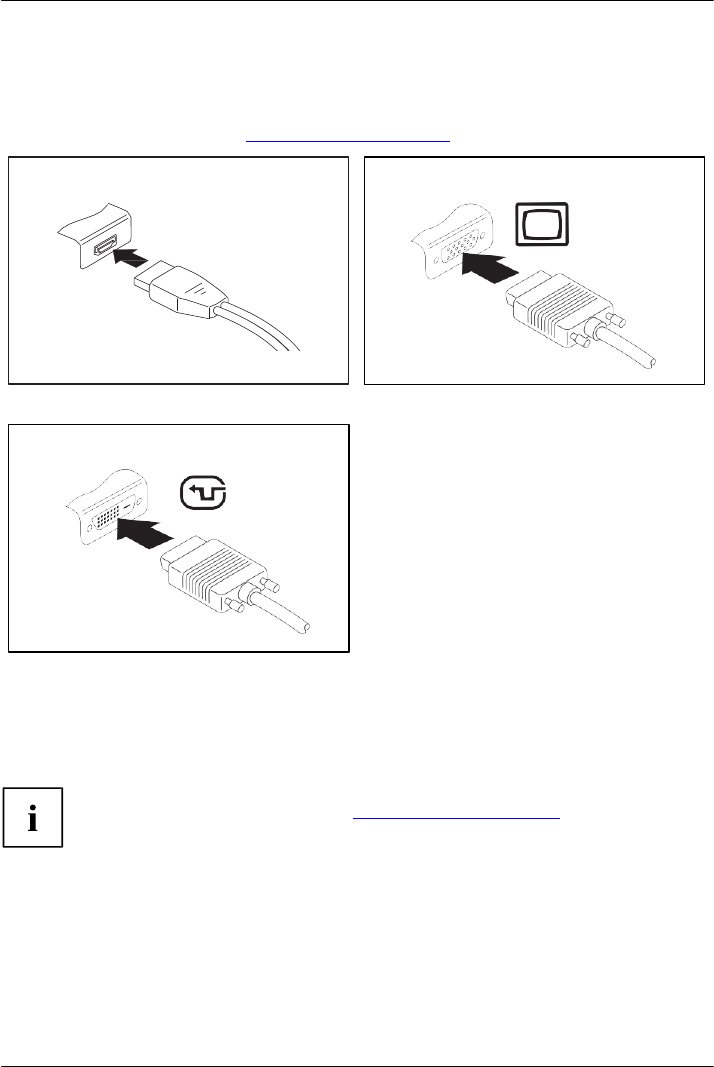
Connecting external devices
Connecting an external monitor to the port replicator
An analog monitor is connected to the analog VGA monitor port, a digital monitor to the DisplayPort
or to the DVI-D monitor port on the optional port replicator. Monitor output is limited to a maximum of
two monitors at any one time (see "Key combinations", Page 43, section "Toggle output monitor").
Digital DisplayPort
Analog VGA monitor port
Digital DVI-D monitor port
►
Switch off the notebook and the external monitor.
►
Plug the data cable of the external monitor into the monitor port.
►
First switch on the external monitor and then the notebook.
You can also switch back and forth between the external screen and the LCD
screen of the notebook, see chapter "Key combinations", Page 43.
You can display the same picture on the external monitor and the
notebook LCD screen simultaneously.
Fujitsu 73
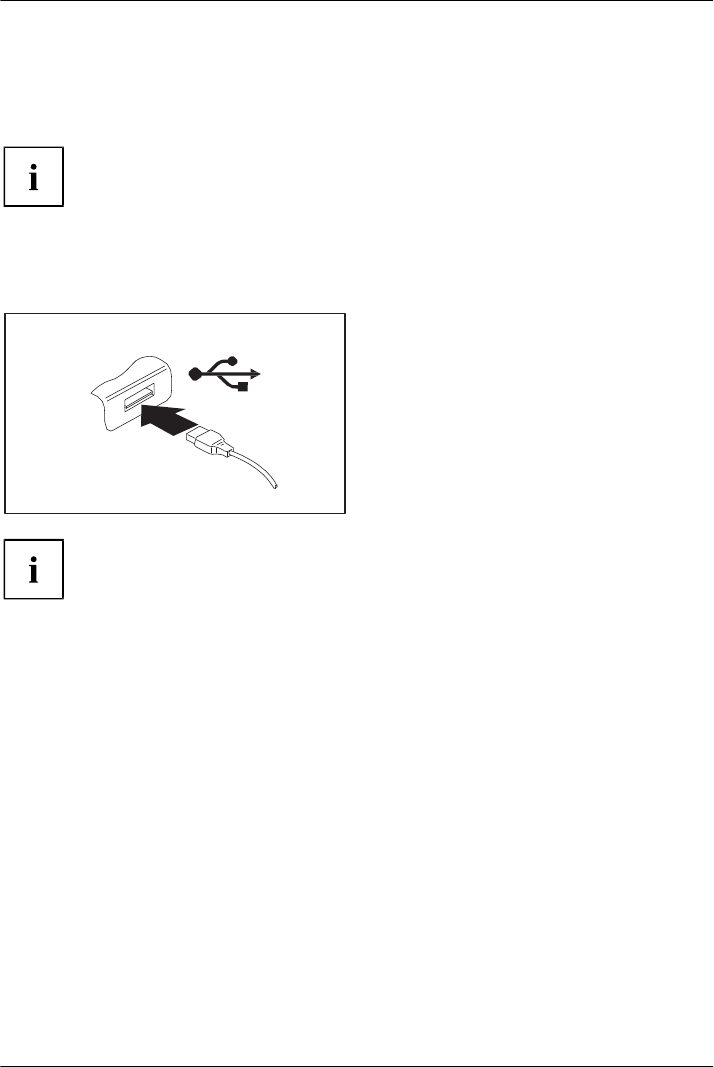
Connecting external devices
Connecting USB devices
On the USB ports you can connect external devices that also have a USB port
(e.g. a DVD drive, a printer, a scanner or a modem).
USB devices are hot-pluggable. This means you can connect and disconnect the
cables
of USB devices while the operating system is running.
USB
1.x has a maximum data transfer rate of 12 Mbps.
USB
2.0 has a data transfer rate of up to 480 Mbps.
USB
3.0 has a data transfer rate of up to 5 Gbps.
Additional
information can be found in the documentation for the USB devices.
►Connect the data cable to the
external device.
►Connect the data cable to a USB
port of the notebook.
Device drivers
USB devices will be automatically recognized and installed by your operating system.
74 Fujitsu
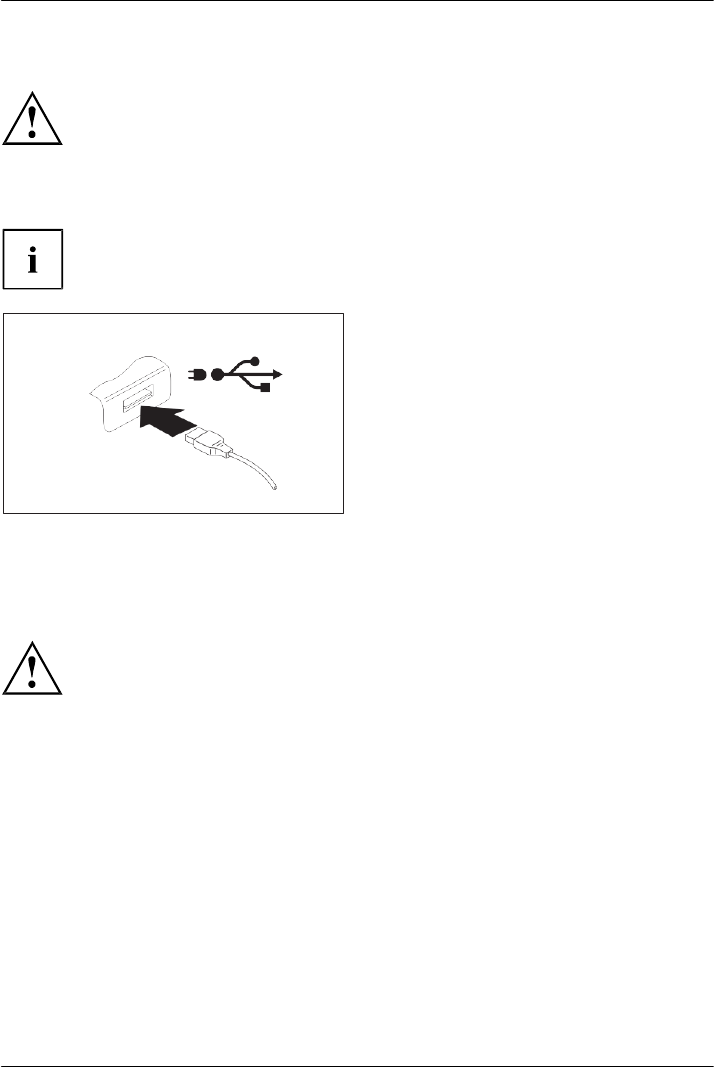
Connecting external devices
USB port with charging function (Anytime USB charge)
It is recommended that the notebook be operated with the AC adapter connected
whenever the USB port with charging function is in use, as this function will drain
the battery more quickly if an external USB device is being charged.
The AC adapter must already be connected when the notebook is switched
off, as otherwise the USB charging function will be disabled and the
connected USB devices will not be charged.
Some USB devices (e.g. mobile telephony) require a driver in order to utilize the USB
charging
function. In this case the USB charging function will not work when the
notebook is switched off, as no drivers are active when the notebook is switched off.
You can use this USB port to charge or supply power to a USB device (e.g. to charge a PDA
or
a mobile phone or to connect a USB lamp), even if the notebook is switched off.
How
to remove USB devices correctly
Always correctly remove the device according to the rules described below,
to ensure that none of your data is lost.
►With the left mouse button, click on the symbol in the taskbar for safe removal of hardware.
►
Select the device you wish to shut down and remove.
►
Press the "Enter" key.
4 Wait for the dialog box which tells you that it is now safe to remove the device.
Fujitsu 75
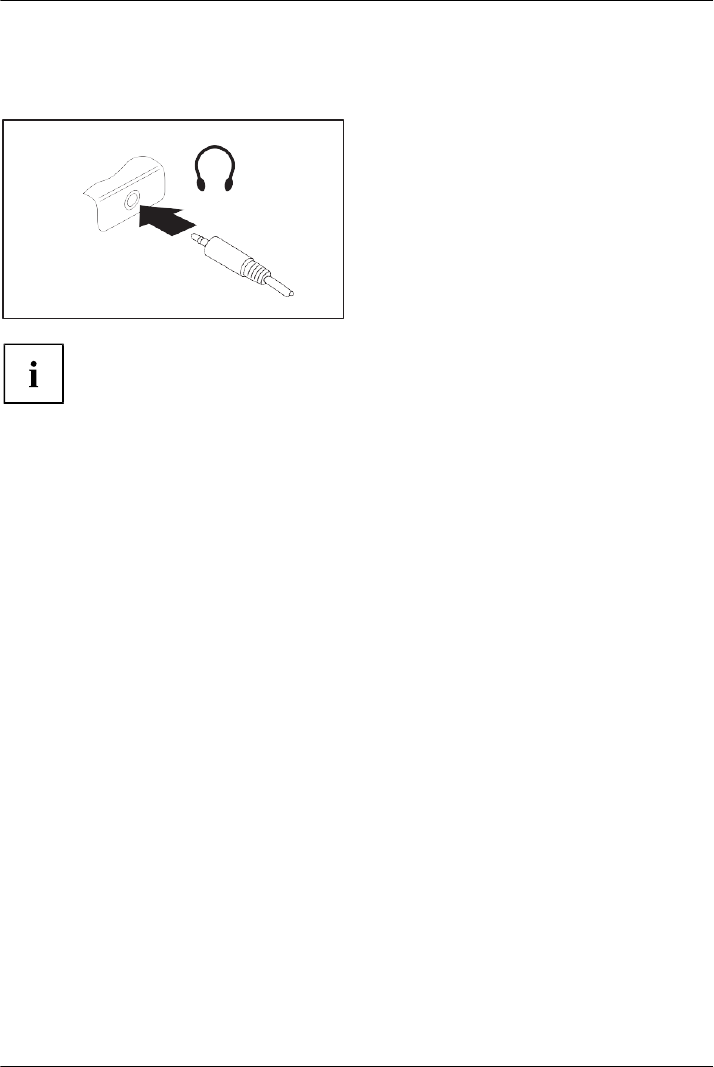
Connecting external devices
Headphones port
You can connect headphones or external speakers to your notebook via the headphones port.
►Connect the audio cable to the
external device.
►
Connect the audio cable to the headphones
port of the notebook.
4 The internal speakers are disabled.
If you buy a cable from a retailer, please note the following information:
The
headphones port on your notebook is a "3.5 mm jack".
If you want to connect headphones or speakers you will need a "3.5 mm jack plug".
76 Fujitsu

Removing and installing components during servicing
Removing and installing components
during servicing
Only qualified technicians should repair your notebook. Unauthorized
opening or incorrect repair may greatly endanger the user (electric shock,
fire risk) and will invalidate your warranty.
Fujitsu 77

Settings in BIOS Setup Utility
Settings in BIOS Setup Utility
The BIOS Setup Utility allows you to set the system functions and the hardware
configuration for the notebook.
When a notebook is delivered, the factory default settings are effective. You can change
these settings in the menus of the BIOS Setup Utility. Any changes you make take
effect as soon as you save and exit the BIOS Setup Utility.
The BIOS Setup Utility program contains the following menus:
About
Displays information relating to the BIOS, processor and notebook
System
Advanced system settings
Advanced
Configuration of various hardware components, such as mouse, keyboard,
processor
Security
Password settings and security functions
Boot
Configuration of the start-up sequence
Exit
Exits the BIOS Setup Utility
Starting the BIOS Setup Utility
►Reboot the device (switch off/on or reboot the operating system).
4 Depending on the BIOS Setup Utility setting for Fast Boot the following message
may appear on the screen at start-up:
<F2> BIOS Setup <F12> Boot Menu
►Press the function key F2 .
►If a password has been assigned, enter the password and press the Enter key.
If you have forgotten the password, contact your system administrator
or contact our customer service center.
The BIOS Setup Utility starts.
78 Fujitsu

Settings in BIOS Setup Utility
→
BIOS Setup Utility operation
Press the F1 key to display help about operation of the BIOS Setup Utility. The description
of the individual settings is shown in the right-hand window of the BIOS Setup Utility.
With the key you can load the default settings of the BIOS Setup Utility.
►Use the cursor keys
or
to select the menu you wish to access to make changes.
4 The menu is displayed on the screen.
►Select the option you want to change with the cursor keys
►Press the "Enter" key.
or ↓ .
►Press the key to exit the selected menu.
►For future reference, make a note of the changes you have made (for example, in this manual).
F9
←
↑
ESC
Fujitsu 79

Settings in BIOS Setup Utility
Exiting BIOS Setup Utility
You need to select the desired option in the Exit menu and activate it by pressing the Enter key:
Exit Saving Changes - save changes and exit BIOS Setup Utility
►To save the current menu settings and exit the BIOS Setup Utility, select Exit Saving Changes and Yes.
4 The notebook is rebooted and the new settings come into effect.
Exit Discarding Changes - Reject changes and
exit BIOS Setup Utility
►To discard the changes, select Exit Discarding Changes and Yes.
4 The settings in place when BIOS Setup Utility was called remain effective. BIOS
Setup Utility is terminated and the notebook is rebooted.
Load Setup Defaults – load default values
►To copy the standard entries for all menus of the BIOS Setup Utility,
choose Load Setup Defaults and Yes.
Discard Changes - Discard Changes without
exiting BIOS Setup Utility
►To discard the changes you have made, select Discard Changes and Yes.
4 The settings in place when BIOS Setup Utility was called remain effective.
You can now make additional settings in the BIOS Setup Utility.
►If you want to exit the BIOS Setup Utility with these settings, select Exit Saving Changes and Yes.
Save Changes - save changes without exiting
the BIOS Setup Utility
►To save the changes, select Save Changes and Yes.
4 The changes are saved. You can now make additional settings in the BIOS Setup Utility.
►If you want to exit BIOS Setup Utility with these settings, choose Exit Saving Changes and Yes.
Save changes and power off
►To save the changes and switch off your device, select Save Changes and Power Off and Yes.
4 The changes are saved. Your device is shut down.
80 Fujitsu

Troubleshooting and tips
Troubleshooting and tips
If a fault occurs, try to correct it as described. If you fail to correct the problem, proceed as follows:
►Make a note of the steps and the circumstances that led to the fault. Also
make a note of any error messages displayed.
►Switch the notebook off.
►Please contact the Hotline/Service Desk.
You can contact Fujitsu Service and Support in the following ways:
•
Toll free phone: 1-800-Fujitsu (1-800-838-5487)
•
Website: "http://solutions.us.fujitsu.com/www/content/support/contact/index.php"
Before you place the call, have the following information ready so that the customer
support representative can provide you with the fastest possible solution:
•
The model name and serial number of the notebook. The serial number is
located on a sticker on the underside of the notebook.
•
Notes with the messages that appeared on the screen and
information on acoustic signals.
•
Any changes you have made to the hardware or software since
receiving the notebook.
•
Any changes you have made to the BIOS Setup settings after receiving the notebook.
•
Your system configuration and all peripheral devices connected to your system.
•
Your sales contract.
Our notebooks have been designed primarily with mobile applications in mind.
This means that considerable effort has been made to optimize components and
equipment in terms of weight, space and energy requirements. Depending on the
particular configuration you have purchased, it is possible that functionality may be
slightly reduced compared to a desktop PC if you are running processor-intensive
gaming software, e.g. games with intensive 3D graphics. Updating your hardware with
drivers which have not been approved by Fujitsu may result in performance losses,
data losses or malfunction of the equipment. A list of approved drivers and current
BIOS versions can be downloaded from: "http://solutions.us.fujitsu.com"
Help if problems occur
Should you encounter a problem with your computer that you cannot resolve yourself:
►Note the ID number of your device. The ID number is found on the type rating
plate on the back or underside of the casing.
►For further clarification of the problem, contact the Fujitsu Service Desk. When you do
this, please have ready the ID number and serial number of your system.
Recovering your Factory Image
In the event you need to restore your original Factory Image, please refer to
the appendix of this Operating Manual.
Fujitsu 81

Troubleshooting and tips
Battery indicator does not illuminate
When certain characters are entered on the
keyboard, only numerals are written
The notebook’s LCD screen remains blank
The notebook’s date or time is incorrect
Cause
Troubleshooting
Time and date are incorrect.
►With the BIOS-Setup-Utility, you can set the
date and time in the Main menu.
Date and time are still set incorrectly after
switching on the notebook.
►Please contact your sales outlet or our
hotline/service desk.
Cause
Troubleshooting
The battery is not installed correctly.
►Switch the notebook off.
►Check whether the battery is installed
correctly in its compartment.
►Switch the notebook on.
The battery is discharged.
►Charge the battery.
or
►Install a charged battery.
or
►Connect the notebook to a AC outlet
using the AC adapter.
Cause
Troubleshooting
The virtual number keys of your device are
activated, see "Virtual number keys", Page 43
►Press the
Num
button.
Cause
Troubleshooting
Screen is switched off.
►Press a key or touch the Clickpad.
External monitor or television set connected.
►Press the key combination for changing over
the screen output, see "Key combinations",
Page 43.
82 Fujitsu

Troubleshooting and tips
The external monitor remains blank
The external monitor is blank or the image is unstable
The LCD screen of the notebook is difficult to read
Cause
Troubleshooting
Reflected glare
►Turn the notebook or alter the tilt of the LCD
screen.
►Increase the brightness of the screen.
Cause
Troubleshooting
Monitor is switched off.
►Switch the external monitor on.
Power saving has been activated (monitor is
blank).
►Press any key to continue.
Brightness is set to dark.
►Adjust the brightness of the monitor.
Screen output is set to the notebook’s LCD
screen
►Press the key combination for changing over
the screen output, see "Key combinations",
Page 43.
The external monitor’s AC cable or data cable is
not connected properly.
►Switch off the external monitor and the
notebook.
►Check whether the AC cable is plugged
properly into the external monitor and into
the power outlet.
►Check whether the data cable is properly
connected to the notebook and the external
monitor (if it is plugged in with a connector).
►Switch on the external monitor and the
notebook.
Cause
Troubleshooting
The wrong external monitor has been selected
or the wrong screen resolution has been set for
the application program.
►Terminate the application program under
Windows by pressing Alt + F4 . If the
error persists after terminating the program,
use the key combination for switching the
screen output (see "Key combinations",
Page 43), in order to switch to the LCD
screen of the notebook.
Change the following setting:
►Set the screen resolution: Set the screen
resolution as described in the documentation
for your operating system.
►Select monitor: Select monitor 1 or 2 as
described in the documentation for your
operating system.
Fujitsu 83

Troubleshooting and tips
Stylus input not working
The notebook does not start after switching it on
The cursor does not correctly follow the
stylus movements
Cause
Troubleshooting
Stylus incorrectly calibrated.
►Calibrate the stylus as shown under
Hardware and Sound / Tablet PC Settings
in the Control Panel, see "Adjusting the
stylus", Page 37 and "Calibrating the stylus",
Page 37.
Cause
Troubleshooting
Incorrect driver installed.
►If your device is one which can only be
operated using the stylus, install the driver
for the standard model.
or
►If your device is one which can be
operated using the stylus and by finger,
install the driver for the "Dual Digitizer"
model.
Cause
Troubleshooting
The battery is not installed correctly.
►Check whether the battery is installed
correctly in its compartment.
►Switch the notebook on.
The battery is dead.
►Charge the battery.
or
►Insert a charged battery.
or
►Connect the AC adapter to the notebook.
The AC adapter is not connected properly.
►Check whether the AC adapter is properly
connected to the notebook.
►Switch the notebook on.
84 Fujitsu

Troubleshooting and tips
The printer does not print
The wireless connection to a network does not work
The notebook stops working
Cause
Troubleshooting
The notebook is in energy saving mode.
►End energy saving mode.
An application program has caused the
malfunction.
►Close the application program or restart
the notebook (by restarting the operating
system or switching the device off and back
on again).
The battery is dead.
►Charge the battery.
or
►Insert a charged battery.
or
►Connect the AC adapter to the notebook.
Cause
Troubleshooting
The printer is not switched on.
►Make sure that the printer is switched
on and ready for operation (refer to the
documentation supplied with the printer).
The printer is not connected correctly.
►Check that the data cable connecting
the notebook to the printer is properly
connected.
The printer driver is faulty or not correctly
installed, or it is the wrong printer driver.
►Check whether the correct printer driver is
loaded (refer to the printer documentation).
Cause
Troubleshooting
The wireless component is switched off.
►Switch the wireless component on (see
"Switching the wireless components on and
off", Page 56).
The wireless component is switched on. Despite
this, the wireless connection to a network does
not work.
►Check whether the wireless connection is
enabled by the software.
►Further information on using the wireless
component can be found in the help files.
Fujitsu 85

Troubleshooting and tips
Smart Card reader is not recognized
Smart Card PIN forgotten
Smart Card lost
The battery discharges too quickly
Cause
Troubleshooting
The battery is either too hot or too cold. In this
case the battery indicator flashes.
►Move the notebook so that its temperature
returns to within the normal range.
►If the operating time of the battery life is
extremely short, the battery is probably too
old. Replace the battery if necessary.
You may have an application running that
consumes a great deal of power due to frequent
accessing of the hard disk or optical drive.
►Use the AC adapter whenever possible.
The maximum brightness may have been set
for the screen.
►Set the screen slightly darker with the key
combination for Decreasing the screen
brightness in order to reduce the amount of
power being drawn.
Cause
Troubleshooting
Smart Card inserted incorrectly.
►Make sure you have inserted your Smart
Card into the Smart Card reader with
the chip facing upwards / downwards
(device-dependent).
►Check whether the Smart Card you are
using is supported. Your Smart Card must
comply with the ISO standard 7816-1, -2,
-3 and -4.
Cause
Troubleshooting
PIN forgotten
►If you are working in a network, contact your
system administrator, who can unlock your
notebook with a Supervisor PIN.
Cause
Troubleshooting
Smart Card lost.
►If you are working in a network, contact your
system administrator, who can boot your
notebook with a Supervisor Smart Card.
86 Fujitsu

Troubleshooting and tips
Acoustic warning
Error messages on the screen
This
section describes the error messages generated by the BIOS Setup. Error messages displayed
by
the operating system or programs are described in the documentation for these programs.
If the error message appears repeatedly despite troubleshooting measures,
contact the place of purchase or our customer service center.
User and/or supervisor SmartCard lost
Cause
Troubleshooting
User and/or supervisor SmartCard lost
►If you have lost your user SmartCard, you
can continue to work with the supervisor
SmartCard.
►If you have lost the supervisor SmartCard,
you can also continue working, but you no
longer have all rights and cannot initialize
another supervisor SmartCard.
Cause
Troubleshooting
A beep sounds every few seconds.
The battery is almost dead.
►Charge the battery.
Error message/cause
Troubleshooting
CMOS Battery Bad
If the error message occurs repeatedly, the
back-up battery in the notebook is dead.
►Contact your sales outlet or our customer
service center.
System CMOS checksum bad - Default configuration
used
The system configuration information is
incorrect.
►Switch the notebook off.
►Switch the notebook on.
►Press the function key F2 to access the
BIOS Setup.
►In the BIOS Setup, select the Exit menu.
►Select the entry Load Setup Defaults.
►Select OK and press the Enter key.
Extended memory failed at offset: xxxx Failing Bits:
zzzz zzzz
When testing the extended memory. an error
has resulted at the address xxxx.
►Check whether the additional memory
module has been inserted correctly.
Failure Fixed Disk n
The settings of the hard disk drive are incorrect.
►Start the BIOS Setup (Primary Master
submenu) and select the correct settings.
Fujitsu 87

Troubleshooting and tips
Error message/cause Troubleshooting
Keyboard controller error ►Switch the notebook off with the ON/OFF
button.
►Wait 3 - 5 seconds and switch on the
notebook again.
Keyboard error If you use an external keyboard:
►Check the connection and reboot the
notebook.
nn Stuck key ►Make sure that no key is pressed.
Operating system not found ►Check in the BIOS Setup whether your hard
disk has been set correctly.
►Make sure that the operating system is
installed on the corresponding drive.
Press <F1> to resume, <F2> to SETUP
This error message appears if an error occurs
►Press the F1 function key to start the
operating system.
during the self-test before starting the operating
system.
►Press the function key
BIOS Setup.to access the
Previous boot incomplete - Default configuration
used Default values have been set for certain
settings because of an error which occurred in
the previous system boot. Check the settings in
the BIOS Setup.
►Press the F1 function key when prompted
to do so.
Real time clock error ►Contact your sales outlet or our customer
service center.
nnnnK Shadow RAM failed at offset: xxxx Failing
Bits: zzzz ►Contact your sales outlet or our customer
service center.
System battery is dead - Replace and run SETUP ►Contact your sales outlet or our customer
service center.
System cache error - Cache disabled ►Contact your sales outlet or our customer
service center.
System timer error ►Contact your sales outlet or our customer
service center.
F2
88 Fujitsu

Technical data
Technical data
Notebook
General
Processor
5th Generation Intel® Core™ with vPro™
technology (vPro optional, depending on the
configuration)
Main memory (SO DIMM)
Maximum 8 GB DDR3
1 fixed slot for 4 GB or 8 GB modules
Electrical data
Safety regulations complied with
CE
Protection class
II
Maximum power draw (when the notebook is
switched on and the battery is charged):
65 W (without port replicator) / 90 W (with port
replicator)
LCD screen
Size
33.78 cm / 13.3" TFT WQHD or FHD (depending
on the configuration)
Resolution
WQHD: 2560 x 1440 pixels
FHD: 1920 x 1080 pixels
32 bit
Pixel class
II
Brightness control
11 levels
Technology
Wide-View High-Bright Display with LED
background lighting
Digitizer and glass panel
•
Dual Digitizer / Touch and Pen support
•
Hardened glass
Webcam
FHD, 30 fps, with status indicator
Display adapter
Chip
Intel® HD Graphics 5500
Maximum resolution of external monitor:
4096 x 2304 pixels
Dimensions
Width x Depth x Height
320.8 mm x 235 mm x 17.1-19.3 mm / 12.63
inch x 9.25 inch x 0.67–0.76 inch
Weight depending on configuration
from 1.5 kg / 3.31 lbs
Input devices
Keyboard
85 keys, with backlit keyboard
Clickpad
2 keys
Tablet buttons
1 Windows button, 2 volume buttons
Stylus
1 freely programmable rocker button
Slots
Fujitsu 89

Technical data
WLAN specifications
Storage card slot
1 x SD Card
SmartCard slot
1 x
SIM card slot
1 x
Ports
HDMI port
1 x
LAN port
Socket, RJ45
Microphone port / Line In / Headphones port /
Line Out
3.5 mm stereo mini jack
Docking port
Socket, 54-pin
USB (Universal Serial Bus)
Total: 2x USB (1 x USB 3.0, 1 x USB 3.0 with
charging function (Anytime USB charge)
Security Lock
1 x
Ambient conditions
Environment class DIN IEC 721
7K1
Mechanism class DIN IEC 721
7M2
Operating temperature
5 °C .... 35 °C / 41°F .... 95°F
Transit temperature (2K2)
–15 °C .... 60 °C / 5°F .... 140°F
Type of network
Intel® Dual Band Wireless-AC 8260
11a/b/g/n/11ac), Wi-Fi based*
Transfer rate
(Automatic switching) IEEE802.11 a and g: 54
Mbps max. data rate; IEEE802.11n: 300 Mbps
max. data rate, IEEE802.11ac: 867 Mbps max.
data rate
Active frequency
•
802.11n: 2.4 GHz or 5 GHz
•
802.11b/g: 2400~2473 MHz
•
802.11a: 4900~5850 MHz
•
802.11ac: 2.4 GHz / 5 GHz
Typical operating distances**
•802.11a: 40 ft. (12 m) @ 54 Mbps; 300 ft.
(91 m) @ 6 Mbps
•
802.11ac: 40 ft. (12 m) @ 54 Mbps; 300 ft.
(91 m) @ 6 Mbps
•
802.11b: 100 ft. (30 m) @ 11 Mbps; 300 ft.
(91 m) @ 1 Mbps
•
802.11g: 100 ft. (30 m) @ 54 Mbps; 300 ft.
(91 m) @ 1 Mbps
•
802.11n: Estimated double the operating
distance of 802.11g and 802.11a in their
respective frequencies
90 Fujitsu

Technical data
Number of channels
•
802.11a: 8 independent channels
•
802.11b/g: 11 channels, 3 non-overlapping
channels
•
802.11n: Channel bonding takes two of
the non-overlapping 20MHz channels and
combines it into one 40MHz channel. It is
actually 12 non-overlapping channels with
channel bonding and 24 without. Also it is 1
non-overlapping channel in 2.4GHz when
channel bonding is used.
•
802.11ac: 5 independent channels
Security
Encryption types: compatible with WEP, TKIP,
AES***, WPA 1.0 and WPA 2.0
Encryption key, lengths supported: 64 bits and
128 bits
Maximum recommended number of computers
to be connected over wireless LAN (during ad
hoc connection)
10 units or less ****
*“Wi-Fi based” indicates that the interconnectivity test of the organization which guarantees the
interconnectivity of wireless LANs (Wi-Fi Alliance) was passed.
** The operating distances given above increase or decrease depending on factors such as the
number of walls, reflecting material or interference by external RF sources.
*** Network key encryption (WEP) occurs with the number of bits given above, after deduction of
the fixed length of 24 bits the user may however also set 40 or 104 bits.
**** Depending on the particular practical application, the number of computers which can be
networked is reduced if necessary.
Fujitsu 91
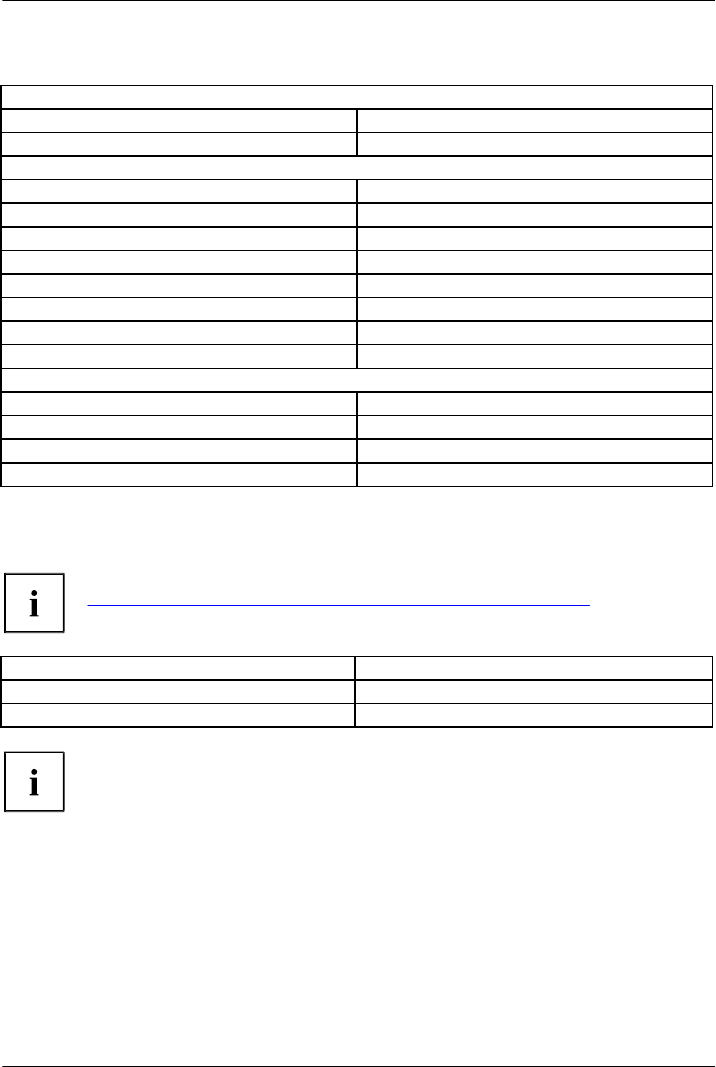
Technical data
Rechargeable battery
For information on the batteries used in your device, please see
"http://solutions.us.fujitsu.com/www/content/support/contact/index.php".
The operating time depends on the device configuration, the active
applications and the energy saving settings.
Port replicator (optional)
Electrical data
Safety regulations complied with
CE
Protection class
II
Ports
Monitor port (analog)
15-pin
Monitor port (digital)
25-pin, DVI-D
Display Port
1 x
LAN port
RJ45
USB (Universal Serial Bus)
4 x USB 3.0
Audio
Headphones port
Docking port
100-pin
Security Lock
1 x
Ambient conditions
Environment class DIN IEC 721
7K1
Mechanism class DIN IEC 721
7M2
Operating temperature
5℃ .... 35℃ / 41°F .... 95°F
Transit temperature
–15°C .... 60°C / 5°F .... 140°F
Rated voltage
14.4 V
Rated capacity
45 Wh
Rated power
3150 mAh
92 Fujitsu

Technical data
An additional AC adapter or AC cable can be ordered at any time.
AC adapter for use with notebook and port replicator
The following technical data applies to the AC adapter included in the scope of
delivery of the notebook and the optionally available port replicator.
Primary
Rated voltage
100 V to 240 V (automatic)
Rated frequency
50 Hz to 60 Hz (automatic)
Max. rated current
0.7 A to 1.2 A
Secondary
Rated power
•
65 W (adapter for notebook only)
•
90 W (adapter for port replicator only)
Rated voltage
19 V
Max. rated current
4.22 A
Fujitsu 93

Manufacturer’s notes
Manufacturer’s notes
Disposal and recycling
You can find information on this subject on your notebook or on our website
("http://solutions.us.fujitsu.com/www/content/products/trade-in_program/").
Recycling your battery
Over time, the batteries that run your mobile computer will begin to hold a charge for a
shorter amount of time; this is a natural occurrence for all batteries. When this occurs,
you may want to replace the battery with a fresh one*. If you replace it, it is important
that you dispose of the old battery properly because batteries contain materials that
could cause environmental damage if disposed of improperly.
Fujitsu is very concerned with environmental protection, and has enlisted the services of the
Rechargeable Battery Recycling Corporation (RBRC)**, a nonprofit public service organization
dedicated to protecting our environment by recycling old batteries at no cost to you.
RBRC has drop-off points at tens of thousands of locations throughout the United States and
Canada. To find the location nearest you, go to "www.RBRC.org" or call 1-800-822-8837.
If there are no convenient RBRC locations near you, you can also go to the EIA Consumer
Education Initiative website "http://EIAE.org/ " and search for a convenient disposal location.
Remember – protecting the environment is a cooperative effort, and we must
make every effort to protect it for current and future generations.
*To order a new battery for your Fujitsu mobile computer, go to the Fujitsu shopping site
at "www.shopfujitsu.com" in the US or "www.fujitsu.ca/products/notebooks" in Canada.
** RBRC is an independent third party to which Fujitsu provides funding for
battery recycling; RBRC is in no way affiliated with Fujitsu.
DOC (Industry CANADA) Notices
Radios and Television
This Class B digital apparatus meets all requirements of Canadian Interference-Causing Equipment
Regulations.
CET appareil numérique de la class B respecte toutes les exigence du Réglement
sur le matérial brouilleur du Canada.
94 Fujitsu
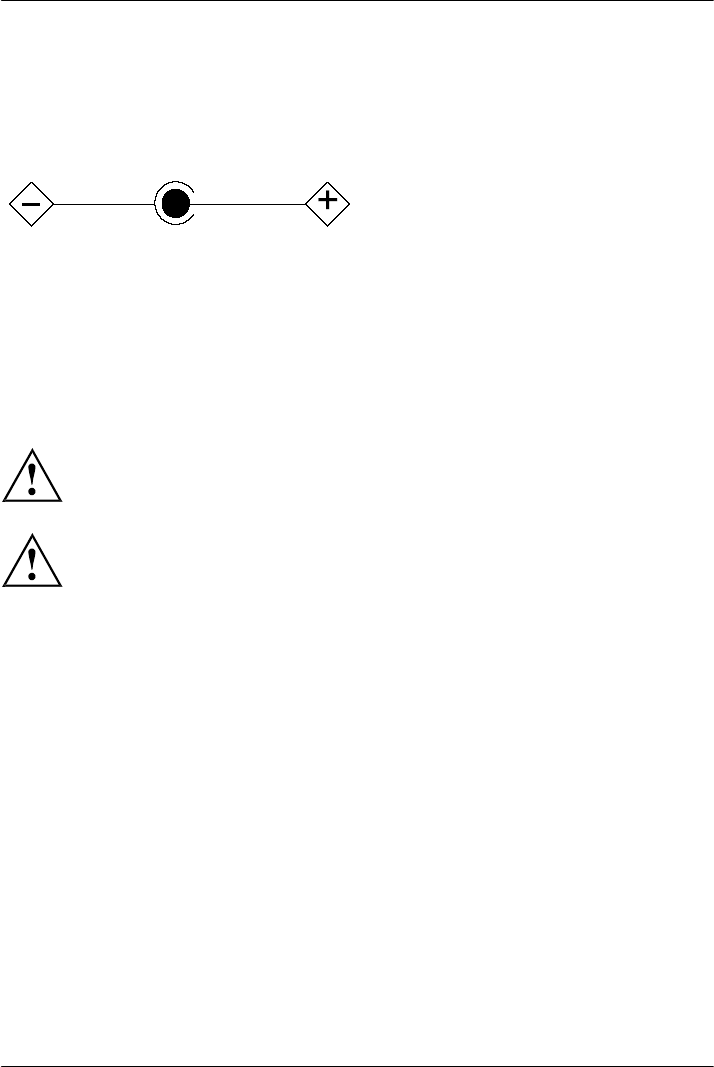
Manufacturer’s notes
UL Notice
IMPORTANT SAFETY INSTRUCTIONS
This unit requires an AC adapter to operate. Only use UL Listed I.T.E. adapters with an output rating
of 19 VDC, with a minimum current of 3.42 A (65 W). The correct output rating is indicated on the
AC adapter label. Refer to the illustration below for the correct AC adapter output polarity:
When
using your notebook equipment, basic safety precautions should always be followed to
reduce
the risk of fire, electric shock and injury to persons, including the following:
•
Do not use this product near water for example, near a bathtub, washbowl, kitchen
sink or laundry tub, in a wet basement or near a swimming pool.
•
Use only the power cord and batteries indicated in this manual. Do not dispose of batteries in a
fire. They may explode. Check with local codes for possible special disposal instructions.
SA
VE THESE INSTRUCTIONS
For
Authorized Repair Technicians Only
CAUTION:
For continued protection against risk of fire, replace only with the
same type and rating fuse.
WARNING:
Danger of explosion if Lithium (CMOS) battery is incorrectly replaced. Replace only
with the same or equivalent type recommended by the manufacturer.
Dispose of used batteries according to the manufacturer’s instruction.
Fujitsu 95

Manufacturer’s notes
ENERGY STAR Compliance
Your Fujitsu system is an ENERGY STAR qualified mobile PC. By
choosing a computer with the latest energy-saving technology, you’re
helping to preserve our environment for future generations. ENERGY
STAR is a joint program of the U.S. Environmental Protection Agency,
U.S. Department of Energy, Natural Resources Canada, and other
governments around the world helping us save money while protecting
the environment through energy efficient products and practices. With
energy costs and global warming top-of-mind for consumers, Fujitsu is
committed to offering solutions that help consumers conserve energy
and improve the quality of our environment.
Sleep mode:
You will notice that your computer is initially set so that the display turns off after 10 minutes of
user inactivity, and the computer goes into Sleep mode after 20 minutes of user inactivity. When
going into Sleep mode, the computer also reduces the speed of any active Ethernet network
links. To “wake” the computer from Sleep mode, press the Suspend/Resume Button.
Energy saving benefits:
Fujitsu ENERGY STAR qualified mobile PCs use about half as much electricity as standard
equipment – saving half in utility costs. But more than that, ENERGY STAR also makes a difference
for the environment. Did you know that the average house can be responsible for twice the
greenhouse gas emissions as the average car? That’s because every time you flip on a light
switch, run your dishwasher, or turn on your PC, you use energy, which means more greenhouse
gas emissions from power plants. So the more energy we can save through energy efficiency,
the more we help to reduce greenhouse gases and the risks of global warming.
To learn more about the important ENERGY STAR program, visit:"www.energystar.gov".
To read about how Fujitsu is supporting Sustainable Management along with
several other environmental activities, visit the Fujitsu Corporate Citizenship page at:
"http://www.computers.us.fujitsu.com/www/content/aboutus/environmental/environment.php".
96 Fujitsu

Declarations of conformity
Declarations of conformity
This device complies with Part 15 of the FCC Rules. Operations are subject to the following two
conditions: (1) This device may not cause harmful interference, (2) this device must accept any
interference received, including interference that may cause undesired operation.
Fujitsu 97

FCC and IC Regulatory Information
FCC and IC Regulatory Information
Please note the following regulatory information related to the wireless LAN
device.
Regulatory Notes and Statements
Wireless LAN, Health and Authorization for use
Radio frequency electromagnetic energy is emitted from Wireless LAN devices. The energy levels of
these emissions, however, are far much less than the electromagnetic energy emissions from wireless
devices such as mobile phones. Wireless LAN devices are safe for use by consumers because they
operate within the guidelines found in radio frequency safety standards and recommendations. The
use of Wireless LAN devices may be restricted in some situations or environments, such as:
•
On board an airplane, or
•
In an explosive environment, or
•
In situations where the interference risk to other devices or services is
perceived or identified as harmful.
In cases in which the policy regarding use of Wireless LAN devices in specific environments is
not clear (e.g., airports, hospitals, chemical/oil/gas industrial plants, private buildings), obtain
authorization to use these devices prior to operating the equipment.
Regulatory Information/Disclaimers
Installation and use of this Wireless LAN device must be in strict accordance with the instructions
included in the user documentation provided with the product. Any changes or modifications made
to this device that are not expressly approved by the manufacturer may void the user’s authority to
operate the equipment. The manufacturer is not responsible for any radio or television interference
caused by unauthorized modification of this device, or the substitution or attachment of connecting
cables and equipment other than those specified by the manufacturer. It is the responsibility of the
user to correct any interference caused by such unauthorized modification, substitution or attachment.
The manufacturer and its authorized resellers or distributors will assume no liability for any damage
or violation of government regulations arising from failure to comply with these guidelines.
This device must not be co-located or operated in conjunction with any other antenna or transmitter.
For IEEE 802.11a Wireless LAN: For operation within 5.15~5.25 GHz frequency range, it is
restricted to indoor environments, and the antenna of this device must be integral.
Federal Communications Commission and Industry
Canada statement:
This device complies with Part 15 of FCC Rules and Industry Canada license exempt RSS standard(s).
Operation is subject to the following two conditions: (1) This device may not cause
interference, and, (2) This device must accept any interference, including interference
that may cause undesired operation of this device.
98 Fujitsu

FCC and IC Regulatory Information
Déclaration d’Industrie Canada
Cet appareil est conforme à la Section 15 des Règles de la FC C et à la ( aux) norme(s)
RSS concernant les appareils exempt s de licence par Industrie Canada. Son fonctionnement
est soumis aux deux condition s suivantes : (1) cet appareil ne doit pas causer d’interférence
nuisib le; (2) cet appareil doit accepter toutes les interférences reçues, y compris celles
pouvan t causer un mauvais fonctionnement de l’appareil.
FCC Interference Statement
This equipment has been tested and found to comply with the limits for a Class B digital
device, pursuant to Part 15 of the FCC Rules. These limits are designed to provide reasonable
protection against harmful interference in a residential installation. This equipment generates,
uses, and can radiate radio frequency energy. If not installed and used in accordance with
the instructions, it may cause harmful interference to radio communications. However, there is
no guarantee that interference will not occur in a particular installation.
If this equipment does cause harmful interference to radio or television reception, which
can be determined by turning the equipment off and on, the user is encouraged to try and
correct the interference by one or more of the following measures:
1.
Reorient or relocate the receiving antenna.
2.
Increase the distance between the equipment and the receiver.
3.
Connect the equipment to an outlet on a circuit different from the one the receiver is connected to.
4.
Consult the dealer or an experienced radio/TV technician for help.
FCC Radio Frequency Exposure statement
The available scientific evidence does not show that any health problems are associated with
using low power wireless devices. There is no proof, however, that these low power wireless
devices are absolutely safe. Low power wireless devices emit low levels of radio frequency
energy (RF) in the microwave range while being used. Whereas high levels of RF can produce
health effects (by heating tissue), exposure to low-level RF that does not produce heating
effects causes no known adverse health effects. Many studies of low-level RF exposure have
not found any biological effects. Some studies have suggested that some biological effects
might occur, but such findings have not been confirmed by additional research.
The wireless LAN radio device has been tested and found to comply with FCC radiation
exposure limits set forth for an uncontrolled equipment and meets the FCC radio frequency
(RF) Exposure Guidelines in Supplement C to OET65.
The exposure standard for wireless devices employs a unit of measurement known as the Specific
Absorption Rate, or SAR. The SAR limit set by the FCC is 1.6W/kg, and 1.6W/kg by Industry Canada.
This device is compliant with SAR for general population /uncontrolled exposure limits in
ANSI/IEEE C95.1-1992 and Canada RSS 102, and had been tested in accordance with
the measurement methods and procedures specified in OET Bulletin 65 Supplement C,
and Canada RSS 102. This device has been tested, and meets the FCC, IC RF exposure
guidelines when tested with the device operating conditions.
Fujitsu 99

FCC and IC Regulatory Information
Déclaration de la FCC/d’Industrie Canada sur
l’exposition aux radiofréquences
La norme régissant l’exposition des appareils sans fil aux radiofréquences emploie une unité de
mesure dénommée Taux d’absorption spécifique, ou TAS. La FCC et Industrie Canada ont défini
la même limite de TAS : 1,6 W/kg. Cet appareil est conforme au TAS pour les limites
d’exposition générales de la population/non contrôlées définies par les règles C95.1-1992 de
l’ANSI/IEEE et RSS 102 d’Industrie Canada ; il a été testé en conformité avec les méthodes
et procédures de mesure spécifiées dans le supplément C du bulletin 65 de l’OET (Office
d’ingénierie et de technologie) et la règle RSS 102 d’Industrie Canada. Cet appareil a été testé
selon les directives de la FCC et d’IC concernant l’exposition aux radiofréquences et s’est révélé
conforme à ces dernières lorsqu’il a été testé en contact direct avec le corps.
Export restrictions
This product or software contains encryption code which may not be exported or transferred
from the US or Canada without an approved US Department of Commerce export license.
This device complies with Part 15 of FCC Rules., as well as ICES 003 B / NMB 003 B.
Operation is subject to the following two conditions: (1) this device may not cause harmful
interference, and (2) this device must accept any interference received, including interference
that may cause undesirable operation. Modifications not expressly authorized by Fujitsu
America, Inc. may invalidate the user’s right to operate this equipment.
Restrictions concernant l’exportation
Ce produit ou logiciel contient du code de chiffrement qui ne peut être exporté ou transféré du
Canada ou des États-Unis sans un permis d’exportation du département du commerce des
États-Unis. Ce matériel est conforme à la Partie 15 des règlements de la FCC, ainsi qu’à la
norme ICES 003 B/NMB 003 B. Son fonctionnement est soumis aux deux conditions suivantes
: (1) cet appareil ne doit pas causer d’interférence nuisible; (2) cet appareil doit accepter
toutes les interférences reçues, y compris celles pouvant causer un mauvais fonctionnement de
l’appareil. Toute modification n’ayant pas été expressément approuvée par la société Fujitsu
America Incorporated peut annuler le droit de l’utilisateur de se servir du matériel.
Canadian Notice
The device for the 5150 - 5250 MHz band is only for indoor usage to reduce the potential
for harmful interference to co-channel mobile satellite systems.
The maximum antenna gain of 6 dBi permitted (for devices in the 5250 - 5350 MHz, 5470 - 5725
MHz and 5725 - 5825 MHz bands) to comply with the e.i.r.p. limit as stated in A9.2 of RSS210.
In addition, users are cautioned to take note that high power radars are allocated as primary
users (meaning they have priority) of 5250 - 5350 MHz and 5650 - 5850 MHz and these
radars could cause interference and/or damage to LE-LAN devices.
100 Fujitsu

FCC and IC Regulatory Information
Avis pour le Canada
Le matériel destiné à un usage sur la bande 5 150 - 5 250 MHz doit être utilisé
uniquement à l’intérieur afin de réduire les risques de brouillage nuisible causé aux
systèmes mobiles par satellite fonctionnant sur un même canal.
Un gain d’antenne de 6 dBi est autorisé (pour le matériel utilisant les bandes 5 250 - 5 350
MHz, 5 470 - 5 725 MHz et 5 725 - 5 825 MHz), conformément à la limite p.i.r.e. maximale
permise selon l’annexe A9.2 afférent aux périphériques RSS210.
En
outre, les utilisateurs doivent prendre garde au fait que les radars de grande puissance
sont
considérés comme des utilisateurs principaux (ce qui signifie qu’ils sont prioritaires) des
bandes
5 250 - 5 350 MHz et 5 650 - 5 850 MHz et qu’ils pourraient causer des interférences
et/ou
des dommages aux appareils de réseau exempts de licence.
Fujitsu 101

Appendix
Appendix
Before Using the Optional Wireless LAN
This manual describes the procedures required to properly set up and configure the optional
integrated Wireless LAN Mini-PCI device (referred to as "WLAN device" in the rest of the
manual). Before using the WLAN device, read this manual carefully to ensure its correct
operation. Keep this manual in a safe place for future reference.
Wireless LAN Devices Covered by this Document
This document is applicable to systems containing the following device:
•
Intel® Dual Band Wireless-AC 8260
Characteristics of the WLAN Device
•
The WLAN devices are PCI Express Mini cards attached to the main board of the mobile computer.
•
The WLAN devices operate in license-free RF bands, eliminating the need to procure
an FCC operating license. The WLAN operates in the 2.4GHz Industrial, Scientific,
and Medical (ISM) RF band and the lower, middle, and upper bands of the 5GHz
Unlicensed National Information Infrastructure (UNII) bands.
•
The WLAN devices are capable of five operating modes, IEEE802.11a, IEEE802.11ac,
IEEE802.11b, IEEE802.11g, and IEEE802.11n.
•
The WLAN device is Wi-Fi certified and operates (as applicable) at the maximum data rate
of 867 Mbps in IEEE802.11ac mode, 450 Mbps in IEEE802.11n mode (300 Mbps in this
configuration); 54 Mbps in IEEE802.11g mode; and 11 Mbps in IEEE802.11b mode.
•
The WLAN devices support the following encryption methods - WEP,
TKIP, CKIP, and AES encryption.
•
The Wireless LAN devices are compliant with the following standards: WPA,
WPA2, CCX1.0, CCX2.0, CCX3.0, and CCX4.0.
Wireless LAN Modes Using this Device
Ad Hoc Mode
"Ad Hoc Mode" refers to a wireless network architecture where wireless network connectivity
between multiple computers is established without a central wireless network device, typically
known as Access Point(s). Connectivity is accomplished using only client devices in a peer-to-peer
fashion. That is why Ad Hoc networks are also known as peer-to-peer networks. Ad Hoc
networks are an easy and inexpensive method for establishing network connectivity between
multiple computers. Ad Hoc mode requires that the SSID, network authentication, and encryption
key settings are identically configured on all computers in the Ad Hoc network.
102 Fujitsu
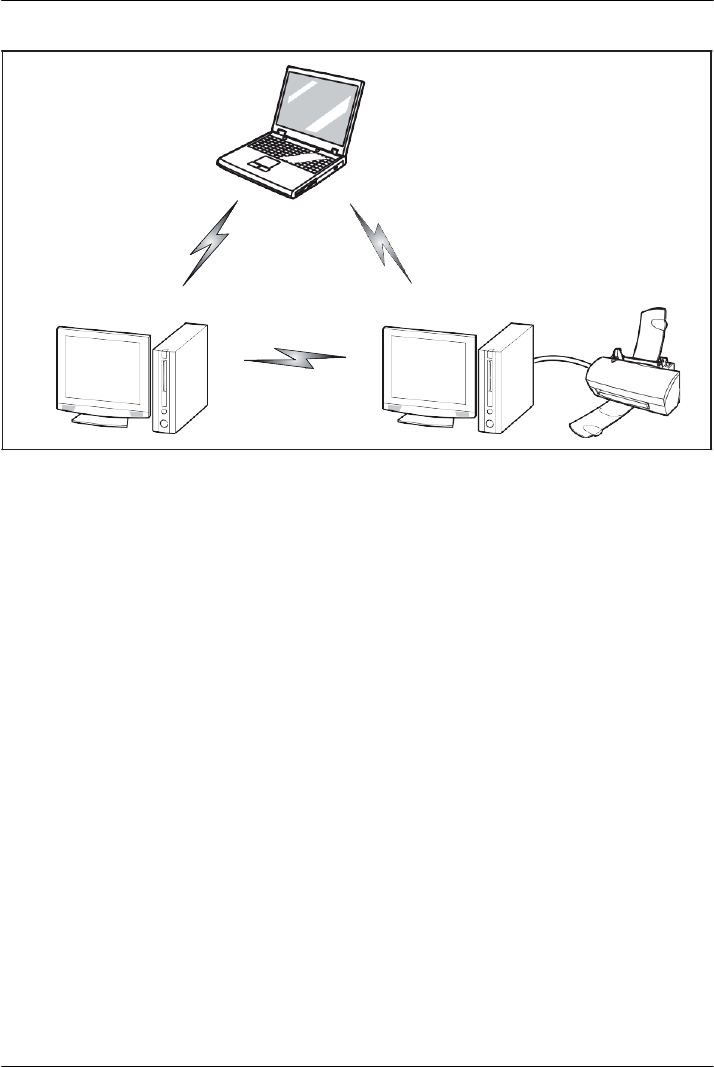
Appendix
Access
Point (Infrastructure) Mode
Infrastructure
mode refers to a wireless network architecture in which devices communicate with
wireless
or wired network devices by communicating through an Access Point. In infrastructure
mode,
wireless devices can communicate with each other or with a wired network. Corporate
wireless
networks operate in infrastructure mode because they require access to the WLAN in
order
to access services, devices, and computers (e.g., file servers, printers, databases).
Fujitsu 103
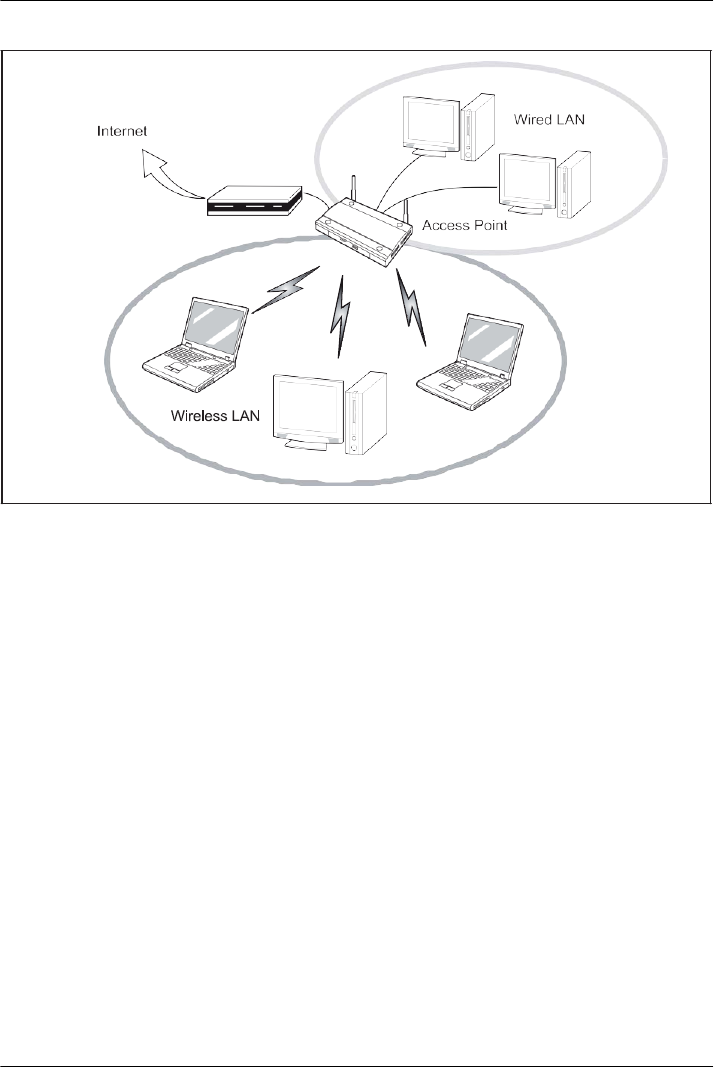
Appendix
* = An optional hub for a wired LAN may
be required depending upon the type
of access point used.
** = ADSL modem, cable modem, or similar
How to Handle This Device
The WLAN device is an optional device that may come pre-installed in your mobile computer. Under
normal circumstances, it should not be necessary for you to remove or re-install it. The Operating
System that your mobile computer comes with has been pre-configured to support the WLAN device.
•
Integrated Intel Centrino wireless LAN devices support IEEE802.11a, IEEE802.11ac,
IEEE802.11b, IEEE802.11g, and IEEE802.11n.
•
The WLAN device operates in the 2.4 GHz ISM band and the 5 GHz
lower, middle, and upper UNII bands.
•
Microwave ovens may interfere with the operation of WLAN devices since they operate in the
same 2.4 GHz frequency range as IEEE802.11b/g/n devices. Interference by microwaves
does not occur with IEEE802.11a radio which operates in the 5 GHz RF band.
•
Wireless devices that transmit in the 2.4 GHz range may interfere with operation of WLAN
devices in IEEE802.11b/g/n modes. Symptoms of interference include reduced throughput,
intermittent disconnects, and many frame errors. It is HIGHLY recommended that these
interfering devices be powered off to ensure proper operation of the WLAN device.
**
*
104 Fujitsu

Appendix
F5
Deactivating/Disconnecting the WLAN Device
Disconnecting the WLAN device may be desired in certain circumstances (to extend battery
life) or where certain environments require it (i.e. hospitals, clinics, airplanes, etc.). The
WLAN device can be disconnected in Windows using the WLAN icon in the system tray
(Note that disconnecting via the icon in the system tray does not turn off the radio; it
continues to transmit and receive even though it’s not connected.)
►Press the key combination
+
to deactivate the Wireless Device
4 The wireless component indicator will go off when the wireless components are switched off.
Configuring the Wireless LAN
The optional WLAN device can be configured to establish wireless network connectivity
using the software that is built into Windows. Support for most industry standard
security solutions is contained in this software.
Pre-defined parameters will be required for this procedure. Please consult with
your network administrator for these parameters:
Configuring the WLAN Using Windows
The WLAN device can be configured to establish wireless network connectivity using
the software that is built into Windows Vista. Support for most industry standard
security solutions is contained in this software.
Pre-defined parameters are required for this procedure. Consult your network
administrator for these parameters:
1.
From the Modern Start screen, press Windows + X , then select Control Panel from the menu.
2.
If the Control Panel is not in Classic View, select Classic View from the left panel.
Double-click the Network and Sharing Center icon.
3.
Select Setup a new connection or network.
4.
Depending upon what type of connection you would like to make, make a selection. For
an infrastructure network, select Manually connect to a wireless network.
5.
Enter the required information. It may be necessary to consult with your network
administrator for some of the information.
6.
In the event you require assistance, go to the Network and Sharing Center window (Control
Panel > Network and Sharing Center), and type in relevant keywords in the Search box.
Connection to the network
After you have configured your computer, you can connect to an active network
by performing the following steps:
1.
Click on the WLAN icon in the system tray.
2.
Select Connect to a network.
3.
Select a network from the list that appears, and click the Connect button.
Fn
Fujitsu 105

Appendix
Troubleshooting the WLAN
Causes and countermeasures for troubles you may encounter while using your
wireless LAN are described in the following table.
Problem
Possible Cause
Possible Solution
Unavailable network connection
Incorrect network name (SSID)
or network key
Ad hoc connection: verify that
the network names (SSID’s)
and network keys (WEP) of
all computers to be connected
have been configured correctly.
SSID’s and WEP key values
must be identical on each
machine.
Access Point (Infrastructure)
connection: set the network
name (SSID) and network key
to the same values as those of
the access point.
Set the Network Authentication
value identically to that of the
Access Point. Please consult
your network administrator for
this value, if necessary.
Weak received signal strength
and/or link quality
Ad hoc connection: Retry
connection after shortening
the distance to the destination
computer or removing any
obstacles for better sight.
Access Point (Infrastructure)
connection: Retry connection
after shortening the distance to
the access point or removing
any obstacles for better sight.
106 Fujitsu

Appendix
Problem
Possible Cause
Possible Solution
Unavailable network connection
(continued)
The WLAN device was
deactivated or is disabled
Check if the wireless switch is
turned On. Go to Start >
Control Panel, and doubleclick
on Windows Mobility Center. If
the wireless network is off, click
the Turn wireless on button.
The computer to be connected
is turned off
Check if the computer to be
connected is turned ON.
Incorrectly configured network
settings
Recheck the configuration of
your network settings.
RF interference from Access
Points or other wireless
networks
The use of identical or
overlapping RF channels can
cause interference with the
operation of the WLAN device.
Change the channel of your
Access Point to a channel
that does not overlap with the
interfering device.
Wireless network authentication
has failed
Re-check your Network
Authentication, Encryption,
and Security settings.
Incorrectly configured
security settings such as an
incorrectly typed WEP
key, a mis-configured LEAP
username, or an incorrectly
chosen authentication method
will cause the LAN device to
associate but not authenticate
to the wireless network.
Incorrect IP address
configuration
This only applies to networks
using static IP addresses.
Please contact your network
administrator for the correct
settings.
Fujitsu 107

Appendix
Using the Bluetooth Device
Bluetooth is integrated into the Wireless LAN module. The Bluetooth capabilities are Bluetooth
Basic, EDR and Bluetooth Low Energy (BT v4.0) operational modes.
What is Bluetooth
Bluetooth technology is designed as a short-range wireless link between mobile devices, such
as laptop computers, phones, printers, and cameras. Bluetooth technology is used to create
Personal Area Networks (PANs) between devices in short-range of each other.
Proceed as follows to individually enable or disable wireless LAN or Bluetooth devices:
1.
Switch on the WLAN/Bluetooth via the key combination + F5 .
2.
In the screen Modern Start, select the option Charms > Settings
> Change PC Settings > Wireless.
3.
Under Wireless > Wireless Devices, click on the switch Bluetooth to switch on Bluetooth.
Where to Find Information About Bluetooth
For additional information about Bluetooth Technology, visit the Bluetooth
Web site at: "www.bluetooth.com".
FCC Radiation Exposure Statement
This system complies with the FCC limit values for radio frequency radiation in an uncontrolled
environment. The Bluetooth antenna is located at the top edge of the LCD screen and is exempt
from the criteria for minimum distance because of its low power consumption.
The transmitter used in this system must not be operated together with other antennas or transmitters.
Canadian Notice
To prevent radio interference to licensed services, this system is designed for use in indoor spaces
/ in buildings and not directly at window openings, to allow a maximum shielding.
Warranty
Users are not authorized to modify this product. Any modifications invalidate the warranty.
This equipment may not be modified, altered, or changed in any way without signed
written permission from Fujitsu. Unauthorized modification will void the equipment
authorization from the FCC and Industry Canada and the warranty.
Image Backup and Recovery Procedures
Thank you for purchasing a Fujitsu computer. Fujitsu is committed to bringing you
the best computing experience with your new system.
It is very important that you create DVD copies of your Recovery Image and Bootable Disk
before beginning to use your system. To do so, follow the instructions in the “Creating a
Backup of Bootable Disk and Recovery Image” section of this document.
It is also important that you create a copy of the software that is essential for your system to access the
internet (hereafter called “essential access software”) to external writable media or an external drive.
To do so, follow the instructions in the “Creating a Backup of the System-Specific Software Drivers”.
Fn
108 Fujitsu

Appendix
Creating a Backup of Bootable Disk and Recovery Image
When you purchased your new system, a copy of the recovery image was loaded into a
hidden partition on your hard disk drive. Having a copy of the recovery image available to
you means that in the event of system failure, you will be able to restore it and re-install
the essential access software using Fujitsu Software Auto Installer.
To make a copy of the recovery image to DVD disks, you will need three or four blank
disks to create the copy. After creating the copy, be sure to label the disks and keep
them in a safe place to ensure they do not get damaged.
Note: If your system does not have an internal writable DVD drive, connect your
system to an external drive* before beginning the following steps.
1.
Launch System Restore and Recovery from the desktop icon. It will allow you to create
the Bootable Disk and the Recovery Image Disk Set.
2.
On “Step 1: Select the Bootable Disk from the list”:
a.
Select a media type.
b.
Notice the number of disks that are needed for the set.
c.
Click Next to proceed.
3.
On “Step 2: Confirm your Recovery Disk”, click Next.
4.
On “Step 3:” follow the on-screen instructions to make the disk or disk set, then click
Start. It takes approximately 20 minutes to make one disk.
5.
On “Step 4”, when the disk creation is completed, a message appears.
Click Finish to exit the program.
6.
Repeat Step 1: Select Recovery Disk from the list and repeat the above
steps 2(a), 2(b), 2(c), 3, 4 and 5.
*DEPENDING UPON YOUR OPTICAL DRIVE AND MEDIA FORMAT USED, SOME MEDIA
TYPES MAY BE INCOMPATIBLE FOR CREATING IMAGE BACKUPS.
Fujitsu 109

Appendix
Creating a Backup of Essential Access Software
When you purchased your new system, a “Fujitsu Software Extractor” shortcut was loaded to
“C:\Fujitsu\Drivers\AutoInstaller\”. This shortcut allows you to save the software driver packages
along with the extracted Auto Installer software package to a selected location. It is recommended
that you save these packages to writable media or an external drive. This ensures that in the
event of system failure you will be able to re-install the essential access software.
1.
Open the C:\Fujitsu\Drivers\AutoInstaller\ folder
2.
Run “Fujitsu Software Extractor” as an Administrator
a.
Right-click on Fujitsu Software Extractor.
b.
Select the “Run as Administrator” option from the menu that is displayed.
3.
The default save location is C:\Fujitsu\ AutoInstaller\ Drivers\. You can change the location
by clicking on the Browse button and selecting your preferred location.
Note: It is recommended that you change the default location and save the
software packages to the external writable media or drive.
4.
Click on the Save Packages button.
5.
Fujitsu Software Extractor copies the zipped software packages and Readme files,
and extracts the Auto Installer folder to the selected location.
Note: The extracted Auto Installer will later be used to install the software
automatically on the system in the event of generic image restoration when
the software is not pre-installed in the image.
RECOVER YOUR SYSTEM WHEN THE HARD
DRIVE IS STILL ACCESSIBLE
Using the Recovery and Utility Tools
The Recovery and Utility tools consist of a variety of tools that will help you recover your
recovery image and system images, and delete the data from your hard disk.
Methods for accessing the utilities
Recovery and Utility Tools are preinstalled in a hidden partition by the factory, or
they can be accessed by using the bootable disk.
Note: The Recovery and Utility tools may be deleted from your hard disk
drive if you modify the partitions. If that occurs, you will not be able to
use the hidden partition for booting to Recovery and Utility Tools, but you
will still be able to boot from the Bootable Disk.
110 Fujitsu

Appendix
Enter
Determining whether Recovery and Utility is pre-loaded
1.
Turn on or reboot your system. When the Fujitsu logo appears, press the key.
2.
Use the key to get to the Application Menu.
3.
Check whether the Recovery and Utility option is present. If it is not present, it means
that the utility must be used from the Bootable Disk. Proceed to “Running Recovery and
Utility from the Bootable Disk” if Recovery and Utility is unavailable.
Running Recovery and Utility from hard disk
1.
Turn on or reboot your system. When the Fujitsu logo appears, press the key.
2.
Use the key to get to the Application Menu.
3.
Cursor down to Recovery and Utility and press the key.
4.
Choose your language, if necessary. Select Recovery and Utility to proceed.
5.
Three tool options appear: Diagnostics, Recovery, and Utility (refer to the Recovery and
Utility tools section below for instructions on how to use these tools).
6.
If this was successful please skip the next step and go to “Recovery and Utility tools.”
7.
If this was NOT successful, please go to the next step.
Running Recovery and Utility from the Bootable disk
To verify/change the boot-up priority (rather than booting-up from the hard drive or
an external media drive), perform the following steps:
1.
Power on your system. When the Fujitsu logo appears on the screen, press the
2.
Insert the bootable disk into the drive tray.
3.
Highlight the CD/DVD option from the Boot menu, then press Enter .
4.
Click OK.
key.
5.
Select CD/DVD boot mode: UEFI Mode, if applicable, and then press .
While the files are being loaded from the disk, the Fujitsu logo screen will appear
followed by a progress bar at the bottom of the screen.
F12
Tab
F12
Tab
Enter
F12
Fujitsu 111

Appendix
Recovery and Utility tools
Note: Recovery and Utility tools may not be available on your system depending
on the region from which the system was shipped.
Diagnostics tool: The Diagnostics tool is designed for use by IT professionals. It is not likely you
will need to use this tool. If you should need to use this tool, perform the following steps:
1.
Press the Diagnostics Tool button to start the Diagnostics tool.
2.
Read the note, and then click OK.
3.
Choose one or more of the following options for diagnostics on the Fujitsu Hardware Diagnostics
Tool window: CPU, Memory, Display, Hard Disk, CD/DVD/BD, Floppy Disk, Keyboard, and Mouse.
4.
Click the Option button in the Tool menu to specify how many times the tool
should run diagnostics on each selected component.
5.
Press Execute to start the Diagnostics tool.
6.
After the execution is completed, the selected components are circled in red to indicate that they
have been diagnosed and the result dialog window opens. Click Close to close the window.
7.
Click End to close the Diagnostics tool, and then click Yes to confirm the end of diagnostics session.
Recovery tool: The Recovery tool contains two options:
•
Restore C Drive: Restore recovery image (only C: drive)
•
Restore Full Hard Drive: Restore recovery image (full hard drive).
You can use these tools to restore the Recovery Image from the hidden partition, and perform a full
hard drive recovery. Please refer to instructions above for details on how to create a Recovery Image.
Restore the Recovery Image from Hidden Partition
1.
Click [Restore C: drive] from Recovery and Utility tools
2.
The progress bar is followed by “Restore Recovery image (only C: drive)” screen
confirming that the Image will be restored to the C: drive. Click Next.
3.
Read the instruction screen and select Agree, then click Next.
4.
Click OK to acknowledge the warning message to restore recovery image to the C: drive.
5.
When the progress bar appears, wait for the process to complete.
6.
Click Finish when the process completes; the computer will restart to Windows.
7.
Follow the steps listed in the “Auto Installation support for software packages
from hidden partition” section.
8.
Download FSDM (Fujitsu Software Download Manager) from the support site and download
all the software applicable to the model and OS using FSDM.
9.
Follow the steps listed in “Auto Installation support for software packages
downloaded from support website” section.
112 Fujitsu

Appendix
RECOVER YOUR SYSTEM WHEN THE HARD
DRIVE IS NOT BOOTABLE
Restore the Recovery Image for Full Hard Drive
Follow the steps in the “Recovering your Recovery Image using Recovery and
Utility (for new hard drive or non-bootable hard drive)” section. You will need the
Bootable Disk and the Recovery Disk Set for this task.
Utility tool: If applicable for your region, the Utility tool contains two options:
Hard Disk Data Delete and Partition Creation.
The Hard Disk Data Delete utility is used to delete all data on the hard disk
and prevent the data from being reused.
NOTE: Do not use the Hard Disk Data Delete utility unless you are absolutely certain
that you want to erase your entire hard disk, including all partitions.
To delete hard disk data:
1.
Click the Hard Disk Data Delete button. The progress bar appears, followed by the EULA screen.
2.
Agree to the EULA and click Next.
3.
Choose the hard disk from which the data should be deleted in the list of hard disks and click Next.
The Partition Creation utility is used to change the C: and D: drive partition sizes.
To run this utility: (This is not an option when using Windows 7.)
1.
Click the Partition Creation button.
2.
A progress bar appears, followed by the EULA screen. Agree to the EULA.
3.
On the Recovery Tool - Partition Creation screen, move the slider to set disk size, and then click OK.
4.
Click Yes in the Partition Creation confirmation dialog.
WARNING: It is highly recommended that you send your product to Fujitsu
Service to replace a hard drive. A mistake could possibly destroy your
computer, your new hard drive or both.
Fujitsu 113

Appendix
Recovering Your Recovery Image Using Recovery and Utility
(for new hard drive or non-bootable hard drive)
If you have installed a new hard drive or your hard drive is not bootable, perform the following steps.
Note: You will need the Bootable disk and Recovery Image disk set for this recovery.
1.
Power on your system. When the Fujitsu logo appears on the screen, press the
2.
Insert the bootable disk in your DVD drive, then click OK.
3.
Highlight the CD/DVD option from the Boot Menu and press Enter .
4.
Select CD/DVD boot mode: Select UEFI Mode, if applicable and press Enter .
While the files are being loaded from the disk, the Fujitsu logo screen appears
followed by a progress bar at the bottom of the screen.
5.
Choose your language, if necessary.
6.
Three tool options appear: Diagnostics, Recovery and Utility. Select Recovery.
•
For Windows 8.1: Select Restore full hard drive
•
For Windows 7: Select Restoring the Factory Image (full hard drive recovery)
7.
Click Next to confirm full hard drive restoration. All data on HDD will be deleted.
8.
Agree to EULA by selecting Agree option and clicking Next.
9.
Click Next on the Recovery Disk Check screen to verify that the bootable
disk has been inserted into the optical drive.
10.
The Checking for Recovery Disk screen appears followed by the prompt to insert the
first disk. Click OK to continue. Repeat this step for all disks. After all recovery disks
have been checked and the check has been completed, click Next.
11.
Follow the prompt to reinsert the first recovery disk and click Next.
12.
Click OK when you receive the final warning informing you that all data on drive
C will be lost. This starts the recovery process.
13.
Follow the prompts to insert the next recovery disks and click OK.
14.
After the copying of the image to the HDD completes the restore process is
complete, click Finish to restart the system. The computer will restart automatically
and then go through the first boot process.
15.
Follow the steps listed in “Auto Installation support for essential access
software from backup location” section.
key.
16.
Download FSDM (Fujitsu Software Download Manager) from support site and download
all the software applicable to the model and OS using FSDM.
17.
Follow the steps listed in “Auto Installation support for essential access
software downloaded from support website.
Enter
114 Fujitsu

Appendix
Installing the Software after the Recovery Image is Restored
Auto-installation support for essential access software
from hidden partition
The below listed steps are applicable only in cases in which the recovery image restore
and hidden partition contents have not been wiped out.
1.
After the recovery image is restored, launch the desktop icon “Fujitsu Software Auto Installer”.
2.
Double-click on “Fujitsu Software Auto Installer” desktop icon.
3.
Click Yes on User Account Control Dialog box. This will take some time to
process the software packages. A message will be displayed during this time,
“Please wait while the content is being processed”.
4.
If EULA is displayed for Fujitsu Software Auto Installer, accept the EULA, otherwise continue.
5.
Then Fujitsu Software Auto Installer user interface will be launched providing ability
to auto-install the essential access software on the system.
6.
It is recommended that you install all the software in the listed order. You can
Select All, to install the software in the order listed.
7.
Click Install to start the installation.
8.
After installing all the selected drivers, Installation Results window will be displayed. Click OK.
9.
“You must restart the system for the settings to take effect. Do you wish to
reboot now?” message appears. Select Yes.
10.
The system will now reboot.
11.
You can now connect to the internet and download FSDM (Fujitsu Software Download
Manager) from the support site and download all the software applicable to the
model and OS using FSDM if they are not downloaded yet.
Fujitsu 115

Appendix
Auto-installation support for essential access software
from backup location
The below listed steps are applicable in cases in which a backup copy was created as
mentioned in the section “Creating a Backup of essential access software”.
1.
It is important to have the extracted Auto installer software package folder
and Readme file in the same location as other software folders. Otherwise
auto-installation of the software will not be supported.
2.
Inside the Auto Installer software package, launch FjAutoinstall.exe as an Administrator.
3.
Click Yes on the User Account Control dialog box. This will take some time to
process the software packages. A message will be displayed during this time stating,
“Please wait while the content is being processed”.
4.
If EULA is displayed for Fujitsu Software Auto Installer, accept the EULA, otherwise continue.
5.
The Fujitsu Software Auto Installer user interface will be launched providing ability
to auto install the essential access software on the system.
6.
It is recommended that you install all the software in the listed order. You can
“Select All”, to install the software in the order listed.
7.
Click the Install button to start the installation.
8.
After installing all the selected drivers, Installation Results window is be displayed. Click OK.
9.
“You must restart the system for the settings to take effect. Do you wish to
reboot now?” message appears. Select Yes.
10.
The system will now reboot.
Auto Installation support for the software downloaded from support website
1.
Download FSDM (Fujitsu Software Download Manager) from the support site and download all
the drivers applicable to the model and OS using FSDM if they are not downloaded yet.
2.
When the software packages are downloaded from web, it is important to download
the Auto Installer Software package and the model/language- specific Readme
file if you prefer to auto install the software.
3.
It is important to have the extracted Auto Installer software package folder
and Readme file in the same location as other software folders. Otherwise
auto-installation of the software will not be supported.
4.
Inside the Auto Installer software package, launch FjAutoinstall.exe as administrator.
5.
Click Yes on the User Account Control dialog box. This will take some time to
process the software packages. A message will be displayed during this time stating
“Please wait while the content is being processed”.
6.
If EULA is displayed for Fujitsu Software Auto Installer, accept the EULA, otherwise continue.
7.
The Fujitsu Software Auto Installer user interface will be launched providing the ability
to auto install the software downloaded from support site.
8.
It is recommended that you install all the software in the listed order. You can
Select All, to install the software in the order listed.
9.
Click the Install button to start the installation.
10.
After installing all the selected drivers, the Installation Results window is displayed. Click OK.
11.
“You must restart the system for the settings to take effect. Do you wish to
reboot now?” message appears. Select Yes.
12.
The system will now reboot.
116 Fujitsu

Appendix
Downloading Driver Updates
To ensure that you always have the most current driver updates related to your system,
you should occasionally access the Fujitsu Software Download Manager (FSDM) utility.
The FSDM utility is available from the Fujitsu Support site. FSDM will allow you to view
and download a list of the most current drivers, utilities, and applications to determine
whether you have the latest versions. To download the FSDM Utility, go to the Support Site:
"http://support.fujitsupc.com/CS/Portal/support.do?srch=DOWNLOADS".
If you are planning on downgrading, upgrading or changing versions of your operating system during
this
process please see the User’s Guide for more information at "http://solutions.us.fujitsu.com".
Fujitsu 117

Index
Index
A
A beep sounds every second 82
AC adapter
connecting 19
Set up 19
Acoustic warnings 87
Activate
keyboard backlight 44
Alt+Tab 45
Anti-theft protection 66
Audio connections 76
B
Back tab 45
Backspace 42
Backspace key 42
Battery 48
battery charge 52
Caring for and maintaining 48
charge level 48
Charging 48
Discharges too quickly 86
see Rechargeable battery 48
Self-discharge 48
Service life 48
Storing 48
battery charge meter 48
BIOS Setup Utility
, protecting with password 67
calling 78
exiting 80
operation 79
Settings 78
Blank LCD screen 82
Bluetooth
switching module off 56, 105
switching module on 56, 105
Bluetooth, Safety notes 14
Bonus Apps 21
C
Caps Lock 42
Caps Lock key 42
Charge capacity, battery 48
Charging back-up battery 82
Choose a location 19
Clickpad 39, 44
buttons 39
Deactivating 44
Dragging items 40
Executing commands 39
Moving the pointer 39
Selecting an item 39
Clickpad buttons 44
Components
Installing/Removing 77
Configuration, BIOS Setup Utility 78
Configuring hardware 78
Configuring system 78
Connecting audio devices 76
Connecting headphones 76
Ctrl+Alt+Del 45
Cursor control 42
Cursor keys 42
D
Date not correct 82
Deactivate
keyboard backlight 44
Declarations of conformity 97
Display orientation
select 29
DOC (INDUSTRY CANADA) NOTICES 94
E
Ending
energy saving mode 85
Energy
Energy consumption 52
Energy saving 14
Energy saving functions 52
Enter 42
Enter key 42
Error messages on the screen 87
Errors
Acoustic warnings 87
Screen messages 87
Ethernet LAN 58
F
Fault
Elimination 81
Fingerprint sensor 66
configuring 66
First-time setup 18
Fn key 42
Fn+F10 45
Fn+F2 44
Fn+F3 44
118 Fujitsu

Index
Fn+F4 44
Fn+F5 44
Fn+F6 44
remains blank 83
unstable image 83
Monitor connection
see VGA socket 73
G
Getting started 18
H
HDMI port 72
I
Important notes 13
In case of service 77
Incorrect time 82
Information,
safety 13
K
Kensington Lock Cable 66
Key combinations 43
Keyboard 41
keys 41
L
Landscape format
display 29
LCD screen
Decrease brightness 44
difficult to read 83
Notes 32
reflected glare 83
Remains blank 82
Line feed 42
M
Making ready to use 19
Mechanical security 66
Memory card
handling 53
inserting 53
removing 54
Microphone 54
Mobile operation 15
Monitor
connection 73
no image 83
N
Notebook
before traveling 15
does not start 84
not working 85
operating 22
switching off 30
transporting 15
Notebook: switching on 25
Notes 13
disposal / recycling 94
Energy saving 14
LCD screen 32
Transport 15
Num Lock
indicator 43
Number keypad 41
Numeric keypad 41
see Virtual number keys 43
O
Operating system
activating system protection 68
cancel system protection 68
Protecting with password 68
Operation, notebook 22
P
Packaging 18
Password
changing 68
entering 67
removing 68
Password protection 67
Pen 36
Port replicator
Ports 59
Portrait format
display 29
Ports
Port replicator 59
Power saving 14
Power-on indicator 25
Printer does not print 85
Problem solving 81
Fn+F7
44
Fn+F8
44
Fn+F9
44
Fujitsu 119

Index
R
Radio components
Safety notes 14
Rechargeable battery
see battery 48
Return 42
S
Safety information 13
Screen brightness
Decrease 44
Increase 44
Screen connection
see VGA socket 73
Security functions 64
Smart Card 69
SystemLock 69
Self-discharge, battery 48
Service life, battery 48
Set up
Device 19
Setup
see BIOS Setup Utility 78
Shift 42
Shift key 42
Shift+Tab 45
Slot
Memory cards 53
Speaker 54
Status indicators 22
Subwoofer 54
Supervisor password
change 68
entering 67
removing 68
Suspend/Resume button 25
Switch off
speakers 44
Switch on
speakers 44
Switching between screen outputs 45
Switching on for the first time 20
Symbols
Indicators 22
System settings, BIOS Setup Utility 78
T
Tab key 42
The wireless connection to a network
does not work 85
Time not correct 82
Tips 81
TPM 71
Transport 15
Damage during transportation 18
Traveling, notebook 15
Troubleshooting 81
Trusted Platform Module 71
U
UMTS 57
antenna 57
USB charging function 75
USB ports 74
User password
change 68
entering 67
removing 68
Using the security lock 66
V
VGA socket 73
Virtual number keys 43
Volume
increase 44
reduce 44
Volume control 54
W
Webcam 47
Windows key 42
Winter time 82
Wireless components 44
Wireless LAN
Safety notes 14
switching module off 56, 105
switching module on 56, 105
Wrong date/time 82
120 Fujitsu